By Anne Farndale
Dedicated to my dearest grandchildren, Jamie and Sarah.
This was a very long time before you were born.
“A cluster of Summer trees,
a glimpse of the sea,
A pale evening moon.”
Kobori Enshiu
Chapter Illustrations were drawn by Anne Farndale. All the photographs were taken by Anne and Martin, during their travels at the time.
Preface
I was exceptionally lucky with my opportunities for travel, initially with my parents, then with my job in the Foreign Office, and later as an army wife. This is not intended to be a travel book in the ordinary sense, but simply a collection of word pictures of places far and near between 1946 (when I was 18) and 1962 (when I was 34). It is a snapshot album to thumb through on a warm summer’s day. It is an attempt to capture and distil the essential essence and mood of a diversity of countries visited.
Contents
I – Switzerland (1946)
II – Paris (1947)
III – The Channel Islands (1948)
IV – Egypt (1949)
V – Cyprus (1950)
VI – Germany
(1951)
VII - More about Germany
VIII – Denmark and Sweden (1951)
IX – Austria and Bavaria (1952)
X – Holland (1952)
XI – Italy (1952)
XII – Norway (February 1954)
XIII – Belgium (1953)
XIV – Luxembourg (1953)
XV – The South of France (Summer 1955)
XVI – Battlefield Tour (1956)
XVII – Singapore and Malaya (1960)
XVIII – More about Singapore and Malaya (1960 to 1961)
XIX – Muslim beliefs
XX – A Chinese aspect
XXI – Some Hindu beliefs and festivals
XXII – The East Coast of Malaya (1960)
XXIII – An unusual weekend (August 1960)
XXIV – Bangkok (1960)
XXV – Buddhism
XXVI – Penang and the Cameron Highlands (1961)
XXVII – The National Park, Malaya (1961)
XXVIII – Hong Kong (1961)
XXVIV – The Journey Home overland (January to March 1962)
I – Switzerland (Christmas 1946)




The year after the War, my parents and I went to Switzerland for the winter sports. Still at school this was the first taste of abroad and a great thrill after years of wartime austerity.
A vivid impression remains of the journey through France; of ersatz coffee, dirty trains, lack of washing water and general dinginess, and then suddenly a complete change from the moment we reached the Swiss frontier! Charming people, good food and cleanliness. Then our arrival at our destination, Grindelwald in the Bernese Oberland. We were met at the station by a horse drawn sleigh and driven through an unbelievably beautiful world of whiteness and ice crystals and the sound of bells to our hotel. Freezing outside, but beautifully warm as soon as we went indoors. Why is it that we in England have no idea how to make our houses warm and comfortable in winter. The Swiss houses with their double windows and enormous feathery counterpanes are the height of luxury when it is snowing outside.
The next day, a ride up the ski lift and then for my father and I, our first wobbly attempts at skiing. After a few days we were able to discover for ourselves the thrill of gliding downhill quite fast before we land landed in a jumbled heap at the bottom. Other memories include steaming cups of hot chocolate and creamy cakes, après ski, tea dances in ski boots at a very Swiss cafe near the hotel, of a trip to the Kleine Scheidegg by train and back on skis, five miles in all, along the side of some fearsome chasms, collapsing in the snow I might add alarmingly frequently, as more experienced skiers whizzed past to do the run in 5 minutes flat. The Swiss boy who had invited me on this expedition was a very good skier himself and gave me a good deal of skiing instruction with remarkable patience on the way. It was a drastic way to learn and rather like being thrown in at the deep end before you can swim. There is no alternative but to go on towards the town far below.
On another trip with my parents we again went to Scheidegg, with its curling rinks, glittering ski runs, and dazzlingly bright sun and then on by train through an endless tunnel carved through a mountain to Jungfraujoch. At 11,000 feet this is a fabulous place with a breathtaking view. Breathtaking literally, as at such an altitude it becomes increasingly difficult to breathe deeply and after a short walk you become more and more breathless. The Saint Bernard dogs kept at the hotel have to be changed at regular intervals because the altitude affects them. The hotel is built on one side of the mountain peak and sitting in the dining room you look down a sheer drop to the valley far below under the hotel. You can walk right inside a glacier, which apparently moves a few inches every year. There is an ice rink there and a mock bar built of course out of ice with, need I say it, iced bottles and glasses. Also there is a full size car made of solid ice which you can sit inside with the most realistic steering wheel and controls. Then down the mountain again on a train journey made possible only by a remarkable feet of engineering.
Christmas at the hotel was fun with lots of organised gaiety, but the Swiss in fact make much more of New Year (another Hogmanay) and a small pig was chased round the dining room by the chef, the unfortunate victim appearing later on a large dish.
Other memories include a visit to Interlaken with shops full of peacetime frivolities, though as a holiday resort the town only comes into its own for the summer months. A visit to a watch makers with every kind of watch and clock made by the world famous Swiss craftsmen. One I remember could go for a year without winding and tell you the date, time and a lot of surplus information besides. I also remember skating out of doors on a tennis court flooded and frozen over and a sleigh trip with my parents, again to the accompaniment of snowbells, to visit a nearby glacier of blue ice.
This was a lovely holiday and a memorable introduction to the continent. It is often said that the Swiss are charming because tourism is their main asset. Even if this is true they are still a delightful people and once you have been there, it is a country that will always draw you back.
II – Paris (May 1947)


We left Newhaven on the Channel Steamer and were seen off by our respective parents. Sheila, who was nursing, was on holiday, and I - by the greatest luck - was missing two weeks of my domestic science course. Not being at all domestically minded at that stage, this added considerably to the enjoyment! Our destination, Paris, and a holiday with a French family.
We were met at Paris by ‘Papa’, who escorted us back to his house and introduced us to the rest of the family. ‘Papa’ spoke a little English and practised it continually at length, while ‘Mama’, their daughter and two sons, spoke not a word. As a result, our French improved in sheer self-defence, though interspersed by a good deal of sign language.
We were staying quite near the iced-cake Sacre Coeur and immediately started to work our way through a formidable list of sightseeing ‘musts’. Montmartre, the Louvre, Tiuleries, Notre Dame with its exquisite rose window; we saw Napoleon's tomb, Place de la Concorde, the Arc de Triomphe, Rue de Rivoli and the rest. We were also taken around one of Paris's oldest hospitals, the Hotel Dieu, a rather grim building by the Cathedral of Notre Dame. The wards were full and most depressing, particularly the eye ward where the cataract patients were sitting in bed immobile with their eyes bandaged, waiting to know whether their operations had been successful. The operating theatre was very well equipped and modern, which at least was a comforting thought. We visited a typically Parisienne fair which extended noisily right down the grass verge in the middle of a wide street. Everywhere we were struck by the design of Paris, particularly around the Arc de Triomph where the roads form a star from that central point. It is far safer to view all for all this from, say, the top of the Tour Eiffel, as standing on the ground you spend most of your time avoiding the Paris taxis, which race along as an alarming speed and generally come straight towards you for the fun of it.
Paris with its elegant air, has a gaiety that is quite unique - its language voluble, volatile and essentially feminine. If Paris is a woman, she is one with ridiculously high heels, leading a poodle, while London is, of course, a man with a bowler hat or a pearly king. The market, the pavement cafes, fresh croissants for breakfast, artists by the Seine, and vin ordinaire all mean Paris to me.
The family took us on various sightseeing trips, and we also set off by train to Versailles to visit a friend of a friend, who had been an opera singer in her day. She was still very dramatic and theatrical and somewhat overwhelming in a small room. After a delicious lunch she took us to see the Palace of Versailles and she showed us everything with sweeping knowledge and panache. Unfortunately, after tramping round Paris for days, added to endless miles of Versailles, we were so completely exhausted that eventually we were unable to take another step and missed seeing Le Petit Triannon. This reminds me of a rather charming ghost story I once heard. Two English ladies (who must have been equally tired and dropped to sleep) had visited La Petit Triannon, and both declared quite firmly afterwards that they had seen Marie Antoinette, her shepherds and shepherdesses, quite clearly. The odd thing was that they were able to describe details afterwards found to be correct, which they could not have possibly known - for example, the costumes worn and the gardens exactly as they were so long ago. Could it only have been a dream? I wonder.
We went to a Roman Catholic service at the famous Madeleine, and were amazed at the number of collections there were. So many that we began to wonder whether you could just get up and go round with the hat yourself!
Then a glimpse of haute couture. We were lucky enough to be given tickets to see Heim’s spring collection. The whole thing was conducted with great aplomb and finish, an unforgettable picture of colour, line and liquefaction.
We decided that we couldn't leave Paris without paying a visit to the Folies Bergeres, and were duly escorted there by a Monsieur and Madame, our hosts. In fact, old ‘Papa’ had been persuaded quite easily with a gleam in his eye, and ‘Mama’ came along too, to keep an eye on him. The show itself was extremely well produced, with statuesque beauties on the stage. The theatre itself was a plushy, Toulouse Lautrec atmosphere.
We also went to l'opera. Up the famous staircase and into the auditorium. A wonderful white tie and diamonds atmosphere about it all, with an enormous chandelier overhead and eternal air of expectancy before the curtain rises.
And then back to reality with a bump. For some days before we were due to leave for home, there were rumours of yet another rail strike. This possibility soon became a reality and we were stranded, nobody knew for how long. We decided we must fly back, but a great many other people had the same idea. We went to the British Embassy only to find it packed with would be travellers. After waiting for what seemed like an eternity, we were given tickets for the flight home that night. At all the airport, Sheila found that she was to travel in a tiny single engined aeroplane, while I was to go in a larger one. Poor Sheila felt every bump on the flight and she became steadily greener. The plane was so minute that she was sitting near enough the controls to notice the petrol gauge. It was pointing at nought and they were still over the sea. It was obviously out of order and fortunately she landed safely. In spite of such a fright, it was amusing to look back on with feet well and truly planted on terra firma.
My next visit to France on holiday was to be on my honeymoon, but a good many exciting things were to happen, and a lot of travelling was still to be done, before that eventful day.
III – The Channel Islands (1948)


My parents and I reached the Channel Islands after a very choppy sea, crossing in late September. Our destination was Jersey and its capital St Hillier. Jersey, Guernsey, Alderney, and Sark - the very names of the islands bring to mind lush green meadows and sleek, contented cows peacefully chewing the cud, or gazing into space with their soft velvet eyes. The tiny island of Jethou is privately owned, and Herm is rented from the crown, and in winter, the tough, rocky little islands stand firm as the waves pound their shores. The islands are full of tradition and history, French and English closely interwoven. The people originally come came of Norman stock, and though the official languages now are both French and English, many of the people in the country districts only speak Norman patois. The Channel Islands are, in fact, the oldest possessions of the crown, and through the centuries the Islanders wholehearted patriotism and loyalty has never dimmed. In modern times, there is a very little crime and St. Helier is the only town with paid police! Elsewhere, the honorary constables of the parish keep order quite easily. Many retired people from the United Kingdom settle in the islands, lured there initially by low taxation; drinks and tobacco too are very cheap.
Our hotel was overlooked looking the sea at Saint Helier, and being rather late in the season most of the other holiday makers had left. On the ship we had met a very nice family who invited us to tea at their farm. They lived in an attractive old farmhouse with shutters at the windows, which gave it a distinctively French appearance. They had been there through the war years and told us how close the islanders had come to starvation. The son, in his early 20s, had just recovered from tuberculosis, which we imagined had been caused by his wartime experiences. All the men who were not born on the islands were put in concentration camps in France, or taken to Germany as slave labour. The prosperity of the islands depends very largely on agriculture, and very quickly life appeared to return to normal. In 1948, the small farmer already seemed prosperous again, with a high standard of living, though land and rents there are always very expensive. Jersey and Guernsey cattle are, of course, famed far and wide for the quality and quantity of their milk, but we were told that it is no longer profitable to make butter for sale. There are a few gates and fences, and the cattle are tethered by chains, and are frequently moved so that no grazing land is wasted. In winter, many of the cows wear coats to keep out the cold! The farmers concentrate to a great extent on tomatoes and early potatoes, and a great deal of labour is imported from Britain and France to help with the harvesting. Welshman and Bretons (as we were told when we were living in Wales) can understand one another quite easily, as the languages are so similar and have many common links with the past.
Saint Helier is a clean, prosperous and bustling town, with a modern harbour, narrow streets and good shops; also modern theatres and cinemas. There is also motor racing and sailing nearby to divert the visitor. Flowers abound and flourish in the clear island air and in summer there is a pageant of flower bedecked vehicles and floats, the blooms later disintegrating in the hilarious Battle of Flowers, a similar carnival to those of the Riviera. All round the coast are sweeping bays with long sandy beaches and high cliffs. We drove around the island and saw them all, St. Aubins, St Ouens, Plemont, St Brelade’s and Bouley Bay, and returned to Saint Helier via the rugged Old Castle of Gorey. We also saw the 6th century Fishermen's Chapel of Saint Brelade’s, which has comparatively modern frescoes on the thick walls, (only about 600 years old!). The Chapel is steeped in legend, and one could believe almost anything of this lovely, musty age-old place. It is amazing to think that it has stood firmly through 1,400 years of history, and was already an ancient monument in the reign of William the Conqueror! We walked round a vast underground hospital, built during the war by Russian prisoners, many of whom died in its construction. It was never used, and when we saw it, it was just a vast, echoing, massive, concrete. A constant reminder of the wasted effort and futility of war.
The ship passed Corbiere lighthouse and called at Saint Peters Port, Guernsey on the way home. The town rises up steeply from the water, and it was with regret that we took a last look at the harbour filled with fishing smacks and sailing boats, as the ship pulled slowly away and headed out to the open sea.
IV – Egypt (1949)












I had joined the Foreign Office three weeks earlier with the fervent hope of being sent abroad, somewhere exciting, as soon as possible. By a great stroke of luck, a secretary was needed urgently in Egypt, and so I found myself en route for Cairo by air to do my first ever job. I flew out by Dakota, without the luxury of a pressurised cabin. Inside the aeroplane it was either far too hot or freezing cold, and feeling rather ill, I began to have second thoughts about this thrilling expedition! However, after 14 hours we reached our destination, and the sight of the desert and pyramids below in the white misty light of morning, soon blotted out the discomfort of the trip, for this at last was the East!
On arrival, I was met by the head secretary in Cairo, a charming girl, and after breakfast at the Semirimis Hotel, set off by car, for Ismailia, 50 miles away, where I was to be seconded.
The Middle East with its jostling, teeming humanity, its abject poverty and fabulous wealth, its women in purdah draped in deepest black, and men with flowing gallabea and red flower-pot tarbush; its smells, its flies, its goli goli men, and above all its essentially Moorish flavour, seems to me to contain the very essence of the ‘East’ in a way that the Far East never does. The Egyptians perhaps lack the finer qualities of the true Arab. The first impression one gets of Egypt is of bright, garish colour with endless miles of sand and dust as you drive along. To a naive and impressionable English girl, everything seemed very strange, mysterious and exciting.
Then Ismailia on the Suez Canal. This is to be a journal of travel impressions and not of work. So enough to say that my job was interesting, busy and varied, also extremely hot and tiring on occasions when the electricity failed, which it frequently did, stopping all the fans, at a temperature of about 105 degrees. I met a great many people, by far the nicest of course, being my future husband. He had only recently passed out of Sandhurst and we had both left England on the same day, though he arrived after me by ship. Brian Montgomery, Monty’s brother was our administrative officer and he and his wife looked after their girls very well, inviting us often to lunch, drinks or sailing.

Anne Buckingham
The Canal Company pilots particularly lived in great luxury in Ismailia, and normally did a long tour of up to twenty years out there. The canal was considered to be a prize, and the peak of a pilot’s career. Many of the French houses had their own swimming pools, and it must have been a great blow to many of these families to have to leave Egypt so soon afterwards. The town of Ismailia was quite small and not impressive. The best place to be was the French beach facing onto the bright blue Suez Canal, and there was also the officer's beach, which was not quite so exclusive. The French beach, I remember, had the most marvellous igloo-shaped shelters made of cane to sit inside; the only other place I have seen anything similar was on the North German coast, but there it was essential to keep out the icy blast and not the sun!
We only worked in the mornings and three evenings a week from five to seven thirty pm. This meant that all our afternoons were free for swimming or sailing, and we had staff cars at our disposal to take us wherever we wanted to go. On one occasion, the horn of one of these cars suddenly started to blow and continued right through the town - nobody even bothered to look round to see what the noise was! Horns are always blown almost continuously anyway, in the normal course of events in Egypt. Sailing on Lake Timpsah was wonderful. And there were enticing sandy islands to visit for picnics and bathing. For dancing, there was the Greek club with its rooftop restaurant, the sailing club, and best of all, the French club, which was run by the inimitable Monsieur George. Late at night, or on special occasions, he would sing ‘La Mer’ and other delectable French tunes in the most delightful way. Dancing on a small floor, out of doors and in such surroundings was quite perfect. Unfortunately Monsieur George became very anti British at a later date when the troubles there came to a head.
The Sweetwater Canal, which runs between Cairo and Ismailia, is a distinctly un-sweet stretch of water. There was a story told of a carload of European travellers who swerved off the road, landed in the canal and as a result had to have 14 injections to ward off every possible disease! Most of the locals wash themselves and their clothes quite happily in it, and suffer from bilharzia as a result, though they seem to become immune to a good many other diseases.
Fayid, about 20 miles from Ismailia was a big Army base, and officers from Ismailia used to go there periodically to do CinC’s guard duties. One of these included the guarding of the perimeter defences to prevent ammunition and stores from being stolen. The rich sheiks, anxious to make a profit out of arms deals, employed almost subhuman fellaheen from the desert to slide in and steal. This was a dangerous task as they had to climb in through the barbed wire; they were often covered in grease so that they were very difficult to catch. If seen, they were shot on site, and if they were wounded and caught, would beg to be killed and not handed over to the Egyptian authorities, a preferable alternative to being left to rot in the local gaol.
And now, memories of Port Said - the enormous de Lesseps statue in the harbour gazing down on his handiwork; a glimpse of the Arab quarter (then out of bounds to Europeans); the big hotels by the harbour such as the Moorish Eastern Exchange; and the famous Selfridges of Port Said, Simon Artz, whose main customers are tourists from visiting liners. We had lunch at a restaurant on the roof of one of the nicest hotels, with a wonderful view across the water, and afterwards crossed by ferry to Port Tufik across the harbour, to bathe at the club.

A visit to Cairo, memories of the famous Muski with its gold and silver, its intricate inlaid boxes and other mosaic patterned knickknacks; the Muski with its teeming life, its bartering, its sudden air of leisureliness as you sip Turkish coffee and decide that you cannot possibly buy all the things that entrance you; the sight of kebab sizzling on a spit along the street; and old man contentedly puffing at a curly and foul smelling hubble bubble pipe; Moorish ironwork and doors of swaying beads; and then above the bustle and clatter of life, the sound of the muezzins calling the faithful to prayer from a nearby mosque. Perhaps it is Ramadan, the month when Muslims throughout the world fast during the hours of daylight. The Old Shepherds Hotel was still standing when I was in Cairo and was unique in the same way that Raffles is unique in Singapore. The British still used the elegant Turf Club too, but now, of course, we are no longer persona grata.

Anne Buckingham in the desert
I shall never forget a visit to the museum to see the sarcophagus of Tutankhamun and the exquisitely elongated and beautiful Nefertiti. The colours were vivid beyond belief and were quite undimmed after so many centuries. The objects found in the tombs of the kings were of great variety and interest, and anything they might need in the next World was buried with them. The discovery of Tutankhamen's tomb, the curse on anyone opening it, and the strange deaths of the archaeologists involved, make the truth seem a good deal stranger than fiction. As a result of this thrilling discovery, we have been left with an amazingly clear picture of life as it was lived in the time of the Pharaohs.
A trip to the pyramids included the inevitable camel ride, after a visit to the luxurious Manor House Hotel nearby. At that time, excavations were being carried out between the paws of the Sphinx and sometime later an amazingly well preserved barque was found. I remember walking up an endless slope into the heart of the Great Pyramid, and finally reaching the tiny central burial chamber, completely empty, but with a cold and sinister chill pervading it. Each stone block of the pyramids is enormous, and how these were ever lifted into position or transported at all entirely by hand, is of course one of the great wonders of the ancient world.
Unfortunately I did not go down the Nile to Luxor and Thebes, where such an amazing collection of tombs were excavated; the trip by boat takes 5 days and from all accounts it is a quite unique experience. Another so far unfulfilled ambition, a visit to Petra in southern Jordan, the famous ‘Rose Red City, half as old as time’ with its truly fabulous ruins.
My future husband, Martin, visited Mount Sinai while he was in the Middle East and has described St. Catherine's Monastery, where life today has changed very little since the time of our Lord. The Greek Orthodox monks still grind their own corn and are self supporting, apart from the occasional visits of camel caravans with stores. The only way to get to the monastery is on horseback, or by driving over rugged tracks. Martin went there on an army exercise which entailed a considerable amount of careful map reading. The library there contains a remarkable collection of books and ancient manuscripts. The Codex Siniactus was unearthed there; before the recent discovery of the Dead Sea Scrolls. This was reputed to be the oldest collection of writings in the world. They were taken from Saint Catherine's Monastery to Russia in the 15th or 16th century, and were later bought by the British Museum, where they are now. The tomb of Saint Catherine behind the altar in the Chapel, is of solid silver, and in a side Chapel the roots of the Burning Bush are also encased in silver. All provisions used to be hauled up in a hole in the wall of the monastery, but are now taken by more orthodox means! The monastery itself is in a valley, with Mount Sinai towering above. There is a small Chapel on the top of Mount Sinai, and from there you can look down on the spot where the Golden Calf was made. The bones of the monks are dug up sometime after burial and are then neatly stacked in the Bone House. Saint Stephen, himself a grisly skeleton, is on guard at the entrance.
And now to Cyprus, Island of antiquity. The Middle East is certainly a storehouse of pictures of the past, for the 20th century traveller.
V – Cyprus (June 1950)










I went to Cyprus on holiday in June; to this lovely island were old and new, east and West are so intermingled. In 1950, all was peaceful, but even then the storm clouds were beginning to gather with the one word ‘Enosis’ scrawled on walls and hoardings. The Cypriots themselves were friendly and charming, and I think most of them would have continued to be, but were either terrorised or swayed by the inflammatory speeches of Archbishop Makarios, Grivas and his agitators, and by propaganda. The youths of Cyprus soon joined the terrorists imported from Greece by Grivas and the peace loving, ordinary people had little choice but to follow or to be killed.
But now back to happier times, to Cyprus on holiday. After disembarking at Larnaca, we drove to Famagusta on the opposite side of the island. This is a very old walled town which has an attractive harbour and Moorish associations with Shakespeare's Othello.
We visited St Hilarion, the craggy ruined castle set up on a rocky pinnacle, which is supposed to have inspired the story of Snow White. After walking up hundreds of steps, the view is breathtaking and I remember sitting thankfully down in the famous Queen’s window right at the top of the castle. We drove to Salamis where excavations were being carried out. Since that time a good many interesting discoveries have been made. Salamis is steeped in legend, and Aphrodite is supposed to have risen from the waves near there. The beach is lovely and when we were there was quite deserted and scorchingly hot. Cyprus abounds in small secluded beaches with very few people about, wonderful after bathing on the English coast.
The train from Famagusta to Nicosia was quite unlike any train I had ridden before! Very small, with a tiny engine, all rather like a toy. I believe we were the only passengers and at every halt, the engine driver would enter into a long conversation either with us or the people standing on the platform. Nicosia was extremely hot, with narrow crowded streets and potpourri of peoples - Greeks, Turks, Egyptians, Maltese and others. I remember visiting the Cathedral of Saint Sophia with its high twin towers, now a mosque. While we were in Nicosia we stayed at the Ledra Palace Hotel, which was then newly built, and the in the evening, as in Ismailia, there was dancing outside. We went to a nightclub which seemed luxurious after dark, but rather tawdry, seen again in the light of the day.
We drove to the Troodos in the mountains for the day, up a steep winding road, often with such sharp turns that it was impossible to get round at all without backing and manoeuvring, and once we nearly went over the edge. The car, which we had hired kept spluttering and Martin sucked out gallons of petrol before we finally reached the top! We drove past Amiandos on the way, a mining village, which was later to be the scene of a good many terrorist ambushes. All I can remember of Troodos itself is pine trees, views and little lizards (which abound everywhere on the island) darting about. Apart from the old summer camp, there is very little else there, it is so high that on the hottest day it is beautifully cool up there. In the winter you can ski in the mountains of Troodos and then come down to Kyrenia where it is warm enough to bathe.
Driving through the countryside we were struck by the primitive methods of farming, with no sign of any modern equipment, tools. The men in the country districts nearly all wore the traditional black, baggy pantaloons.
Moving to Kyrenia, we were surprised at the number of retired English people there seemed to be about. It is a most lovely town and it is easy to understand why they should want to settle their. The harbour is quite beautiful with the castle on one side and a skyline of mosques and pastel houses on the other, and of course, colourful sailing boats bobbing jauntily on the blue water. We stayed at the Dome, another new and enormous hotel overlooking the sea.


Anne Buckingham in Kyrenia The inner harbour at Kyrenia
One day we were driven a couple of miles out to Mrs Newman’s farm to have tea. This is run just like an English farm, but with banana trees growing in the garden, the illusion is somewhat dispelled. We borrowed horses from the local stables and rode up to Bellapaix. Martin very nobly rode the horse which had bitten me the day before. It continued to look very disgruntled and looked as if it were biding its time before taking another bite. We rode up winding paths through vineyards, and everything was quiet except for the chirping of crickets and the sound of the horses hooves. Occasionally a lizard dusted out from behind a stone, and then, at the top of the hill, was the monastery, a most interesting ruin with Gothic archways and its refractory, all surprisingly well preserved.

Bellapaix
My memories of Cyprus are very happy ones and I should love to go there again some day. Of the countries I have visited, the people of Cyprus, Switzerland, Denmark and Malaya have all been equally welcoming in the eyes of a visitor.
VI – Germany (1951 and 1955)






Germany - I sometimes feel that I know it better than England, having spent three years there at that time and many more years later, and travelled all over the country in every direction.
On my first visit I was working, and was seconded to Bad Salzuflen, a most attractive spa which has beautiful gardens and old beamed houses and shops. There are several spas in the area, and people from all over Germany go to them to take the waters. Part of the cure in Salzuflen seems to consist of sitting on platforms half way up tall rows of hedges and sniffing, as the water drips continually down through the foliage! Most of the spas came into being about the end of the 18th century, and the Kurhaus is the centre of spa life; Bad Oyenhausen is bigger and Pyrmont more elegant, but Salzuflen has great charm. Once a year the enchanting candle fest takes place there, and the view across the gardens from the slope of the Kurhaus is breathtaking. As soon as it is dark, thousands of tiny lights twinkle high and low. The gardeners and their families start to light the night lights hours before so that all will be ready when darkness falls. They shine out among the flowers, float on the slow stream, winding its way through the gardens and bestow a dreamlike air on the familiar scene, as they flicker bravely in the breeze.
When I first arrived, eight of us were living in a rambling old house which had just been condemned. Six of the girls chose to move to a new mess on the other side of the gardens, but two of us stayed where we were. The office was moving to Herford, 5 miles away quite soon and we thought that it would be far better to wait and move into smaller houses over there and save travelling to and fro everyday. And so for another six weeks we lived very comfortably in this rambling old house, rather eerie with so many empty rooms, and vaguely expected that at any moment it might crumble about our ears. One evening we went to the Kurhaus theatre to see “The Green Table”, an extraordinary ballet performed by the famous Ballet Joose. The subject, an odd one for dancing, was a group of politicians with the future in their hands, and was interesting because it was so unexpected and different. In German ballet there is very little toe dancing and a good deal of mime; it is unethereal, but effective and is in keeping with the German character.
We drove to Lemgo several times to the club and near there we explored a strange and sinister wooden house. Quite small and very dark, every inch inside seemed to be carved. It was built by an architect who had spent some years in India, he originally made the furniture to receive his future bride. She refused to marry him on the eve of the wedding, and he never recovered from the shock. For the rest of his life he continued to carve strange designs in the wood, and became a complete recluse. There are ornate models of Indian temples and a staircase covered in the carvings, and the house has a suffocating and sad chill, and I for one was thankful to go out into the sun and air. We visited a schloss nearby where the owner has a large collection of old musical instruments, and they are sometimes played there at concerts. From there, on to Hameln of Pied Piper fame. On the banks of the Weser, the town has many old gabled houses and cobbled streets. There is the pied Pipers house to be seen and a 17th century house in Osterstrasse, which is now a museum. Every Sunday morning in the summer, a modern Pied Piper still plays his pipes in the streets, followed by a throng of shouting and dancing children.
The Germans seemed to be a very odd mixture. On the surface the North Germans seemed austere, though, in the Rhineland they are gayer and more carefree. Yet in spite of this feeling of austerity, they have in the past produced an amazing amount of genius in poetry, music, painting and philosophy. To think of only a few names, Bach, Beethoven, Handel, Mozart, Strauss, Schumann, Schubert, Brahms, Wagner, Holbein, Durer, Goethe, Schiller, Kant, Marx, Nietzsche and many more. As a race they have an artistic flair which shows itself in many ways. At Christmas this is particularly noticeable, when the shops are full of the most original toys and decorations. Food is made to look delectable and the chocolates and sweets often seemed far too perfect to eat. The houses have gay reeds swathed in ribbon hanging over their doors, and inside there is often an advent ring with four candles, one to blow out for each week in Advent. On All Souls night, tiny candles flicker from the graves, and a few weeks later, St. Nicholas appears to herald Christmas. Yet in contrast, many of the people looked unbelievably drab at that timey, and are dressed in the most sobre, square shouldered and belted way, the women with hats jammed hard on their heads and secured firmly with elastic onto the chin stop. Everywhere one is struck by such contrasts, by beauty and austerity intermixed. Nothing could be more uninspired than the German Hausfrau, with her passion for cleanliness, and beating her rugs out in the snow.
As a nation, Germany has amazing recuperative powers, and when I was first there five years after the war ended, it was amazing to see how many new buildings had risen from the rubble. Often the building would go on right through the night by the light of lamps and as soon as the roof was on, a wreath would be hung on high for good luck. In spite of the speed of rebuilding, I can still remember very vividly the unbelievable devastation of the Ruhr, Berlin and Hamburg. Brunswick two was largely a ruin, and I still see the look of hatred on the face of a middle-aged German as he realised that we were English. In Berlin, though, the people were surprisingly friendly, preferring us to their Russian neighbours.
One long weekend, three of us went down to the Harz mountains by train, and stayed at the small officers leave centre at Hahenklee. This closed down soon after, but was considered to be much nicer than the larger one at Bad Harpsburg nearby. The Harz Mountains are beautiful, with thick pine covered slopes and green valleys; Hahenklee itself was so near the Russian border, that apparently in the winter it was quite easy to ski across by mistake and there were maps and warnings in the bedrooms, in an endeavour to avoid losing guests! We had arrived by train at Goslar, a lovely and ancient town. All round the market place were luxurious old houses built for prosperous merchants, and one particularly beautiful one with wood carvings on its facade, dates back to the early 16th century. The shops were filled with local wood carvings, and every kind of souvenir, and in Bad Harzburg, there were witches of every shape and size - wizards and fairies have haunted the Harz Mountains from time immemorial!
After living for a few months in Herford, we all moved en masse to Cologne and into a new and enormous block of flats, immediately christened “The Queen Mary”, as it had large funnels on the flat roof. There were three of us living in each flat, and three maids between two flats. Our cook was a doctor's daughter who had lived in England and had a domestic science degree. We were very fortunate in having her. The flats themselves were well equipped and centrally heated, a boon in the icy German winters. Cologne was generally being rebuilt, though there was still a great deal of damage to be seen and we were told that many families were still living in deep tunnels far below the ground, the smaller children were unable to get up to the surface for weeks at a time.
It is quite amazing how Cologne Cathedral, that superb masterpiece, still stood after the war while everything round it was destroyed. This was one of the first Gothic churches to be built in Germany, and contains among other treasures the shrine containing the relics of the three wise men, which was brought from Rome in the 12th century. Cologne contains many interesting holy relics, and the crucifix in Saint Gereon’s church is the oldest statue of Christ on the cross in existence. The people of Cologne are famous for their exuberant sense of fun and at carnival time, the town goes wild. On Shrove Tuesday, there is a gay procession through the streets and everything staid and serious is made fun of. The streets are turned into fun fairs and anything may happen.
Asked to sum up my gastronomic impressions of Germany in a few words, I think I would just say - black bread, pumpernickel, beer, caviar, enormous fruit flans covered in thick cream, bockwurst and bratwurst (boiled or fried sausage, eaten on a freezing station platform, they are delicious), vast chateaubriand which disappear in record time when consumed by enormous German gourmands, and lastly the delicious continental coffee which we in England seemed quite unable to produce. The German gasthauses are generally very well run with excellent service, which I suppose one might cynically put down to unemployment in the country, and anything you care to order from the enormous menu will be served, however late it is. I cannot help comparing this with English restaurant service - on a motor tour near the Welsh border we were told shortly that the meal was off at seven thirty pm and some continental visitors were turned away at the same time. Although there are no licencing hours, there seems to be little drunkenness. The locals become quite jolly on their frothing beer, but not unpleasantly so.
We thought nothing of travelling 100 miles or more to a dance at weekends, and I went to Bad Oyenhausen several times to visit my cousin and have a foretaste of army life at the headquarters there. I remember on one occasion a party of us were invited to a cocktail party at the naval base at Krefeld, and afterwards went on to the local Golf Club dance. We had not had much opportunity to meet the German people socially, and so this was an unusual occasion. Most of the men were rich, Ruhr industrialists and there was a great atmosphere of richness, elegance and gold. We went to several race meetings at Hanover and Dortmund and generally travelled about a great deal at every opportunity.
Dusseldorf is to me the most delightful town in Germany, and is an oasis of pleasure in an industrial area. The Konigsallee, broad and straight, is full of the most entrancing shops, and the nightlife of Dusseldorf is very gay. Many old customs are still retained there, and on Saint Martin's Day, the Saint rides through the streets on a White Horse, accompanied by a crowd carrying flaming torches. An unforgettable memory of Gigli singing at the Opera House, still with a glorious voice, he sang encore after encore to resounding cheers, and I feel very privileged to have heard him sing in person before he died. At Cologne, the Opera House was bombed and we went to operas at the university, though now a new Opera House has been built.
We sometimes went to the Mohne See to sail on the calm lake, and stayed at the club there and in that peaceful scene it was hard to visualise that night of terror a few years before when the dam was blown up and the water gushed out with such force that it had reached the streets of Essen several miles away. The skiing at Winterberg was fair, and there was a large leave centre there. I remember spending one Christmas there when there was no snow, and everyday we waited and gazed longingly at the slopes, but they remained green to the last. When there was snow, it was generally very thick and heaped in great mountains on the side of the road by the snow ploughs. There was a high ski jump there and it was amazing to watch quite small boys take off from the top and land unconcerned in the valley far below. We went to Soest fairly near there and an hours run from Dortmund, and remember that everything looked green. Many of the buildings were built with stone containing glauconite from the hills south of the town, which turns green with the years, and I was reminded vaguely of the green rooves of my lovely Copenhagen seen a short time before.
Driving along the bumpy roads, you would often see an enormous stork's nest perched high on a rooftop, and this was a very lucky sight. Apart from the autobahns, most of the German roads were very bad with deep ruts on either side, There was rarely room for two cars to pass, without one being forced into the ditch and much nerve and determination was needed to stay in the middle of the road! Occasionally in the winter, a Volkswagen bus would set off with several of us packed in, to take us to ski on the Belgian border. We stayed at a village in and skied down the gentle slopes nearby. Several of the old houses in the village still bore shell scars from the 1914 to 1918 War.
At Easter a couple of us set off by train, our first stop being Wiesbaden where we would spend a few hours. A prosperous and well laid out spar, I remember its long straight roads, and flags of many nations fluttering in the breeze. Before the First World War, Wiesbaden was a millionaire's resort and still boasts many palatial houses. Numerous festivals take place there which helped to attract tourists, and the town is one of the best wine growing areas in the country.
Our next stop was Frankfurt am Main, where we intended to stay. Frankfurt, home of Goethe and near the birthplace of the fairytale Grimms, is an important economic and industrial centre, where remarkable progress was made very quickly after the wartime devastation. When Mary and I arrived, we found that most of the hotels were full and were given the address of a German family who had a room to let. This was very comfortable, right in the middle of the town, and gave us an interesting insight into the German family life. We were told that a nearby park was well worth a visit, but we had hardly arrived there when it started to pour with rain. The only place we could see to shelter was what we discovered to be the American Service Club in the grounds. The rain fell in a steady downpour and we asked if we could get something to eat at the canteen there, but were told by a Sergeant that we could only pay in dollars. We were just going to the door, when he suddenly appeared with an enormous smack for each of us. He was obviously simply being kind, and so we accepted his help gratefully as he preceded to advise us about what we could see in the short time we were in Frankfurt. After a long discussion, he insisted on taking us on a quick tour of the town that evening, and as there was only one of him and two of us, we felt that it would be alright to go. I'm very glad we did. We spent a most amusing evening touring the town, and looked in on five night clubs, which we could not possibly have done on our own. We finally arrived home at two am and said goodbye, with the promise that if he come to Cologne, we would show him round in return. We left Frankfurt and next morning went by train to Freiburg, almost on the Swiss frontier.
The sun was shining and it was as hot as summer when we arrived. Freiburg is an enchanting town. Its famous Gothic cathedral, completed in the 14th century, is a superb architectural achievement and round its thick walls the old houses are grouped in perfect harmony. Another memory of Freiburg is of the university with literally hundreds of bicycles propped up outside. A girl who was working with me in Germany had been to the university there and always said it had been the happiest and jolliest time of her life. We took a trip up a nearby mountain, and poor Mary was seized with a violent attack of hayfever and so she missed most of the views on the way up. The cable car was a somewhat alarming affair which swayed a good deal as we were suspended in mid air, but as we climbed higher and higher, the view of the mountains and distant valleys was wonderful. At the top, we were rewarded with a panorama of Swiss Alps before us. Suddenly the skis darkened and a violent storm broke with thunder and lightning flashing all around us. We sat in the tiny restaurant up there for a long time, drinking hot chocolate, and at last the storm abated and it was deemed safe to take the cable car down the mountain again, and then the long train journey back to Cologne after seeing three interesting towns in four days.
VII - More about Germany (1951 and 1955)



















Often at weekends we would drive through the Rhineland, or perhaps take a short trip on one of the jaunty little flag bedecked steamers to the accompaniment of an accordion and singing. Canoeing is a very popular pastime on the Rhine and a good deal of skill is needed to balance the tiny shallow boats, as larger craft sweep past them. I particularly remember a year after the trip to Freiburg, Martin came down to Cologne for Easter. He had just arrived in Germany, and for his first Rhineland trip we went by boat to the Drachenfels, and ate a delicious lunch in a restaurant suspended high on the side of a rocky crag; with a sheer drop to the blue Rhine far below us. We gazed down on a unique view as the river wound its way through a landscape of vineyards, ancient castles and rare scenery, and were very happy.
At the time of the Weinfest, the Rhineland is particularly gay, and after a long and tiring drive, it is wonderful to sit outside a little guest house in the sun, sipping wine in its own setting. The Moselle vintages are lighter and slightly sharper than Rhine wines and at the time of the Weinfest all you have to do to decide which is your favourite, is to buy one glass of wine. From then on, you can go on sampling different kinds until your head swims, in the midst of much hilarity.
The Rhine and Moselle meet at Koblenz, with the old and solid fortress of Ehrenbreitstein still standing guard over the peaceful scene. South of Koblenz is the famous Lorelei, an enormous rock hanging over a particularly fast flowing and a dangerous stretch of river. The story goes that the maiden of Bacharach was accused of witchcraft and in despair threw herself into the Rhine. Ever since, she has been luring boats towards the rocks and the seamen to their deaths. Two particularly attractive little towns by the Rhine are Rudesheim and Assmannshausen, with old timbered houses and narrow cobbled streets. Assmannshausen is opposite Bingen, and near there in the middle of the river is the mice tower. Legend has it that Hatto, a wicked and greedy Bishop retired to his isolated tower during a famine, well stocked up with provisions. He had for some time been hoarding stocks of flour and other essentials, but instead of sharing his good fortune with his starving flock, he kept it all for himself. Somehow, the mice found their way across the river and devoured him.
During one trip to the Moselle and wooded Eiffel area, we drove round the famous motor racing circuit at Nurburgring, but we manoeuvred the winding course at about 30 miles an hour and there were no screeching brakes to disturb the country silence.
We often caught the train from Cologne to Bonn, the Federal Capital. The Bundeshaus, (Parliament House), Presidency and Chancellery are near the Schaumberg Palace in Koblenzerstrasse, but in spite of this impressive array of buildings, Bonn to me does not seem like a capital city. We walked around the house where Beethoven was born in Bonngasse, and it is easy to understand how, living in the Rhineland which he loved so well, he could capture the spirit of the romantic and mysterious Rhine in his music. Today, so long after his death, his spirit still lives in the town.
One weekend, another girl and myself set off by train to Berlin. We travelled through the night with tightly drawn blinds, and were not supposed to look out at all as we passed through the Russian zone. There was a good deal of noise and shouting on some of the station platforms and curiosity getting the better of us, we peered out to see crowds of young people en route for Berlin and a youth rally in the eastern sector. In 1952, Berlin, never architecturally beautiful was a vast ruin. The devastation was unbelievable wherever you looked. We stayed at the Savoy Hotel, which amazingly enough appeared to be intact, and quickly set off on a tour of exploration. We walked down the Kurfurstendamm, Berlin's main shopping street, and saw that most of the shops were temporarily one story affairs surprisingly filled with a great variety of good things. Everywhere we went where, we were struck by the friendliness of the people, and could not help admiring their cheerfulness in such surroundings. We watched a beating of the retreat by British soldiers and were surprised at the interest of the people watching, though of course a military display of any kind all is enthralling.
We drove down the Unter den Linden towards Brandenburger Tor and stopped to look at the Russian War Memorial just inside the western sector, which was guarded by two very undersized and scruffy Russian soldiers, and nearby saw the sinister ruined Reichstag. Behind the Brandenburger Tor, we could see a long road with drab buildings in the Russian sector. And from a few yards away, crowds of youths, obviously up for the rally, gazed curiously towards the West. They were so near, and yet were living in another world of colourless regimentation, and monotonous communist propaganda. Suddenly the cheerfulness of the West Germans was easy to understand, for freedom is a vital constituent of life, even when your world lies ruined about your feet.
A friend in Berlin had just become engaged to a naval commander, and she invited us to go sailing, only a few miles from the centre of Berlin. There were six of us, and after a delicious picnic lunch and most enjoyable day, we had to be towed back to the clubhouse as the wind had completely dropped. This was a very undignified return for the Navy! Fortunately we did not drift too near the Russian side of the lake, though at one point it looked quite close. That night we had to catch the train and unfortunately missed the intriguing nightlife that Berlin has to offer. There is apparently one nightclub there where ponies can be ridden around the dance floor, and another where all the tables are linked by telephone. There are various rather dubious ones where the bartenders are dressed as women.
Germany was a wonderful centre for visits to the neighbouring countries, and with plenty of leave it was possible to arrange many interesting trips during my tour there.
My next visit to Germany was after my marriage in 1955, where I had my first taste of life as an army wife. We moved into a roomy and comfortable quarter in Verden in North Germany, where Martin was at the headquarters of 7th Armoured Division, the famous desert rats. As soon as we arrived, we found ourselves caught up in a non-stop world of cocktail and dinner parties, and these went on at a steady pace most of the time we were there. There were lots of exceptionally nice people there at that time, and we met several of them again in various parts of the world.
Verden itself was a rather nondescript, medium sized town, perhaps best known for its enormous riding school and horse shows. We saw many Olympic horsemen jumping there, and the most perfect displays of dressage that I have ever seen. The nearest large town was Bremen, 30 miles away, where we often went at weekends. The Germans in the north seemed very dour after the carefree people of Cologne. The winters were bitterly cold, and when I think of the people of Verden, I am reminded of the stall holders at the market sitting stoically by their loaded stalls when the air was so icy that it practically took your breath away. On one of my visits to the market, the Royal Artillery very nearly lost their Macelwaine Cup! This is an enormous silver cup presented each year to the winners of the Royal Artillery Rugby finals. We had collected one of the members of the visiting team from the station the night before, and he had inadvertently left it in our car. The next day I wandered around the stalls, and when I returned to the unlocked car sometime later, discovered, to my surprise, a large silver cup still sitting on the back seat!
We found Bremen to be a fascinating old town. Luckily the beautiful marktplatz (market square) escaped bomb damage in the war, and the green roofed cathedral and town hall stood unscathed. So much of old Germany has gone forever, and this was a particularly historic and interesting part of the town. We walked down Bottcherstrasse, a narrow street nearby; of most original appearance, and with a cosmopolitan air. One of the high red brick houses has a glass staircase leading to a museum. There are quaint shops selling musical instruments, china, glass etc. A restaurant with Bavarian decor and a myriad of arch ways and beams, making a most unusual overall design. There is a set of bells hung in an inverted V shape under one of the pointed roofs, and when the clock strikes, little scenes start to revolve.
We often visited Hamburg, 90 miles from Verden, and would think nothing of setting off after lunch, speeding up the autobahn and returning home the same night. The dockside covers an enormous area and again it is quite amazing how rapidly the port started functioning again after the devastation and havoc of the bombing. During the worst incendiary raids, the whole town was practically a ball of fire, and the roads were so red hot that it was impossible to put out the fires. In 1955, a great deal of rebuilding had been done, and wonderful shops and Parisienne elegance abounded. The most attractive part of the town is the Alster, and it is wonderful to sit in one of the open fronted restaurants by the side of the lake, watching the tiny sailing boats bobbing on the water. The palatial Four Seasons looks over the lake and has the distinction of being one of the most expensive hotels in Europe. It is very strange to find such a tranquil lake in the heart of a large city, and in the winter when the water is frozen, it becomes an enormous outdoor skating rink.
One weekend we drove up to the Baltic coast equipped with an old army tent and cooking utensils. We eventually came to Travemunde with its casino and gay holiday atmosphere. It was far too cold to bathe there even though it was in the middle of summer. There was a bitterly cold wind blowing in from the sea. It is difficult to imagine it ever being really warm there, but it is possible to hire wickerwork shelters of igloo shape which are dug low in the sand in an endeavour to keep out the icy blast! We drove along the coast until at last we found a suitable camping site, and from our field we could see the Russians only a short distance away across the water. The Germans as a race take camping most seriously and are often equipped luxuriously with modern caravans, tents and every conceivable gadget.
We stayed with friends at Luneburg. The town is mediaeval in appearance and the gables on the houses are of many kinds, baroque and gothic, and the famous old town hall is also a mixture of styles which blend attractively together. We saw the spot on Luneburg Heath where Monty accepted the German surrender, and the monument commemorating that great day, which has since been transplanted to the grounds of the Royal Military Academy, Sandhurst.
Other scattered memories of North Germany include visits to Celle with cobbled streets, castle and tiny gilded rococo theatre, old gabled houses and shops, and an outstandingly good ratskeller under the rathaus (town hall). Many of the larger rathauses in Germany have similar restaurants in the basement, They presumably came into existence originally to keep the mayor and corporation in good humour while debating the towns affairs! Other memories? Of choosing live fish from a bowl, to be eaten at a restaurant at Soltau, of many visits to Hohne, the large military camp a couple of miles from Belsen. When we visited that tragic place, it was overgrown and neglected, a place obviously to be forgotten by the Germans. There was a most surprising feeling of peace there, even though the remains of the gas chambers were still there to be seen near the entrance, and also the horrifying mounds of earth with 1,000 persons buried here and 500 there, all around that dreadful place. The people of the village of Belsen declared often after the war that they had no idea of what had been going on in the camp, though the victims had to walk from the railway siding right through the village. None of the guards were local people, though, but, as generally happened with concentration camps, came from districts as far away as possible. I met a man in Cologne in the Control Commission, who had been one of the first to go in after the camp was liberated. He said he would never forget the horror of it or the disgrace to humanity, the degradation and the shame.
Many service wives in Germany did welfare work at Displaced Persons camps, and for a time I was area secretary of the camp at Seedorf. This work entailed numerous letters to welfare and adoption societies at home, and to the Red Cross. The societies in England would arrange such things as holidays, regular letters and parcels from ‘adopters’ at home, training courses in England for young people, etc. We made regular visits to the camp, about 30 miles from Verden. We would arrive there in a Volkswagen bus, loaded with clothing and food parcels. The camp consisted of a series of dreary wooden huts, each of which housed several families. Some of the rooms were spotlessly clean, with the owners’ few possessions neatly arranged, but others were merely hovels. There were many nationalities in the camp, including a few White Russian emigres who had been there for years, and many of them suffering from tuberculosis. Most of their fit relations had emigrated, but those left behind not able to be accepted in any country until they were cured. Their plight was pathetic, for there were few jobs available in the area. There was little to do all day and not much hope for the future. I remember one particularly sad case of a mother of five children. She was quite young, paralysed and with a brain disease, and while she lay helpless in bed, the grandmother was struggling to look after the whole family. Another woman was alone with a mentally ill daughter. She had managed to find a cleaning job in the village. As she was so poor she had to leave the poor girl locked in her room all day while she was away.
We left Verden and moved into our next home at Mende and for exactly 2 weeks. Almost as soon as we arrived we heard that the Regiment was going to Malta, and busloads of wives were duly dispatched on the first leg of their journey home. Our husbands followed later and encamped temporarily at Shornecliffe, eventually moving not to the sunny Mediterranean but to South Wales.
VIII – Denmark and Sweden (1951)




Bad Salzuflen, Hanover, Flensburg and the Danish border. A timetable, maps, and then Denmark, land of the Vikings. A Foreign Office friend and I were on our way to Copenhagen on holiday. After a long train journey, our spirits soared as we boarded the Danish boat for the trip between the islands towards our destination. After the dour Germans, the Danes on board seemed to be a strikingly pleasant and attractive race. Everything was clean and airy fresh, and this feeling was emphasised by a delicious meal of small smorgasbord (which we were to come to know very well) and best of all, a glass of creamy milk. In Germany we had become quite used to tinned milk, so that this very ordinary drink had become nectar out of a bottle. The Americans had milk specially flown down to Germany from Denmark every day, but we were not so fortunate. Then another short train journey, and again we were struck by the friendliness of the Danish people. Several of them spoke English on the train and were a font of information and advice.
Our hotel in Copenhagen was in the enormous Kongens Nytorv Square, near the splendid Hotel d'Angleterre, and ahead of us was Nyhavn, the canal, with many fishing boats on its calm water and on either side were tall terraced houses. Looking down Nyhavn from Kongens Nytorv, the houses on the right side were rather dignified and include Hans Andersen's house, number 67. On the opposite side, Copenhagen's more lurid nightlife is to be found. Hot and smoky cafes, vcellers for dancing and drinking, where artists and fishermen congregate, and the usual assortment of intriguing left bank characters. The whole has a rather nautical air, as befits such a seafaring nation as Denmark, with figureheads from ships over some of the doors, and tattoo shops. Several of these have pictures of the Danish king outside smilingly showing his tattooed arm.
Copenhagen is a sophisticated town of elegant and beautiful women, enticing shops; it is a town of contrasts, and a good deal of its charm lies in this sophistication mixed with the simpler life of the markets, canals and harbour, one complements the other. The markets are very gay, with a riot of flowers and rich dairy produce., and the fish market at Gemmel Strand is supposed to be the oldest in the world, it is well over 700 years old. There seemed to be green roofs everywhere in Copenhagen. In Radhuspladsen the town hall has a green tower, and another attractive one is the twisted spire of the Stock Exchange. It takes about 20 years for copper to turn green, because of the large amount of salt in the air. Yet another green spire is that of Our Saviour's Church, topped by a golden ball and nine feet high statue of the Saviour. We climbed up and up and eventually, quite exhausted, found ourselves in a gallery with enormous bells overhead, and this led onto a sunlit platform with a wonderful view of Copenhagen toylike below. This Spire is the second highest in Copenhagen, beaten only by the town hall. With a deep breath we realised that we were still not at the top. We plodded up yet another 150 steps, the spiral getting narrower all the time, and at last came to a sudden halt with the golden ball directly above us.
Walking along the promenade of Langelinie, we discovered The Little Mermaid. Sitting gracefully on a rock, with her back to the sea, she is quite small and perfectly lovely. Her sculptor was Edward Eriksen and his wife was the model. A short distance away is the Gefion fountain, with four enormous oxen constantly splashing in the foam, harnessed to a plough, guided by the goddess Gefion, the whole effect is one of terrific power and movement.
Copenhagen is not really an old city and has had a somewhat hazardous past. In 1728, two fifths of the buildings were destroyed by fire and to make matters worse, Napoleon’s bombardments also did considerable damage. We visited many castles, including Rosenberg., the Rose Palace of Copenhagen, which was built by Christian V, also Christianborg, part of which is used as Parliament House. Fredensborg, north of Copenhagen, is the summer palace and contains a collection of very rare original Flora Danica porcelain. This is part of a set which took more than a decade to make and originally contained nearly 2000 pieces, making a complete pictorial encyclopaedia of Danish flora. Some of it was destroyed when Christianborg was burnt down and some were stolen, a few of the pieces that are left are in museums, but the rest is still to be seen at Fredensborg.
Unfortunately, we did not visit the Royal Copenhagen porcelain factory where the girls work in an open air atmosphere of trailing greenery. The girls who do nothing more than routine painting, are on piecework and it is a very coveted job for those who are artistically inclined. The few experienced artists who paint the Flora Danica and model figures are very highly paid, and for many of them it is a lifelong work. When the colours are first painted, they're very bright, but turned pastel after firing. Only metallic. colours are able to stand up to the terrific heat comma and the other colours have to be added after firing.
We were taken to dinner at a restaurant with, of all things, a Scottish village decor, and another evening, we very naturally visited the Tivoli Gardens. Tivoli is only open during the summer months and we were lucky to be there a week before it closed. It is a unique place, quiet and dignified, with no trace of a fun fair atmosphere. This is provided for at Drrehavsbakken in the Deer Forest, which is a much noisier and rowdier place, and is one of the largest amusement parks in Northern Europe. Tivoli has elegant flower bedecked restaurants with candle lit tables, fairy lights and rainbow fountains. The Chinese Pagoda restaurant has a genuinely eastern atmosphere and excellent Chinese prints on the walls. There is a new concert hall and an air of enjoyment and leisure. When we were there we watched a performance by the Royal Danish Ballet; The Danish ballerinas and corps de ballet are among the best in the world, and the performance was one of perfect beauty and grace. We watched the performance out of doors on a warm autumn evening, and it was certainly an experience to remember. We imagined that the idea of the Festival of Britain Gardens must have originated at Tivoli, but ironically the creator of Tivoli got his inspiration from the old Vauxhall Gardens in London, and his aim was to create a sophisticated London atmosphere mingled with a touch of Italy.
The Danes as a race are very civically minded. The old people are well cared for and for the workers there are ‘colony’ gardens. These consist of plots of land with little wooden chalets, where they can take their families for weekends for a nominal rent. When the university is closed for the holidays, visitors can rent the students’ bedrooms and can enjoy an inexpensive holiday in the peaceful book bedecked rooms. The Brondbyhus is a hotel near Copenhagen for young offenders who have been convicted. They have approved jobs and can live at the hostel for just three pounds a week. It is run by the Danish Welfare Association, with government assistance, and has proved a great success, and few of the inhabitants have returned to a life of crime. Kofoeds Skole is a sombre building founded by Hans Christian Kofoed to care for the homeless. Its aim is to give them back their self respect and encourage them to make a fresh start, and the scheme might well be copied to advantage by other countries. Each new arrival is given a working card and gains points for having a bath, cleaning his shoes, washing and ironing his clothes, taking vitamin pills and for doing odd jobs. Every day he has to do these things in order to get food and a bed, and soon, without realising, he becomes accustomed to an ordered life, and in successful cases, the desire to make a fresh start is felt. The young men can later go to agricultural schools for training.
A large number of Danish homes are modern and centrally heated and, as in Holland and Germany, they all seemed to have rows of trailing pot plants in the windows. Thinking of houses, one's mind automatically returns to food, which in Denmark is a particularly fascinating subject. The Danes, as is well known, practically live on smorrebrod, of which there are literally hundreds of possible varieties of topping for the rye bread. The choice is really almost endless. Smor means butter and brod means bread, and some of the more delicious toppings include liver pate, smoked salmon with anchovy fillets, shrimps and other seafood in mayonnaise, pickled held hearings and raw onion rings, smoked eel with scrambled eggs and a host of others.
We visited a famous Copenhagen restaurant which has a 3 feet long smorrebrod menu, and they send their delicious packages all over the world by air. A meal in Denmark often starts with a ‘sheltered’ dish, not hot, as all food is served warm, and this will almost inevitably be followed by a smorrebrod. During a meal the host has the privilege of toasting each guest in turn whenever he feels so inclined, the toast being skaal and as schnaps is particularly strong, the guests frequently become somewhat dazed. I remember going to lunch in London with the man I was working for and his wife. They had been to Denmark and Sweden and had brought a stock of schnaps back with them. I can vaguely recall working during the afternoon in a very pleasant rosy haze! Cherry Heering Brandy is another Danish speciality. At the end of a meal the Danes, who are a very polite race, say tak for mad - thank you for a good meal, and I remember in Norway one said tak for matten which is very similar.
The Danes are very fortunate in having a really good bathing beach only a few miles from the centre of Copenhagen. We were driven out there by some people we met at the hotel who later took us on other expeditions. We went to Elsinore or Kronborg Castle, which is its real name, and from there Sweden is only 20 minutes away across the water by ferry. Hamlet is performed there regularly in the courtyard and some famous British actors have played there, including Olivier, Gielgud and Michael Redgrave. The odd thing is that nobody seems to know whether Shakespeare ever actually visited Denmark, and if Hamlet really existed at all, it would have been many years before the castle was built! In spite of all this, Elsinore. Is undoubtedly the perfect setting for the play, and one could almost imagine the ghost materialising on the parapet.
On midsummer's eve all over Denmark, the witches are burnt, a slightly grisly reminder of the only too real witch hunts of the Middle Ages. Gigantic bonfires are built along the coast and the ragdoll witches are tied to stakes. As soon as it is dark, the fires are lit and tongues of vicious orange flame leap into the sky and then to the sound of singing the witches topple into the flames and are consumed.
We visited Malmo in Sweden for the day. This is only a short trip by boat and many Danes cross frequently to shop. We only had time for a quick sightseeing tour and particularly remember seeing large numbers of enormous new blocks of flats, again gaily decorated with innumerable fllower pots, and bright, coloured blinds. I suspect that Malmo was not particularly representative of the country as a whole.
On another trip to Denmark many years later I went with my family to Jutland and to the museum at Silkeborg, to see the remarkable and famous Tolland man. He apparently has a perfectly preserved and human expression after 2,000 years. He was discovered in a bog and had to be quickly immersed in a 100% alcohol solution to prevent him deteriorating, a cheering debut into the 20th century! Permanent preservation was such a costly business that it was decided only to preserve his head. It is incredible to think that through the centuries, his wise and tranquil expression has remained unchanged.
Denmark is a country of undoubted charm, and returning to Germany, everything seemed rather dull in comparison.
IX – Austria and Bavaria (1952)



Intending to leave my flat in Cologne at 5:30 AM, I sleepily heard the doorbell ring. It was the taxi, and the alarm clock had failed to go off. I tore round the deserted flat like a tornado, grabbed a chunk of bread and marmalade, forced a few things still to be packed into my case, and five minutes later we were heading for the station.
I was going to Austria via Munich, and thence to the ski centre at Lermoos. The journey seemed to be never ending, and three changes of train were necessary. This, as usual, entailed a good deal of sign language, as disgracefully my German extended little further than the market, and none of the porters seemed to understand English. At long last, the train stopped at Ehrwalt and I was then transported to a delightfully Austrian gasthaus at Lermoos, to find Janet (from the next door flat in Cologne) already in Schonste. She had arrived the week before by military train and was already in the top skiing class.
Lermoos and Ehrwalt were both service ski centres and we were allowed to use them as we were given the equivalent rank of captain while we were working in Germany. The Austrian centres were generally much nicer than the German ones, and the skiing better, and in fact, Lermoos consisted of a number of small gasthauses staffed entirely by Austrians.
The next morning, with the rest of my ski class, I glided smoothly up the mountainside on the ski lift and discovered one of our wives from Cologne who had just arrived on holiday with her husband. We then had a wonderful time sliding and gliding down the slopes, and soon got the feel of our skis again. The last part of the run ended in full view of the largest hotel, where crowds of people were generally sitting on the balcony sunning themselves and having drinks, so it was advisable. to fall over elsewhere, if at all possible, or it was better to ski in really fast stopping dramatically with a neat Kristiana and flurry of snow at the hotel entrance! Our class consisted, I think, of six girls and one major who seemed to land more often than the rest of us in a tangled heap in the snow. He and some friends hired a car to drive to Innsbruck a few days later, and asked me to go to. After a beautiful drive through miles of craggy whiteness, we reached our destination, that sleepy town with the mountains rising crownlike, all around. We motored a little further to the Italian border at Brennaro, and then back to Lermoos in the evening.
One evening. Janet and I went to dinner at a small restaurant in Ehrwalt and then watched a group of girls in national costume and boys in their short leather breeks and befeathered Tyrolean hats dancing the Schuhplattler, with many woops and slaps. Another evening we were invited by the rest of Janet’s ski class (which consisted of one Lord and friend, both stationed in Germany in the Army) to go to the Casa Carioca, an American club in Garmisch. Just inside Bavaria, we found Garmisch to be a most delightful town, very old, with pictures painted on the fronts of many of the white houses, The Americans however, being stationed there, had inevitably attempted to americanise it. The Casa Carioca, where we had dinner was, in a way, an amazing place, excellent food, accompanied by a noisy bar band and American jivers, interspersed occasionally by a very dignified British nightclub shuffle. Later, to our surprise, the dance floor slid back to reveal a skating rink underneath. Then a full scale ice show suddenly sprang to life, the skaters having just completed a season at the Stoll Theatre in London, and this was a very finished and lavish performance.
On a trip to Oberammergau, also just over the border in Bavaria, we stopped at the Benedictine monastery at Ettal and were amused by a plump Friar Tuck selling tiny sample bottle bottles of liqueur from a covered stall at the entrance. In Oberammergau, most of the men were still wearing beards, though the last passion play had taken place two years before. The play has continued to be performed every ten years as thanksgiving for deliverance from the plague in 1633, and practically everyone in the village act in it. The villager who is given the great honour of portraying Christ, has to be a man of exceptional goodness as well as an actor, and Mary too has to have led a blameless life. The theatre itself is under cover, but the back of the stage is open, and you look through an archway to the mountains and sky beyond. I should imagine that when the players perform, this must give a very realistic touch, and must create a greater feeling of depth and vision than would otherwise be possible. Behind the stage are the dressing rooms, with wardrobes in which the actors’ robes are left hanging for the visitor to see. The Austrians are a devout people with shrines everywhere. You are quite likely to find one when skiing down a lonely hillside. Their religion is decorative, though not flamboyantly, as it is in Italy. Oberammergau is in an enchanting setting of valleys and mountains, and again, most of the fronts of the houses are adorned with frescoes.
Another trip was to Linderhof, a perfect miniature Schloss, and the smallest of Mad King Ludwig’s homes. Though less dramatic than the famous Neuschwanstein, it is still delightful. Ludwig II, who came of a very eccentric line, adored theatricals and fantasy and was a devoted patron of Wagner. As time went on, however, he became increasingly strange and lost all interest in the welfare of his country. He became a complete recluse. His dining room table, which still exists, was lowered through the floor between courses for replenishments, and he would have no servants in sight. He had very little interest in feminine engagements and was not dining a deux. He simply preferred his own company. Eventually he became so impossible that his ministers arranged that he should be removed to an asylum. Chained to a doctor's wrist, Ludwig guilelessly suggested a walk by the lake. Both fell in and were drowned, though nobody could ever say how the accident happened! Neuschwanstein is a highly theatrical Schloss perched high on a rocky peak, and for a king who loved the solitude of the mountains, it is ironic that today it is constantly besieged by crowds of tourists flocking to his home.
A few more days of snow in sunshine, a last view of the Zugspitz with its peak lost in the clouds, a ski race in which I brilliantly came third (there were more than three people racing at the time), and then, with a last look at the ski tracks cut through the virgin snow, back to Germany and to work.
X – Holland (1952)

Holland is a kindergarten for the inexperienced traveller. Most people speak English and it is essentially a cosy, helpful country. The countryside is as neat as a well kept garden and the long straight roads are lined with trim hedges. There is not a hill to be seen and everywhere there are canals, flowers in abundance and neatly laid out houses. They're not built haphazardly as in most countries, and Holland boasts some of the best planned suburban schemes in the world. The municipal Housing Department provide first class flats with every modern convenience and in most of the wide windows are flourishing pot plants.
The Dutch have a passion for cleanliness, and even the smallest inn will be sure to have a well scrubbed interior. Dutch food is not especially elaborate, but is nourishing and well cooked. Like the Danes, they enjoyed open sandwiches, enormous meals piled high on two slices of rye bread. The Danish breakfast is huge, and visitors often find that afterwards they need little else for the rest of the day.
Amsterdam is a beautiful old town, lovely I should think at any time of the year. We visited the Rijks Museum where many of Rembrandts masterpieces are hung, but unfortunately did not have time to visit any of the other museums containing superb collections of Dutch paintings. Thinking of painting, one's mind goes back to Vermeer, whose interiors, with their brilliantly warm lighting effects, epitomises Dutch art. After the war, an art dealer, Van Meegeren was accused of allowing rare Vermeers to be taken to Germany to be added to Field Marshal Goering's collection. A great sensation was caused when Van Meegeren announced that he could not possibly have collaborated with the Germans as he had painted the Vermeers himself. Experts then carefully re examined the paintings and eventually agreed that Van Meegeren was speaking the truth! The forgeries were quite brilliant. The methods Vermeer used in mixing his spirits, and his style had been copied so accurately that the paintings had fooled some of Europe's greatest art experts.
The canals of Amsterdam are in a perfect setting, with lines of tall and stately old houses and brilliant flower stalls at the water's edge, giving a Venetian atmosphere to the town. We were taken for a trip through the canals in a glass topped motor boat and the girl who was our guide spoke about six languages fluently, adroitly switching from one to the other with hardly a pause.
One always thinks of Holland as a peaceful country, of windmills, flowers and bulbs, cheeses, baggy trousers, clogs, and of the little boy sticking his finger in the dike. But she is also an important manufacturing country, and her engineers have constructed some of the best bridges in the world. She is, of course, primarily a pastural country, continually fighting to stop the encroaching sea from enveloping her rich, agricultural land. In the spring, the famous tulip fields draw visitors from far and wide.
Our next shortstop was at The Hague, the seat of government, where a distinctly restrained and dignified atmosphere pervades. It is an elegant town of wide streets and prosperous houses. We drove on through woodland to Scheveningen, a rather bleak seaside resort, where we foolishly hired bathing costumes and braved the icy blast. On looking back, I can only think the reason was that living in Germany, we hadn't seen the sea for a very long time. Here was an unchanging scene of fishing boats, ragged fisherman and old fisherwomen in enormous white caps, full capes and wide skirts over voluminous petticoats, which reminded me of the Holland of the old Masters. And then back to Germany via Rotterdam, one of Europe's busiest ports.
XI – Italy (1952)



After a long and shaky train journey from Germany, we suddenly saw the blue waters of Lake Como, and with the feeling of excitement realised that we were in Italy. Italy; to me, it had been a dream for far too long. Italy, the country that has everything, scenery, history, art, architecture and the exotic warmth and colour of the Mediterranean. Italy, the gourmet’s paradise of pasta, pizza, scampi, zabaglione, macaroni and spaghetti. We had already had a preview of Italian food in the dining car, and had watched fascinated as never ending strings of spaghetti coiled themselves and were consumed with considerable skill as we bumped along! We stopped for a short time at Florence, treasure house of art and architecture and caught a glimpse of the new and shining station contrasting strangely with the very old buildings in the town.
At last we reached Rome, and spent the next three days wandering about. Like minute ants, we crossed the vast square and walked up the steps into Saint Peters in the heart of the Eternal City. From the roof the apostles gazed down on the approaching throng. Saint Peter stands inside the door, the stone of his foot gradually being worn away by the kisses of the faithful, and then a climb to the roof and the sight of the whole of Rome spread out before us, hazy and beautiful in the heat of the midday sun. Then a visit to the Vatican Museum and the Sistine Chapel with Michelangelo’s glorious frescoes on the ceiling and walls, of the creation and the resurrection, the colours still as bright and perfect today as they were when he painted them. We saw the Tiber winding its way, snakelike through the city with the lovely and slightly unreal Castel Saint Angelo on one bank. We visited the inevitable Colosseum, Capitol Hill, the winding Spanish steps and Trevi Fountain and the church of Saint John Lateran.
Leaving Rome, we continued our journey by train to Naples, poverty stricken, teeming with life, vivid and garish. Naples, a town of beggars, barefooted, ragged children, continual hubbub, gesticulating and loquacious groups on street corners and above all, a feeling that this town should be somewhere in North Africa and not in Europe at all. We visited a factory where ornaments were being made from coral and watched skilled craftsman designing cameos. We also went to Pompeii and walked down streets so long hidden under a thick covering of volcanic ash, and saw household implements rediscovered after centuries. The Romans were surprisingly advanced in so many ways and had very up to date and convenient plumbing arrangements.
We crossed the vivid blue Bay of Naples to Capri, which in spite of its popularity for tourists, still retains so much natural beauty and charm. Across the Bay, Vesuvius delicately blew a coil of wispy smoke into the sky. We were greeted on the quayside by dozens of small boys who all wanted to carry our cases. We then ascended to the main part of Capri by funicular railway and found ourselves in the Piazza. Like a scene from a musical comedy, it had a distinctly Ruritanian atmosphere. It is the centre of life on the island and a most interesting place to sit, drinking wine and watching a great assortment of people and fashions go by. Then the bells of the old campanile ring, announcing that it is time to move. There were shops selling bright straw hats, Capri baskets, vivid silk shirts and toreador pants, gold sandals with only one strap for your toe, and a hundred and one other things to delight the eye. Close to the most luxurious hotels, there are creaking old houses in streets so narrow that you can shake hands across the road from an upstairs window. I remember one restaurant we found where in the evening the proprietor would suddenly burst into song. He had a glorious tenor voice and sang with great aplomb in Italian and also English, to the delight of his customers.
We were staying at a small white washed villa, recommended by a Foreign Office friend in Rome, which was very much simpler and nicer than an ordinary large hotel. It was up a long narrow Street near the Piazza and then up many winding steps, but the climb was worth it for when you finally got there. The view over Capri was quite lovely. Flowers in the garden, including jasmine, myrtle, ginestra bushes, lemon and palm trees, a bougainvillaea, the whole effect being a riot of colour. The lilac and pink creepers on white walls were very gay in the bright sunlight.
A fisherman rowed us out to the translucent green grottoes, and then on to the famous blue one. The entrance to the Blue Grotto is half submerged by the sea, and to get into the grotto you have to wait to be swept in on a wave, leaning low in the boat. This famous subterranean passage led, according to legend, through the bowels of the Earth up to the Tiberian villa overhead. There is most probably no truth in this tale, or in that of the orgies and murders perpetrated by Tiberius, before his victims were thrown into the sea.
One of the most famous residents of Capri is, of course, Gracie Fields, whose restaurant and swimming pool overlooked the sea. We went up to an Anacapri and to San Michele, which I had longed to visit for years. Axel Munthe built the house himself, with the help of unskilled workers from the village. None of them could read or write or knew anything about architecture, and they worked entirely from Munthe’s sketches, on the site of the ruined Chapel of San Michele and the remains of the villa of Tiberius. The house has Gothic windows and seems rather dark and gloomy inside, in spite of its former owner’s passion for light. It is supported by huge marble columns, and outside is a loggia with strong arches and pergola leading up to the rebuilt Chapel, which stands on a pinnacle of rock and looking beyond, one sees his pride and joy; the granite sphinx, crouching, immobile and gazing out onto the panoramic Bay of Naples far below.
San Michele was described by one of Axel Munthe’s friends as the most beautiful place that he had ever seen. The view across the Bay is of course beautiful and spectacular, but I shall always remember the house with a slight feeling of disappointment. Probably most presumptuously, but quite honestly, I think the setting of my parents long white house in England on the top of the rolling Downs is as beautiful. English landscapes are generally more peaceful than the more lush, vivid Italian ones and every view from the Mill House is lovely with Chanctonbury Ring and Cissbury ring (the old Roman encampment) and a view of the sea in the front. The more one sees that the world, the more one realises how few well positioned houses there are in relation to the surrounding landscape. To return to Axel Munthe and the story of San Michelle, to me, this book contains so much colour and fascination that it seems to matter very little whether it is all true, or part of fantasy. His descriptions, stories he has to tell, his very real love of animals, and interwoven chiaroscuro make me feel that this is still a unique book to read and to me as much part of Capri that it is impossible to visit that lovely island without being reminded of that strange and often lonely old man. He was thought by some to be a charlatan, with hypnotic powers. He certainly exerted a great influence over people, including the Swedish court. When the Queen of Sweden died, it is said that the king sat on one side of her bed and her old friend Munthe are on the other, and her last words before she died were “come soon” and she said them to Axel Munthe.
We left San Michele and vineyards below, past an old woman balancing a basket of oranges on her head, and with a last look across the Bay saw the sun sinking over Ischia as we walked that slowly down the hill. I'm afraid this closing paragraph has rather a Hollywood film trailer air about it. But somehow Capri has a technicolour atmosphere and that was how I saw it on that day.
(Note. Villa San Michele is the life’s work at Capri of the Swedish physician and author Axel Munthe (1857–1949). It is surrounded by an impressive garden. Behind it is the Barbarossa mountain, that Axel Munthe turned into a sanctuary for migratory birds. Axel Munthe recounted the story of his life and the creation of the villa in The Story of San Michele (1929). It became one of the first international bestsellers in modern time. The tale that then captivated countless readers all over the world, lives on in Villa San Michele, in its rooms and garden and in the Egyptian sphinx, that silently watches the sea from its balustrade.)
XII – Norway (February 1954)










We left Newcastle by a Norwegian ship on a blowy January day, on our way to Norway for a skiing holiday. The interior of the ship was fitted out in light polished wood, carved with modernistic scenes of Norwegian life. She was also fitted with stabilisers, which was a comforting thought in the middle of winter. After a reasonably smooth crossing, we arrived in Bergen and from there were taken by train to Voss, our destination on the Bergen-Oslo Line.
This holiday was to be something of an experiment, as we had rather rashly arranged to stay at a youth hostel. We had already met several of our party on the journey and most of them were experienced hostellers in England, but going abroad for the first time. The girl I was with was beginning to look as doubtful as I felt about the delights of this rugged life. The hostel itself was a long, low, wooden building by the side of an enormous frozen lake, and surrounded by mountains. Inside, we found a roaring fire in the middle of a large room, with a long chimney suspended over it, and beyond this was the dining room. The bedrooms had bunks instead of beds and there were four to each room. Luckily we had a spare one in ours which meant that it was possible to put things down. The third occupant, Elsie, had a job in Nottingham and was there with her boyfriend. It transpired that he was the mine of information we had been listening to with such foreboding on the train. Cyril, with glasses and a worthy and conscientious air, never failed to come up with the answer on every possible occasion for the next fortnight.
At dinner we found ourselves sitting round a long trestle table eating a wholesome and plentiful meal. Our ski instructor, a nice boy in his 20s, introduced himself. There were about 12 of us altogether, including a girl doctor, (also from Nottingham, like Elsie), three girls from the Isle of Man and another very lively one who had apparently worked her way around the world. Her next stop was Canada. After the meal was finished, two people had to take it in turns to help clear away, and another two, on duty in the morning, had to generally tidy up. Our Spartan existence was accentuated by sauna baths in a nearby hut. These famous baths are Finnish in origin and have even reached London now. They are really a kind of Turkish bath in which you practically reached boiling point, the temperature actually goes up to 125 degrees Fahrenheit as you sit on a bench of wooden slats surrounded by clouds of steam. You then cool off with a cold shower or (in Finland) simply dive into the snow outside. You can also slap yourself with birch twigs to improve the circulation if you are not too exhausted! A visit to the “Girls” entailed a somewhat hazardous expedition across the snowy wastes. The novelty was beginning to wear a little thin, and we were by this time thinking longingly of the comfortable hotel on the side of a nearby mountain.
The next morning we set off on skis in a long line across the frozen lake. We reached a twinkling ice wood, and again had to walk, as there were few slopes to glide down. Norwegian skiing seemed to consist chiefly of long treks on skis. Apart from a few gentle slopes, the only really good runs are high up in the mountains, and there were no lifts to get there. These treks are rather fun in the clear, dry air, but in a rather unexciting way. One day we were at last allowed up a mountain and set off up a steep route on foot, and at last, after an exhausting climb, we reached some good slopes. Another day we were taken by bus up the mountainside, and came up to an enormous hotel, poised high above the glacier. This was again built entirely of wood, as are most Norwegian buildings, and only recently I read that it had since caught fire and burnt to the ground. Before we left we were tested and given skiing diplomas. Voss itself was a small, solidly built town with a reasonable hotel, the usual souvenir shops and an outdoor skating rink.
The Norwegian scenery is impressive and on a grand scale, but to me its beauty is of a vast, cold and rather impersonal kind, and rather unfairly, I found myself comparing it with Switzerland. We spent a few hours in Bergen, home of Grieg, on our way home and went up the sheer mountainside by funicular railway. There is a hotel on its peak and an impressive view of Bergen with the harbour and tiny toy ships far below. Bergen has a tang of salt in the air and a bracing Nordic charm of its own, but lacks a feeling of history.
Norway is ideal for a healthy open air, unorganised and restful holiday. It is very inexpensive and would probably be lovely in the summer. The really good skiing and fun of Switzerland are missing, but then Switzerland is unique.
We left Bergen and cruised through the quiet fjords to Stavangar, where we were able to go ashore. This again was a clean, attractive, salty town, but try as I may, I can think of nothing more interesting to say about it. As the ship pulled out of Stavanger, we were sitting eating a large lunch, and suddenly the news came through in English on the wireless and we heard that a gale warning was in operation in the North Sea. Sure enough, the weather men were right, and soon enormous wintry waves were pounding the ship. One of the stabilisers had gone wrong, so this gave the heaving ship an extra sideways rolling twist. Before long most people had succumbed and were laid low in their cabins and never was there a more welcome sight than Newcastle when at last it loomed on the horizon.
XIII – Belgium (1953)


Belgium is a country of many influences, including the Spanish in Furnes, Antwerp and French Artois. The northern provinces reverted to Austria, and north and south were then absorbed into Napoleon’s Empire. On this fall, they united into one kingdom. After a brilliant past, Belgium today has been dogged by disaster at home and abroad in recent times. One would have imagined the Belgians to have been far more conscientious colonisers with enough foresight to look ahead to the time when self rule was inevitably to be the order of the day. Yet in the Congo they were negligent, with calamitous results, and at home to the country has been severely shaken, with strikes and conflicts. But back in 1954 Brussels had a feeling of assured prosperity.
Arriving by train from Ostend, my first impression was of a well planned and thriving city with straight, wide boulevards. Brussels has so often been compared to Paris and undoubtedly has the same soignee air, but I think she lacks the elusive and frivolous charm of the French capital. The Grand Place is reputed to be one of the finest squares in Europe and among its fascinating old buildings are the ornate and theatrical Maison du Roi and 17th century Guild houses. Their roofs are a medley of gables, domes and curves. The piece de resistance of the square is the Hotel de Ville, an architectural gem topped by a beautiful and unusual spire. The flower stalls, bedecked with bright awnings, add a splash of colour, of yellow ochre and venetian red, of cobalt blue, verdelet and Turner brown, all waiting to be daubed onto an artist's canvas. Another of the more ancient buildings is the Germanic Cathedral of Saint Gudule, but for the most part, the town grew up in the 18th and 19th centuries and is a comparatively modern European capital.
We spent our time hopping on and off clanging trams as we explored the town. The upper and newer part of Brussels has the formal elegance of the late Renaissance, with well planned squares and streets which include the famous Place Royale and Rue Royale. There are many impressive buildings near the Royal Palace, including the Palais des Academies and the Palais de Justice, with the roofs of Brussels poor quarter stretched out in contrast below. The Royal Library, which takes up three sides of a courtyard, has, besides its bibliographical treasures, one wing given up to modern paintings. We climbed to the top of the 1914 to 1918 War Memorial. Nearby, and at the entrance is an ever burning flame similar to that at the Arc de Triomph.
At night, Brussels is a particularly lively city, and the twinkling lights and huge neon advertisements rival Piccadilly and even Times Square. The cafe terraces are packed with laughing and gesticulating people watching the crowds go by.
We drove through the Bois de la Cambre to the beech forest of Soignies, and after rowing on a lake there ate a delicious meal at a nearby restaurant. And then we came to Waterloo, where our first impression was of disappointment as we gazed on the scene of one of the greatest battles ever fought. All there was to see was a large grass covered mound of earth, built, we were told by local women to commemorate the battle, and nearby a cafe and museum. We were led up some steps to a central platform in the museum. The building was round, with a roof curved like the sky, and we gazed on a vast panorama of the battlefield. The background was painted, and in the foreground there were realistic models of horses and men. There, for the first time, we were able to visualise Waterloo as it had been on that day of devastation and final victory. When the battle was over, Wellington and Blucher had lost 30,000 men between them.
With a few exceptions, the Belgian towns generally lack architectural beauty, and this is probably due to the fact that many of them have been rebuilt, destroyed and built up again after two world wars. Belgium is a country of flower markets, processions and carnivals, of rare picture galleries (Rubens was probably her greatest painter), of lace making and of tapestries. And therein lies her particular appeal.
My husband and I passed through Belgium again in 1956 en route from Germany to France. We visited Bruges and were at once transported back to the Middle Ages. The lovely old town stands on the river Reie and wherever you go there were canals. In the 13th century, Bruges was already famous as a centre of the cloth industry and possessed many guilds, and very soon was known far and wide for her trades and crafts. The brickwork of some of the old buildings is unique and many of them are richly gilded. One of the most beautiful is, again, the Hotel de Ville, built in the 14th century. There is an annual procession of medieval splendour, when the shrine of the Holy Blood is carried through the town with images and banners held on high. Drops of the Holy Blood were brought back from the Holy Land in the 12th century by the Count of Flanders.
Leaving Bruges, we drove on towards the coast, through Ostend and Dunkirk towards Calais, and were left with a memory of dunes, ruined pill boxes and billowing sand on that lonely, windswept coast. We met my husband's parents at Calais, and took them on a tour of the battlefield, around the Belgium battlefields, and then back to Germany via Waterloo and Brussels.
XIV – Luxembourg (1953)


The train wound its way through the lovely woodlands of the Ardennes, on its journey from Brussels to Luxembourg. Outside the station I caught a bus to the hotel in the old part of the town, where I was going to stay. As we crossed the river, we left the modern, bustling Luxembourg behind and came to a lovely old fortress town built high on the rocks. First impressions were of winding streets, of houses with high sloping roofs and dormer windows, turrets and towers, of shrines in niches in the walls and a country quietness about the place. The river Petrusse is in a deep ravine, with gardens of flowers sweeping down to the water and the old town towering above. On the opposite side of the river, the National Savings Bank looks far more like a castle than a mere municipal building!
My hotel in the Main Street was comfortable, and after a delicious leisurely breakfast, I set off on foot on a tour of exploration. Just down the hill, I came to the palace, home of the Grand Duchess. It was guarded by two soldiers looking like toys in this miniature Ruritania. I was told that the royal family frequently go shopping in the town quite informally, and that they are spoken of everywhere with great affection. The Grand Duchy of Luxembourg is the smallest state in Europe, apart from Liechtenstein, Monaco and Andorra.
I discovered the cathedral of Notre Dame when new additions such as a flat ceiling of modern panelling and glass swing doors at the entrance, contrasting strangely with the old. There is a Middle Eastern touch in the Moorish, Arabesque carvings on the pillars. There are many fortifications built into the rock face, and I walked through the casemates, which are galleries built into the rocky town wall with a sheer drop far below. They are now a great tourist attraction and show how the best possible use has been made of natural resources in the defence of the town.
A friend of my aunt lived quite near the hotel. She spoke English fluently and was delighted to see me and hear news of the family, who she had last seen just before the war. She said that I must see the Luxembourg countryside, and that she and her sister would take me on a trip in their car the next day. She had lived in Luxembourg all through the occupation, and she reminisced about that grim time. She told me over tea that she had a wireless hidden in her flat all the time and had regularly listened to the BBC. She had hidden a neighbour's son for several weeks too. It was quite near the end of the war and the boy was just old enough to be sent to Germany for slave labour. He was never found, though she and her sister were interrogated several times. She made very little of the story, but it did stress how much unknown heroism there must have been in the occupied countries by seemingly ordinary people.
Quite early the next morning we drove out of the town, our first stop being the beautifully kept American cemetery where General Patton is buried. We then set off to Little Switzerland an enchanting miniature countryside of woods, hills and streams with rustic bridges. As we drove through some of the villages, the white washed farm buildings reminded me of Cyprus. At last we reached Echternach, surrounded by hills, and saw the ruined Dominican Abbey of Monte Cassino. We were told of a strange procession held in the town every Whitsun. The townspeople and pilgrims from all parts of the Duchy performed a strange jerky dance to the accompaniment of mandolins, violins and flutes as they make their way to the tune of Saint Willibred. He was the Saint who was supposed to have cured epilepsy, and probably St Vitus’ dance, which perhaps accounts for the strange rhythm.
The Petite Suisse area is really lovely, with craggy hills and lush green valleys, pastel houses, lime trees, open air cafes in the little towns, and the sound of pealing bells. Surprisingly few tourists seemed to find their way there, but in the summer it is full of local people enjoying themselves. It is ideal for walking tours and is apparently equally nice out of season. Delicious food is to be found in wayside Inns, and includes trout caught fresh from the local streams, and in the forest people hunt wild boar.
We drove along the banks of the shore which flows between Luxembourg and Germany, and only a short distance away could see the remains of German pill boxes which had been part of the Siegfried Line. My hostess said that in 1938 she had gazed across the river and seen all the preparations being made and there was nothing to do but wait for the inevitable conflagration. We came to Vianden, a town of cobbled streets and old houses sprawling up the hillside with the historic chateau perched firmly above. The Dutch royal family are descended from former occupants of the castle and the town was a temporary refuge of Victor Hugo.
That was my last full day in Luxembourg and in the evening we set off to do a tour of the town by night. The old town was floodlit in honour of the wedding of the Crown Prince, which had taken place a short time before and was quite beautiful. The view from the riverbank was particularly lovely as the rocks, gardens and buildings were highlighted in a most dramatic and original way. A forerunner of son et lumiere. With many messages to take back to England, and farewells, my hostess, sister and her husband deposited me at the hotel. It was almost midnight, and early the next morning I found myself once again on the train. In three days, I felt I had come to know and love Luxembourg.
XV – The South of France (Summer 1955)











What a lovely place for a honeymoon! My husband and I were driving to Juan les Pins on the Cote d'Azur, after a wonderful summer wedding at my home on the top of the South Downs. We flew from Lydd to Calais without the car. We were intending to pick that up when we arrived. My husband had left it there on his way back from Germany, where he was stationed, a few days earlier. On our way, however, we heard that the aeroplane was to be diverted to La Touquet as Calais airport was flooded. Most of our fellow travellers had sensibly brought their transport with them, but we were to find ourselves about 50 miles away from ours! When we landed, the Airways firm, which was privately owned, was most helpful and sent one of their men up by train to fetch it. We spent the day exploring La Touquet and by 4 o'clock the car had been duly delivered and we were on our way south.
We were driving down the route nationale and the car, an ancient Mercedes, was apparently going well. Suddenly, however, there was an ominous noise, which my husband immediately diagnosed as a more serious one than usual. Fortunately, we had stopped by a garage and the proprietor said the car must be driven no further or untold damage might result. With visions of our sole means of transport disintegrating into a heap of old iron before our eyes, we asked him what he suggested. He said he had a breakdown van and could to us backwards the 30 miles to Dijon. The trouble was the differential (a fault in cars which was to haunt us over the years - another went on a different car a couple of years later). We were towed over the mountains rolling sideways, due to the front suspension on Mercedes cars, and to the hilarity of the locals who we passed on the road. By the time we reached Dijon, we were both feeling distinctly green, for it had been far worse than a rough sea voyage.
By the greatest stroke of luck there was a Mercedes agent in the town, as the next one would have been at Nice! We came to know Dijon very well as we waited and waited, while the mechanics, speaking no English slowly got to work. Everyday they would disappear for three hours for a leisurely lunch, Finally, on the third day, there was only a little more work to do at 12 o'clock, but regardless of this, they insisted on departing on time for their long lunch.
At last we set off, and drove solidly, determined somehow to reach Juan that night. We finally got there just after midnight and luckily there was a nightwatchman at the hotel who let us in. We had chosen well. The hotel was very comfortable with delicious food, an attractive garden set among palm trees and with coloured umbrellas and long, low deck chairs. It was airily situated on the top of the hill, looking down to the sea. Juan les Pins seems to epitomise the South of France. Smaller than Cannes or Nice, it is very elegant and has a casino. My former boss at the Foreign Office went there every year and had strongly recommended it. My husband took one look at the organised and systematic roasting going on, on the sandy beach and positively refused to bathe. He sat on the beach, well protected from the sun in all his ordinary clothes, and wore a very “upholding the British tradition” expression on his face. I love the beach, but must admit there wasn't a lot of room. Our hotel had its own allotted stretch of sand and when you arrived you hired tripped carefully through the lines of reclining sun worshippers to your place.
We wined and dined and were caught up in the infectiously lively atmosphere of the Riviera. We drove along the Grand Corniche, a winding road through the rocks with the bright blue sea below. A semi tropical landscape dotted with luxurious villas, swimming pools, tiny harbours, sandy beaches and waving palm trees. The coastline was dotted with such famous lane names as Antibes and Eden Roc, Villefranche and Cap Ferrat. We arrived at Nice, France's 6th largest city and its long and straight promenade des Anglais reminded me at once of Brighton. The old Mercedes, still only a shadow of its former self after her sufferings at Dijon, laboured slowly up the steep hill out of Nice in the direction of Menton. Once again the views were spectacular as the road twisted and turned with sheer drops to the sea below.
We came into the Principality of Monaco and shot to a grinding halt outside the casino at Monte Carlo. It is a vast and impressive place, built on a promontory near the harbour. Monte has a reputation all of its own. It is a legend with an everlasting aura of red plush, champagne, chandeliers and revolver shots on the terrace. Francois Blanc firmly established its reputation in about 1860 and was also responsible for the Opera House, which brought opera and ballet to the principality. It was there that Diaghileff’s one and only Ballet Russe de Monte Carlo came into being in the 1930s. We wound our way up the hill and then walked through a narrow, cobbled lane to the Prince of Monaco's castle. Below us was the perfect miniature harbour with gleaming yachts riding smoothly at anchor, and anyone of them might well have belonged to Onassis or Lady D. On again as far as the Italian border at Menton, before returning the way we had come to Juan.
One evening we dined and danced at the luxurious restaurant adjoining the casino at Juan les Pins, with lights in the distance, suspended over a moonlight, velvet sea, and another evening to a nightclub out of doors with an enormous tree towering over our heads.
We stopped at Cannes on the way home, and then climbed steeply up into the mountains towards Grasse. The change in temperature was amazingly sudden and after driving for a few miles it was quite cold. As we drove through Grasse, we were conscious of the most wonderful smell of flowers in the air, and could imagine how many rare scents were being distilled there to capture the spirit of Provence in a tiny bottle. The villages behind the Cote d'Azur are often very poor, and driving through the narrow streets, you whisk past many ragged families, many of whom seemed to spend their time sitting on hard chairs outside their front doors, which open directly onto the dusty street.
Every morning we would buy a long roll of bread, fruit, cheese, salad and perhaps a bottle of vin ordinaire, and then we would drive off all set for the day. I am sure that random picnicking is far more practical on a long motoring trip than constant stops at restaurants. It is far better to be entirely self-sufficient on these trips and the answer really seems to be a good tent and camping equipment which save hours of time, trouble and expense. After stopping at the picturesque old town of Grenoble, we continued our journey northwards and I flew back Lydd from Calais, while Martin continued his journey to Verden in North Germany. He then went straight off on a month’s exercise, after which I joined him and started my new life as an army wife.
XVI – Belgium again and a Battlefield Tour (1956)

We met my husband's parents in Calais and drove through Arras and Lille, both French cities with Flemish roots, to Ypres, Poperinghe, Passchendaele and Courtrai in the flax country. The area certainly is the battlefield of Europe, and many of the towns rebuilt after the 1914 to 1918 war were destroyed a second time in the last war.
The Pas de Calais and northwest corner of Picardy have been assembly points for armies through the centuries. The battles of Crecy and Agincourt were fought there. The same ground provided a beach head for our soldiers in the First World War, and it was the scene of their retreat to Dunkirk in 1940. Onto the battlefields of Belgium and a few more names to bring back half forgotten memories of so long ago. The Somme, Arras, Baupaume, Armentieres, Clery, Tournai where the last battles of the 1914 to 1918 War were fought, and before that Waterloo, Audenarde, Malplaquet, and Ramillies, a century later.
We stayed at Ypres where so much bitter fighting took place among the cornfields of west Flanders. My father-in-law was particularly interested to compare this solidly built town with the ruin that he remembered forty years before as a soldier and to see the restored cloth hall and the cathedral in the Grand Place. Nearby is the Menin Gate, covered with the names of thousands of dead who have no known graves, and every night since 1918 two trumpeters have sounded the Last Post there at sundown. We listened to the Trumpeters and looked at the endless lists of names, and were conscious stricken forty years after at the sacrifice of so much youth and hope.
We drove down the Menin road, which had been a waterlogged track surrounded by deep shell holes during the war, to Sanctuary Wood. The trenches there have been left undisturbed and walking round you can still see rusty old guns, helmets and other relics. And there is also a museum there. Apart from places like this, which have been purposely preserved, and apart from the monuments and immaculate cemeteries, there is very little to be seen to bring back memories of those far off days. Modern war may be ultimately more deadly, but the soldiers living in the trenches in the everlasting mud, filth and dankness must have suffered a far more prolonged horror than modern armies do. The trenches, the pounding rain and stormy skies. The shells screaming overhead and the clatter of the machine guns. The quagmires waiting to swallow up the lost and wounded, The agonising minutes before going over the top and the full fury of the German guns at night. The comradeship in the midst of so many setbacks and tragedies. All these things were a part of the four agonising years.
We left the battlefields, peaceful at last in the warm spring sunlight, and drove on to Brussels and then through the Rhineland to North Germany.
XVII – Singapore and Malaya (1960)

One has to keep going East to keep one’s mind alive. Ezra Pound.
We left England on a snowy January day, on what was intended to be a 24 hour flight to Singapore and blazing sunshine. We were to travel by turbo jet Britannia, but when we arrived at Hendon we were told that there was to be a 24 hour delay before take off. The next day we spent in London, shivering in our light clothing. In the afternoon, to fill in time, we went to the Planetarium, and sitting there in complete darkness, looking up into a very realistic sky, I had the strange feeling that we were already flying among the stars. We had been reluctant to return home as we felt that after sad farewells, our family would by that time imagine that we were well on our way. That evening we were taken to London Airport and at last set off. The Britannia looked enormous. She was carrying 105 passengers and five attractive, and patient air hostesses, beside the pilot and the rest of the crew.
In pressurised comfort we glided smoothly through the sky, catching a glimpse of the moonlight Alps far below. Our first stop was Istanbul and after an hours wait at the airport we again prepared to take off, but calamity. Once again there was to be a delay. This time something was wrong with the reversing gear on the pitch of one of the propellers. On a jet this is rather serious as the aircraft is slowed down on landing by the propellers being put into reverse. We sat disconsolately in the airport lounge from 2 AM until 10 AM, Finally we were given breakfast and then taken to the extremely luxurious Cunar hotel, looking over the Sea of Marmara. After a most delicious lunch, we were so exhausted that we slept until 6 PM, when we again had to go to the airport. We were most anxious to see Istanbul properly, but the hotel was out of the town and we were so tired that we were quite unable to summon up enough energy.
We took off that evening and the following morning landed uneventfully at Bombay. A new crew took over at this point, and five equally pretty air hostesses appeared in cool pale blue uniforms. We had arrived at Bombay at 8 AM, but already the heat was stifling. Istanbul had been quite cold and this was our first experience of tropical heat on the trip. Everything looked parched and dusty with no green anywhere. When we continued our journey across the Indian Plain, the country looked quite colourless with a haze of heat over everything. We flew high over the Indian Ocean above tiny fluffy white clouds suspended like little pieces of cotton wool over the shimmering navy blue sea. Crossing the coast of Malaya, we saw Port Dickson, which we visited many times afterwards to swim. Finally, we found ourselves descending and landing at last at Singapore.
We were met by friends who had been living near us in Germany, and they took us back to their house for a welcome bath and then dinner. Our first impression of Singapore as we drove from the airport was of a well laid out town, and in striking contrast to the little we had seen of India, there was lush green vegetation everywhere. Our friends’ house in Alexandria was on a hill and was beautifully cool. The drawing room upstairs had an enormous window which extended almost the whole width of the room, with a lovely view beyond the tropical garden towards the main part of Singapore. We were later put on the night train for our final destination, Seremban,. We should have liked to stay in Singapore until the next day, but were already so late that we could not spare the time. The Brigadier met us at 5 AM, as we got off the train and took us back to his house for breakfast. That evening he had arranged a dinner party for us. His wife was in England at this time, and he had to postpone it once owing to our late arrival. Half an hour before we were going to this party, the manager of the rest house where we were staying, arrived with a bright smile and the news that a large hole had been burnt in the brand new dress which I was waiting to put on. Malays always looked so happy even in such dire circumstances! No other suitable dress was unpacked, so in desperation I hurriedly sewed the hole up, and very fortunately it stayed together the whole evening. Soon after this, my husband started his new job. After a year at the Staff College at Camberley, he was joining the headquarters, 17th Gurkha Division, as Brigade Major, Royal Artillery.
Seremban is a medium sized town just over 200 miles north of Singapore, and 40 miles south of the capital of Malaya, Kuala Lumpur. The rest house, where we spent the first few days is a long, attractively designed building with colourful blinds and a covered entrance. Most of the buildings in Malaya have these covered porches, which are a great boon when alighting from your car in a downpour. We looked down onto the lake gardens, containing a vivid collection of flowering trees, shrubs and flowers, orchids, cannas and many more. And on the lake were pale water lilies emerging from the still water like a profusion of delicately cupped hands. The Malayan evenings are beautifully cool, the silence broken by the sound of crickets. The days are an everlasting summer until one longs for a blustery, cold February day, and the sun is nearly always shining, except for the occasional downpour of steaming, teeming rain. You can hear and see it coming towards you from the jungle. The flowering bushes and trees are a delight and include oleanders, hibiscus in various bright colours, tulip trees and the delicate and fragrant pink or white frangipani, gardenias abound and orchids grow wild. Everything grows at a fantastic speed and in our garden we were eating tomatoes two months after squeezing the seeds into the ground.


































Seremban, Port Dickson and the Dawn Estate, June and August 1960


While waiting to move into our new bungalow, we moved to Port Dickson and lived there for a month. Another family came too and took the other bungalow there. We were at the top of a cliff with steps leading down to a sandy beach and blue sea, and with great delight bathed every day in February. I could never get tired of that long, deserted, tranquil beach, with the waves lapping gently onto the shore.
Malaya is a particularly interesting country as it has several nationalities living amicably together. In the Federation, the Malays slightly outnumbered Chinese., but in Singapore, 78% of the population are Chinese, which naturally worries the people of Malaya considerably. The Malays are very good-natured but inclined to a relaxing life, and the Chinese seize every opportunity to make money and carry on much of the business of the country. There are also a large number of Tamils from southern India and most of the kabuns (gardeners) seemed to be Tamil. There are also a good many Singhalese and Eurasians. Malaya has the highest standard of living in South East Asia and the whole country is very well run. The Malay language is a derivation of Sanskrit, the ancient and sacred language of India, and Muslim is the official religion of the country, although many of the Chinese are Buddhists.
Malay women look dignified and graceful, dressed in flowering sarong and kebaya. This consists of a long skirt to their ankles (as Muslims, they have to be well covered) and a long sleeved jacket. The Chinese girls wore the attractive cheongsam, which ideally suits their slim figures. It can very easily become a disaster when copied by other nationalities! The sam fu, also Chinese and looking like pyjamas, is in contrast very easy to wear. The Indians are a strikingly handsome race and even the women working on the roads looked lovely in their flowering saris. The women seemed to do most of the heavy work, while the men are the foreman and just watch!
Driving through the countryside one passes many large rubber estates and it is interesting to see the rubber tappers at work. They start collecting rubber at the crack of dawn and large numbers of them are women wearing long trousers and gloves. They also wear scarves which stick out over their faces. (presumably folded over a piece of cardboard) to protect them from the sun. It is very ironical to think that dark women are always trying to stop themselves getting browned in the sun and long for whiter skins, while we are just the reverse and our chief aim is to look as sun tanned as possible. The trees only produce rubber after they have been planted for seven years and so are a somewhat long term prospect. A series of small gashes are made around the trees and the rubber drips into a hanging cup which is emptied every day. It is then carried away in two buckets balanced from a rod on the tapper’s shoulders and weighed before being loaded onto lorries for processing. During the Emergency a great many rubber trees were slashed by the terrorists who did thousands of pounds worth of damage to Malaya’s lifeline. Malaya produces 9/10 of the world’s supply of rubber and 2/3 of the world's tin.

Water buffalo are often put to graze in the padi fields, and Chinese coollies in their traditional black trousers, butcher’s blue tops and enormous (Noël Coward) platelike hats, work ankle deep in the water. Malay houses are built on stilts and there are some particularly attractive ones in the state of Malacca where many of them have multi coloured stone steps at the entrance. Malacca carts are covered by a roof of straw and are pulled by two oxen. They have wooden wheels, are often brightly painted and have a flag waving in the breeze at the back.
Driving along, one often catches a glimpse of a vivid blue kingfisher or some other strange and exotic bird. Many species are generally hidden away in the deep jungle. Some more frequently seen include orioles, mynahs, vivid and tiny sunbirds, and hornbills, which are among the most extraordinary looking birds in the world. They have enormous bills surmounted by a strange projection called a casque. They also have a rather strange habits. When the hen bird lays her eggs, she is sealed into a hole in a tree trunk by the male to protect her against predatory animals. She is a prisoner in the nest during the whole period of egg laying, incubation and for some time after the eggs have been hatched. During this time, which made last as long as three months, the male feeds her with fruit through a narrow hole in the nest. Weaver finches make even more extraordinary nests. They are made of tightly woven grass, tapering to a point, which are suspended from a branch. At one side, near the bottom, a tubular entrance hangs down and this is finished off neatly with a lace like fringe which makes a very decorative front door.
A bird that is rarely seen is the long tailed nightjar or the tick-tock bird, whose cry is familiar to most people in Malaya. Its ‘chunk chunk’ call goes on and on, sometimes as many as a hundred times, with pauses between every few ‘chunks’. The Chinese, who are great gamblers, even bet on the number of times it will ‘chunk’. Another bird which is rarely seen but often heard is the brain fever bird, which sings a series of notes up and down the scale, in a particularly pathetic and plaintive way. Apart from birds, small lizards are another feature of everyday life in Malaya. These tiny cheechaks are to be seen on the walls of most houses, although they are supposed to desert houses without love. Seen against the light, they are transparent, and are very useful as they devour as many insects as they can.
XVIII – More about Singapore and Malaya (1960 to 1961)

In 1855, Penang, Malacca and Singapore became a Crown Colony of the Straits Settlements, and only after 1945 were Penang and Malacca absorbed into the Federation of Malaya, Singapore thus remaining a Crown Colony. Today there are nine Malay states. Malacca is far the oldest of the three territories, the fortifications having been built by the Portuguese and Dutch before 1824. It is a very interesting old town, with the red stone of the Portuguese buildings still remaining. The river runs muddily through the middle of the town and has tottering old buildings perched precariously on the banks. The whole scene, with the russet sails of the junks beyond the bridge is a photographer’s mecca. There are a lot of neatly painted Chinese houses in the town, with lanterns hanging outside. They have swing doors, rather like the entrance to a wild west tavern. There is also a millionaire’s row of Chinese houses backing onto the seashore. The Chinese have been in Malacca for 500 years, so have had plenty of time to establish themselves. Though there are three million Malays in Malaya, there are 70 million in Java, Sumatra and other Indonesian islands and it is interesting to remember that Malaya is the only country where Communists have failed to stir up nationalism to their own advantage despite so many nationalities living together.
Impressions of Malaya include milling crowds at all hours of the day. About half the population seemed to be teenagers, a considerable problem in overcrowded schools. The young people go to school in shifts because there were so many of them. And like everywhere else, there is a serious shortage of teachers. Another impression is the everlasting smell of Chinese food (macken), trishaws winding their way through the traffic - luckily the inhuman rickshaws seemed to be dying out in the Far East. Street vendors, doing business all hours of the day and night at their open fronted stalls, often decorated with enormous glass jars of brightly coloured drinks. A visit to the market with so many strange things for sale. Fruit includes duriens which smell horrible, but are considered quite delicious by the locals. They are large, yellow and rather spiky. Pomelos taste rather like grapefruit but are larger and not juicy and papayas, green and rugby ball shaped taste rather like melons. There are many more, but most of the ones I tried taste watery and uninteresting.
During the Emergency in Malaya, Sir Henry Gurney, who was later murdered by terrorists in 1951, initiated the new village policy. This more than anything else, turned the tide against the terrorists. The scattered population was forced to move into the newly constructed villages, which had proper defences to prevent the communists from obtaining food by force from isolated families. Sir Henry was assisted by Sir Harold Briggs, Director of Operations and followed by the famous Gerard Templar who completed the job. The indigenous people (previously referred to as Sakai, meaning slave) were also asked to help and were invaluable as trackers and the formidable headhunters of the Sarawak also took part in the operations. Since Malaya gained her independence, a good deal of Malayanisation has taken place, and many posts have been taken by the Malays.
As one travels around the world, one cannot help but be struck by a long strong link between people and countries, the whole fitting into a vast jig saw. We should feel responsible for other more or less fortunate nations as ourselves, and John Dunn's famous words seemed to sum this up perfectly.
No man is an island entire of itself; everyman is a piece of the continent, a part of the main; If a clod be washed away by the sea, Europe is the less as well as if a promontory were; As well as if a manner of thy friends or of thine own were; Any man's death diminishes me, because I am involved in mankind; And therefore never send to know for whom the bell tolls; It tolls for thee.
In 1953 a very strange missing link incident occurred. Two men and a woman described as being ape like in appearance were seen by several people on a rubber estate seventy miles north of Kuala Lumpur, near the main road. They disappeared into the jungle and despite a considerable search, they were never seen again. At the time great interest was aroused and it certainly makes one wonder just what strange things may be hidden in the deepest jungle.
Soon after we arrived in Malaya, we were invited to a Chinese dinner party by some English friends. There were about ten courses altogether and it was a very lengthy performance. In a Chinese meal everything is eaten out of the bowl you start with. Each place is set with a bowl on a plate and chopsticks are provided. You help yourself to food from the middle of the table and dip into various sauces with your chopsticks. They are really surprisingly easy to use. We started the meal with birds nest soup and after a great many small and delicately flavoured dishes, we finished with lychees. We drank Chinese wine, and after dinner, special Chinese tea, this without milk or sugar and in special little cups. The Amah’s whole family had come to help with the preparations, as they often do on such occasions, and they seemed to be enjoying themselves as much as we were. Chinese food in the Far East seems quite different to that produced in European Chinese restaurants.
We started to play mah jong and were fascinated by the colourful tiles and strange names, the winds, dragons, bamboos, the Great Wall of China, twittering of the sparrows, pungs, kongs and chows - flowers and seasons, , imperial Jade Hand and royal ruby hand, and a host of others equally exotic.
We drove up to Fraser's Hill, north of Kuala Lumpur up long, winding roads, the jungle dense, with enormous trees crowding for room and a thick, lush vegetation forcing itself out into the light, ferns and bamboos in graceful curves and arches by the road, and occasionally a vivid velvety bird, preening on a branch and then flittering away among the leaves.




, 














Fraser’s Hill and Malacca and Kuala Lumpur. 1960
We visited Singapore twice in our first few months at Seremban, staying with the friends who had met us on arrival. The famous Raffles landed there on the 29th of January 1819 as lieutenant governor of Bencoolen, and seeing great possibilities in what was then little more than a swamp, he founded a trading centre. He had shown remarkable foresight for in less than 10 years, Singapore's annual trade was worth nearly £3 million a year.



En route to Singapore (The
Maxwells)





Singapore, 1960




Singapore, 1961
Singapore is so well known that I will only include isolated impressions here. First, the Chinese Quarter, with narrow streets, jostling crowds, street traders and washing hanging out to dry on long poles from upstairs windows, and brightly coloured Chinese shop signs. The modern Singapore with skyscrapers, excellent shops and avant-garde architecture. The poverty stricken houses and huts by the river. The area where gang warfare abounds. The sight of junks and sampans floating gracefully in the hot sun. A visit to Sago Lane and Sago Street and a site of the death houses. The Chinese believe that it is very unlucky to have a death at home and so old people are farmed out and, lie quite resignedly side by side, waiting for the end in special ‘hotels’. Coggin shops and fiddlers, waiting for a chance to play at the funeral, abound. The whole area seems remarkably cheerful, and there is a particularly varied and interesting market there once a week. I was lucky enough to be there when it was going on and took a lot of photographs.
Then a visit to the one and only Raffles Hotel with beflowered entrance, arch ways, enormous rooms and floodlit garden. Somerset Maughan visited it on his Farewell trip to the East and said that it was not what it used to be. That may be so. But then the whole of the Far East is inevitably more westernised, and much is lost in the process. One is constantly struck by strange contrasts in this gradual evolution. An enormous American car parked outside an attap hut and a wireless blaring. Or perhaps a woman in an isolated kampong dressed in a sarong, hanging out a drip dry shirt. We visited several restaurants, but one of the most amusing specialised in Chinese chicken dishes. It was right on the water's edge, so that looking out of the window you felt that you might be on a ship. A dish called Chicken Kiev was particularly good. To make it, you rap chicken round frozen butter, which explodes when it is deep fried. Another delicious one is chicken in the coconut. The decor there was of the bamboo, South Sea Island variety, with a small dance floor,, and, when we were there, a Phillipino band.
A very strange place is the Tiger Balm gardens, built by Mr Aw Boon Haw, a Chinese businessman with a very highly coloured imagination who thought that his luck would desert him if he stopped building. There are other similar gardens of statues in Malaya. Aw Boon Haw, a millionaire, rose from rags to riches and made Tiger Balm medicine, a panacea for all ills, and a legend in Asia. The gardens consist of an extraordinary collection of Chinese statuary depicting many aspects of Chinese culture, legend and mythology, and include a horrifying Chamber of horrors. The old mansion in Tampin contains a unique collection of jade and other treasures.
Kuala Lumpur, the capital of the Federation of Malaya, is an attractive town. The blue and white station is particularly striking, looking like a pastel vision from the Arabian Nights with its towers and turrets. The government buildings overlooking the padang (sportsground) also have a very attractive Moorish air. There are shops of every kind, from a large air conditioned department store to small open fronted bazaars. The Batu Road has shops of every description, Indian, Chinese and Malay, and is a paradise for those in search of original gifts. We visited a Chinese shop in search of a camphorwood chest and were taken to their factory to choose one. Fascinated, we watched intricate Chinese and Malay designs being carved out of the wood with great speed and infinite skill. Every design is different, and the owner of the factory said that he makes them up as he goes along, with the help of his daughter-in-law who also executes some of the designs. The deep carving is the most difficult and valuable. We chose a most attractive chest, and by the time we left had also ordered an opium table with glass top and curved ends, just the right height for reclining on the floor and surveying one’s surroundings through a rosy veil of opium and also a standard lamp; all beautifully carved in similar designs. We then decided on colour and varnish and in due course collected the chest with table in sections and the standard lamp fitted inside, a boon for future travels!






Kuala Lumpur, 1960 and 1961
In April 1960, the Yang di-Pertuan Agong (Malaya's King, who had been appointed when the country gained her independence) died. We watched the procession passing slowly through Kuala Lumpar with the King’s coffin on a gun carriage and his family following in a white Rolls Royce. Service chiefs, sultans and other VIPs including the Prime Minister were in the procession and I particularly remember the palace guard who were dressed in pink and black Malay robes and carried enormous yellow umbrellas. Other members of the household carried the King’s regalia. The body was put on the train for Serenban and was then taken by road to the royal town of Sri Menanti. The King came from Negri Sombilan, and after his death his son succeeded him as ruler of the state, but not of the country.












The King’s Funeral, 1961
We arrived in Seremban by car in time to see the procession driving away, and two days later we drove up the winding Kuala Pilah Pass to Sri Menanti for the burial. After a long wait outside the Istana, the procession eventually emerged and wound its way down a long drive, under yellow archess to the burial ground. The rites were muslim and members of the household carried gifts to be buried with the coffin, and flowers were thrown to the crowd as the procession slowly passed by on its sad journey. A few days later a new Yang di-Pertuan Agong was elected from the sultans, but he in turn died five months later, his last public appearance being at the Victory parade on 1 August 1960.
XIX – Muslim beliefs

This was written in about 1960, and so statistics and perspective are from that time.
The two main pillars of the Muslim, or Islamic faith, are the month of feasting at Ramadan and a pilgrimage to the holy city of Mecca. Festivals vary a great deal in different parts of the world and are impossible to fit into a set pattern. The Prophet Muhammad was born in Mecca in 570 AD, of aristocratic, but poor parentage. He was a man and not a divine being and there are no sacraments or miracles in the Muslim religion. It was and is a religion for the ordinary man, without priests. When he started his teachings, he stressed the belief in one God, Allah.
Statistics today show that there are now over 848 million Christians in the world, over 424 million Muslims and 12 million practising Jews.
The Muslims believe the Koran to be the direct word of God, as revealed to his messenger, Mohammed. The book was only compiled after the prophet’s death, and the revelations it contains a divided into suras. The Muezzin calls the faithful regularly to prayer, and the congregation facing towards Mecca are led in their devotions by the Imam. He is not a priest and anyone who possesses the necessary learning can be appointed. The Muslim Holy day is Friday, but apart from a noon service, it is a day of work.
A visit to Mecca is obligatory to all Muslims with the means to do so, and is the passport to a state of eternal bliss in Paradise. To the non-muslim it is still one of the world’s really inaccessible places. According to one legend, Mecca was built by Abraham, and another that Adam, after being banished from Paradise was comforted by being allowed to build the holy city. The Great Mosque contains the Holy of Holies, the Ka’ba, a huge black stone cube. Before leaving Mecca, the men have their heads shaved and the pilgrims wash and change their clothing. Then, if possible, they are expected to give a farewell celebration. There are more prayers, animals are sacrificed, gifts exchanged and cemeteries visited. Those who have made the pilgrimage are afterwards entitled to add Hajj onto their names.
Although only a small percentage of Muslims are able to visit Mecca, all are expected to take part in Ramadan, the month of fasting. This fast is reminiscent of the Christian Lent, and takes place in the ninth month of the Muslim year, when the new moon is sighted. The fast continues through the hours of daylight, and the devout are not even allowed to swallow their spittle during the day. Remission of sins is the reward for those who faithfully keep the fast. The fasting ends when the new moon again appears and, as with the visit to Mecca, there are then festivities. These comprise prayers, visits to friends, food is distributed to the poor, cemeteries are visited and palms are laid on the graves in remembrance.
The Bible, Talmud and Koran, three books and three faiths, each in its own contributing some degree of clarity in man’s eternal search for truth, an answer to the many enigmas of life, death and the universe.
XX – A Chinese aspect

This was written in about 1960, and so statistics and perspective are from that time.
Passing an open fronted shop one day in Kuala Lumpur, we stopped to watch a strange Chinese ceremony being performed. There was a great hubub going on, a clashing of symbols and a fiddler playing, and the latter immediately suggested that this all had something to do with funerals. Joss sticks were burning, the walls were completely covered with brightly coloured little paper pictures, and there was an ornate altar with bright red cloth and saffron robed priests standing before it. Behind them were men wrapped in sacking, and at a table nearby, a woman. A laughing group of children sat tearing up paper, which was later burnt. There was a man in black robes and skull cap and another with a pointed hat made of sacking, and wearing a sack cloth waistcoat. Outside were highly coloured paper floats. These were shaped like the small houses, but I have also seen realistic horses, cars etc of paper with a base of light wood to hold the models in position. We discovered from a chinese man who was watching, that this ceremony was being performed exactly three years after someone had died in the house. With the Chinese terror of evil spirits, this was presumably a ceremony of exorcism.
The Chinese, for all their apparent worldliness, have many superstitions and firmly believe in the presence of devils. In many cars, two ornate cushions are placed on the ledge behind the back seat, so that the devil may sit comfortably there and keep away from the controls. One shoe left lying in the road means that someone has had a narrow escape, and by leaving a shoe behind, he has shaken the devil off his heel. Most drivers are so erratic that single shoes are seen very frequently! At the same time, if he has almost been hit by a passing car, he will be delighted, and given the opportunity, will shake his would be murderer by the hand, for he has very kindly removed the devil from his heel.
We went to a Chinese Theatre and the noise as we sat down was quite deafening. Apart from clanging cymbals, gongs and noise from the stage, the audience all talked loudly among themselves. The cast, dressed in highly coloured traditional robes and with mask-like faces, were shouting and singing above the general din in order to make themselves heard. The story was very difficult to follow, and the stage hands walked on and off the stage, shifting scenery quite casually as the play was going on. A good many of the characters were either killed or would swoon in a graceful heap on the stage, and the stage hands would wander in just in time and throw a cushion down for the victim to fall onto! As we left, we passed a cafe where joget girls were dancing. This is actually a Malay dance, but there were many Chinese girls taking part. If you sit down, they swing to and fro in time to the music in front of your table. It is apparently all quite harmless and jolly, and they're not, as might be imagined, members of the oldest profession.




The Chinese are a remarkable people, resilient after over 4,000 years of flood, famine and war and those who have been driven out of China by poverty have generally made good elsewhere with their optimism, industry and determination to succeed. It is hard to believe that the Communists can have had much real effect on the Chinese character, though on the surface they may have appeared to. There is a streak of cruelty in the Chinese nature, but great loyalty and affection between families. The poorest farmer cultivates his land with pride and infinite care, with the continuity in methods passed down through the ages.
The population of China is more than 600 million and is increasing by about 10 million a year, underlying the world danger of overpopulation and subsequent starvation. Written Chinese can be understood by every literate Chinese, but the country is so vast that dialects of the spoken language such as Hokkien, Mandarin, Cantonese and Teochiu vary so much that they can be understood only by those who speak them. The majority of Chinese are Buddhists, but there are also many Muslims and Christians. The term Buddhist of course covers Confucianism, Taoism, etc, which have been handed down in very varied forms.
The Chinese tend to live in very close knit communities and whole families will live together in one house. This has many advantages, as if one member of the family is out of a job, he can always be sure of a roof over his head. The elderly look after the children while the parents work. In fact, most Chinese go on working for most of their lives, thriftily, saving as much money as possible all the time. The poorer families often live in the most crowded conditions imaginable, with eighty or more people living above one shop house. Upper Nankin Street, in a densely populated area of Singapore's Chinatown is an example of this. Workers, skilled and unskilled and overflowing families filled the tall, delapitated houses to overflowing. The homes are tiny cubicles and for the unlucky ones, spaces are rented. A fixed space is a bunk, probably under the stairs or in the corridor, and a movable one, a camp bed to be set up whenever there is room. Nearly 2,000 people lived in Upper Nankin Street, most of the cubicles were dark and airless, and a third of them had no external openings at all. If the occupants are lucky there is a primitive kitchen, bathroom and lavatory on each floor, but often there are less, and in these confined quarters, many families spend years of their life, living, loving and probably dying there in the end.
In contrast to the drab and hard working lives lived by so many, Chinese festivals and customs are particularly colourful. As if to recompense there are celebrations of some sort nearly every day, but there are eight main celebtrations in Malaya. The original purpose of the celebrations was threefold; to propitiate the gods; to honour the spirits of ancestors; and as an excuse for a holiday.






Chinese New Year is the most important national festival and the Lunar New Year falls somewhere between 21 January and 19 February. The festivities begin on the 24th day of the 12th Moon with the departure of the Kitchen God (Tso Kwan, the Lord who watches over the hearth) to heaven, and continues until the 15th day of the first Moon. The worship of the Kitchen God is supposed to have started in about 100 BC and the image of this very ancient and venerable gentleman is seen in most Chinese homes. Once a year he leaves on a visit to heaven with a report on the conduct of the members of the household where he resides, and is away for seven days. Great efforts are made to ensure that he departs in a benign and jovial mood, only remembering good things for his annual report, and before he leaves, there is a ceremony before his shrine. He is given honey, a bowl of rice, Chinese New Year cakes and perhaps even alcohol; and incense and paper money are burnt. Then on New Year's Eve, he is welcomed back with another ceremony. Tso Kwan is a Taoist God.
During the last seven days of the old year, the houses are thoroughly cleaned and preparations are made for the family feasting of New Year's Eve. On that night, firecrackers are let off continually and there is a great deal of noise and hilarity. On New Year's Day quarrels, tears, scoldings, sweeping floors, and cutting meat with knives is forbidden. The traditional New Year foods are Chinese sausages, dried and salted ducks, watermelon seeds, sugar coated lotus seeds, groundnuts, sweet oranges and sweetmeats. Chinese tables are generally round, so that everyone can dip their chopsticks into a central bowl of food.
Red is a propitious colour and strips of red paper are hung outside the houses, with epigrams and maxims generally on the theme of wealth, good luck, longevity and social advancement. Hung Paos are red envelopes containing money which are given to children and relatives and friends as New Year presents. All outstanding debts must be settled before the New Year. The festivities end with a lantern festival and at that time unmarried girls in Penang drop oranges and pebbles into the sea, and at the same time wish for a handsome and loving husband.
The Ch’ing Ming Festival is at the beginning of April and is a holiday to celebrate the advent of spring, and to remember the departed. At that time, the Chinese visit their ancestors tombs to sweep the graves. Two red candles and three sticks of incense are also placed in front of the graves with symbolic offerings of food and drink. These are thriftily taken away later to be enjoyed by the living! Sometimes paper images and money are burned to ensure that the deceased does not want for anything in his spirit life.
The Dragon Boat Festival falls at the beginning of June and dragon boat races are held in China, Hong Kong, Sarawak, etc. Legend has it that Ch’u Yuan, a patriot and poet, was banished by King Huai of Ch’u as a result of false accusations against him. For years he lived in disgrace, knowing that his country was disintegrating without his wise guidance. The final blow came when he heard that the capital had been overrun, and he drowned himself in despair. After his death the people, as is always the case, realised his true worth, and took out boats with dragons heads on the bows to search the river for his body. They created a great noise with gongs and drums to frighten away marauding dragons. They also threw triangular steamed rice dumplings wrapped in leaves into the water to prevent his body being eaten by fish. From that time he was revered by the nation and won everlasting fame as a poet. This festival is now a holiday with feasting and jollity, but at the same time is considered to be a rather tricky day as far as devils are concerned!
The Feast of the Seven Sisters takes place at the beginning of August and is primarily a woman’s festival, with emphasis on home making skills and needlework. There are several versions of legend connected with this day, the legend of the weaving maiden and herdsman. One such legend goes that the seventh daughter of the Sun God was the most beautiful and industrious creature, but her family worried over her as she was so serious and conscientious. Eventually, her father decided that she should marry a good looking man who herded cattle by the banks of the silver stream of heaven (the Milky Way). After their marriage, however, the happy pair were so engrossed with one another that they completely neglected their work. This made the Sun God so angry that he banished the lovers to separate stars; the weaving maiden to the star Vega, and her husband to a star in the constellation of Aquila, and so their work continued. The Sun God eventually relented slightly and decreed that they should be allowed to meet once a year on the seventh night of the 7th Moon. On that night, thousands of magpies form a frail bridge with their wings for the weaving maiden to cross the Silver River of Heaven to join her husband. Chinese women still pray that there will be no rain on that night as the fragile bridge could easily be washed away.
The Feast of The Hungry Ghosts is in August and is similar to All Souls Day. This is a festival when the sufferings of ancestors and other spirits are alleviated. One legend connected with the festival is that of Mu Lin, a wise man who was anxious to save his mother from the torments of hell where she had been sent for her sins and where food changed to fire in her mouth. After consulting the Buddha, her son was told that his mother could only be saved by special prayers on the 15th night of the 7th Moon, and by burning paper and offering up food. He carefully followed this advice and his mother was released from Purgatory. In Malaya, red candles, paper, money and incense are burnt, and nourishment for the wandering ghosts is left out of doors. The ghosts are given a month of freedom from purgatory.
The mid Autumn Festival is in September, and commemorates the end of the harvest. Special round and sticky moon cakes are eaten, and friends visit and give presents, wrapped inevitably in red paper. Once again Joss sticks are burnt, altar tables are set out outside houses, and women worship the moon goddess and make offerings of food to her.
The Chung Yang Festival falls on the ninth day of the ninth Moon. Here the legend is of Fei Chang Fang, an eccentric hermit with supernatural powers. One day he warned his friend and pupil to take his family to a high place on a certain day. Fortunately, the friends took this advice seriously, for when he and his family returned to their home in the evening, it had been devastated by some kind of earthquake. Since that time it has been accustomed to spend the 9th day of the Ninth Moon at the top of a hill. Graves of visited as they are situated on the sides of hills and Chinese families also picnic, fly kites and generally enjoy themselves.
The last of the eight main festivals is the Winter Solstice Festival, which is in late December. It is another harvest thanksgiving festival and is on the shortest day of the year.
One of the most popular Chinese gods is To Tei, the Taoist land God. He is the protector of the home and his shrine consists of a wooden tablet with writing on it and three joss sticks which are burnt in his honour.
The Chinese have produced a remarkable collection of literature, porcelain and painting, and have delighted in the creation of beauty, in music, poetry and flowers. Yet strangely enough, many modern Chinese homes are not to attractive, with chromium plating, an ostentatious bar, and less attractive 20th century trappings. Rooms often have heavily overcrowded furniture, and collections of eastern Victoriana. The Chinese, with some exceptions, seem content to leave their beautiful objects d'art to be enjoyed by connoisseurs of other nations.
The practise of binding women's feet originated in China in about the 5th century AD. It was almost impossible to ignore tradition and avoid this crippling agony, as without bound feet a woman was most unlikely to marry, and unless she married, her prospects were grim. There were certainly no careers for women in those far off days. Occasionally one still sees an elderly woman tottering painfully along with tiny disfigured feet, but it is a rare sight today. The famous pigtail or queue, which is still worn quite frequently, was originally forced on the Chinese by the Manchus when they conquered the country in the 17th century. To wear it was a sign of servitude under the Manchu yoke.
Chinese food is of course popular all over the world for its delicious rare flavours and fascinating variety. Apart from the more usual dishes - sharks fin soup, birds nest soup, dried fish, pork and chicken dishes, soya sauce, ginger and the rest, (served with rice wine), there are some not so well known in the west. These include “100 year old eggs” seen frequently in the markets, which are considered a delicacy. They are in fact not quite a century old, but are coated with salt and ashes for a mere three weeks. I should imagine they must be somewhat highly flavoured by the time they are eaten. All vegetables on the other hand, must be absolutely fresh, and the fruit and vegetables on sale in the markets generally look very clean and freshly picked. The Chinese also eat incredibly and revolting things to the western taste – dogs, rats and mice, (the mice being, though I'm not going to go into details!) and the word chow meaning ‘food’ presumably originated because chow dogs were so good to eat.
The Chinese are a strange mixture of cruelty yet with kindness and high civilization; of completely modern young men and women who still half believe in the old superstitions, gods and myths of centuries ago. Their superstitions have been embroidered stitch by stitch into the tapestry of China's turbulent past.
XXI – Some Hindu beliefs and festivals

This was written in about 1960, and so statistics and perspective are from that time.
On a visit to the Batu caves, we climbed up hundreds of steps, and eventually found ourselves inside a vast cavern. Every year at the festival of Thaipusam, thousands of Hindu pilgrims and penitents visit the caves to pay homage to the God Subramaniam. Thaipusam last for three days. On the first day, the image of the God is carried in procession from Kuala Lumpur to the caves, 7 miles away. On the second day it is in the caves, and on the third day it is returned to the capital.
On the spur of the moment, I decided to go to the caves at Thaipusam and after driving from Seremban to Kuala Lumpur, caught a bus full of Hindu pilgrims to the caves. This was an interesting experience in itself. The Indians were all very spruce and clean and full of fun. I sat next to the most attractive girl in a turquoise and silver sari, who was taking her small boy to the caves for the first time. She spoke almost perfect English and had studied at a methodist school in Kedah, though she had remained Hindu. She told me about Thaipusam, and when we arrived at the caves walked round with me until we came to the image of Subramaniam, where I left her.
When we arrived at the Batu caves, men, women and children were bathing in a nearby stream to cleanse themselves, before mounting the 376 steps leading to ythe Cave in which the gem encrusted statue of Subramaniam was enshrined. The stream might have been a smaller Ganges, and this was the essence of India in the heart of Malaya. The scene at the bottom of the steps was incredible as a solid mass of humanity climbed steadily up one side and down the other. Inside, the huge cave was lit by flaring torches, dramatically highlighting dark faces, shining black hair, and vivid cholis with contrasting saris draped over them. The jewelled image in the shrine, smashed coconuts on the ground, rows of beggars and a single beam of daylight on high at the far end of the cave, completed the picture.
Many of the penitents carried kavadis with silver skewers piercing their cheeks or bodies to fulfil vows made the year before. The skewers, with nail studded waist bands and head pieces surmounted by flowers and dazzling peacock feathers, formed the kavadi. Many of them had walked the seven miles from Kuala Lumpur with the skewers stuck in them. Some had skewers through their tongues and walked on shoes of nails. It is quite incomprehensible that they could have walked, or staggered, so far and then climbed nearly 400 steps in the blazing sun, and apparently being quite unharmed. In most cases they were in a complete trance and when the skewers were removed they would leave no mark. Even in this modern age, the east still contains many strange phenomena which the western mind cannot begin to understand.



At Deepavali, the New Year festival of lights, Hindus walkover flaming coals as penance and again have skewers stuck through them. The Deepavali ceremony takes many forms and is known as Divali in northern India. Basically though, the celebrations in Singapore and the Federation of Malaya are the same - the purification of the body by wearing new clothes and decorating the homes, and the purification of the mind and soul by offering prayers in the temples. It is also an occasion for visiting friends and relatives and places of entertainment.
At night all Hindu homes are brightly lit and incense his burnt to welcome Lakshmi, the goddess of prosperity, love and beauty, who, according to legend, is supposed to visit earth on that night and confer special favours on her devotees. The houses, compounds and gardens are illuminated with rows of tiny lights, and the name Deepavali literally means rows of light. The origin of the festival is enshrined in the depths of Hindu mythology and there are many interpretations. One version is that the despotic King of Asuras was killed in battle by the God of Destruction, and after his death the people were free. They became virtuous and enjoyed the things of the spirit. And this is the substance of Deepavali. The following day, the marriage of Lakshmi and Lord Vishnu is celebrated. Brahma is the creator, Vishnu the Preserver and Shiva the destroyer and these three gods formed the cornerstone of Hindu belief.
There are well over 325 million Hindus in the world today. To be a Hindu, you must be born one and you cannot change your caste. If you are one, you are resigned to whatever fate life has in store for you, to any amount of suffering, disease and degradation. It is a rather negative religion, with too much emphasis on resignation to one’s lot. There are four main castes - the Brahmins, (springing from the head of Brahma); the Kshatriyas (from his arms) who are the nobles and warriors; the Vaisyas (from his thighs), the traders and the farmers, and lastly the Sudras (from his feet), the craftsman and labourers. From these have sprung a total of 3,000 subsidiary castes. In India, the lowest of all, the untouchables, lead a life of unmitigated misery, being allowed to do only the most menial and squalid jobs. Mahatma Gandhi was, of course, their great champion. Caste privilege was officially abolished when the New Constitution came into being, but the old ways die hard and unofficially it still exists.
One of the most terrifying Hindu deities is Kali, Shiva's wife and goddess of destruction, illness and death. She is hideous, black with four arms, and has to be appeased with blood sacrifices. In the Temple of Kalighat in Calcutta, she is offered goats by all and sundry, and their heads must be cut off at one blow to the sound of gongs. Dashira, a ceremony held once a year by Gurkha soldiers stationed in Malaya, seems to be rather similar. The proceedings start with a bullock having his head sliced off with one cut. If this is not accomplished in one blow, it is considered to be a disastrous omen for the months to come. Then a horrible night of slaughter follows. Any animals in sight are killed in the same way, though less efficiently, as time goes on. Dashira commemorates the goddess of victory, Durga Puja.
While we were living in Malaya, we were invited by our kabun to his daughter's wedding. This was not an arranged marriage, though in India, well over 90% of marriages still are. On 1 July 1961, a law prohibiting marriage dowries in India came into force. As a result of the dowry system, daughters have been looked upon as something of a disaster - fathers would often ruin themselves financially, have to sell their property and borrow money to provide an adequate dowry. Attempts to put an end to this system in the past have met with such opposition, as if a person has sons then it is most profitable! Although it is now an offence for match makers to negotiate settlements in cash, the practise of arranged marriages still continues. These marriages appear nevertheless to be surprisingly happy, considering that the bride and groom are often strangers, and contrast, rather surprisingly, with the high divorce rates of modern western marriages.
The wedding we went to was in a large marquee, beautifully decorated with colourful lights and tiny paper flowers. We arrived at 8 PM to find the bride and groom sitting side by side on a very ornate throne with silk canopy on it. At Malay weddings too, at the bersanding ceremony, the couple sits on a similar dias while their friends and relatives filed past. The bride in a graceful sari with flowers in her hair, and the groom, tall and neat in his well pressed dhoty made a most attractive picture. In front of them were rows of chairs filled with guests, and though we tried to avoid it, we were ushered into places of honour in the front row!
A relative started the proceedings off, speaking Hindi and then perfect English and introduced the local Member of Parliament (in open necked shirt) who in turn made a very long speech. The wedding ceremony was a shortened one, often adopted by poorer families, and consisted of a series of questions and answers between the master of ceremonies and bride and groom. The newly married pair then place garlands of flowers round one another's neck, and the bridegroom made a speech. We then filed past and shook hands with them, and gave our presents. After that, everyone adjourned to the nearby school house for curry. Looking back, the wedding seemed to contain a good many of life's simple, essential ingredients - colour, sparkle, fresh simplicity, originality and above all a heritage of natural dignity and grace. The East is absolutely fascinating and there is always so much more to learn about it all.



Hindu wedding, 1961
XXII – The East Coast of Malaya (1960)

![]()
We crossed from Seremban to the East Coast of Malaya in May 1960. Taking a shortcut, we drove for 40 miles down a long, straight, laterite road through the jungle to Temerloh. Stopping the car, there was absolute silence except for the calls of strange and exotic birds hidden in the trees. Occasionally a vivid turquoise kingfisher would dart out from the thick greenery, or a more sombre mynah bird.

At Temerloh, we crossed the first of nine ferries. These run frequently and are rather primitive raft like affairs. They are sometimes attached to thick wire pulleys which stretch to the riverbanks where an engine hoists the ferry across. The rivers are wide and the scenery beautiful, with gaily coloured fishing boats bringing life to the peaceful scene.

We drove to Kuanton on the coast and then north to Trengganu, a delightful little town with a vividly beautiful technicolour harbour. The fishermen working on their boats by the unbelievably blue water, mostly wore bright sarongs with contrasting turbans wrapped around their heads. Malaya has a heterogeneous population, but on the East Coast the people are mostly Malay, leading a simple, unchanging life in their cabins. Many of the women in the country districts wore attractive Southsea Island type sarongs, though the more formal sarong and kebaya is the is the usual town wear. We were travelling at the time of a holiday, and passed many colourful little groups on the roadside, dressed colourfully in their Sunday best outfits. Despite their conditions, they looked amazingly clean and neat, and many of the very little girls wore lipstick.




We sailed round Trengganu harbour in a sampan, and had a close look at the rickety little fishermen's houses on stilts near the mouth of the harbour. The junks riding proudly at anchor row minded me of old Spanish Galleons and the sampans were brightly painted with a high pointed bow and stern. Many of them had wooden animal heads carved out on the front, Viking style. We also visited Dungen, about 40 miles away, where huge leathery turtles came to lay their eggs in early summer. The largest of these turtles measures eight feet from nose to tip of the shell, stand three feet high and weigh about one and a half tons. They are a very rare species which have survived from the age of the dinosaurs and tragically they are fast dying out, due to the profitable sale of their eggs. The turtles are said to live for centuries, but no one is sure of their life span, and they only lay their enormous eggs once every seven years. Though they roam all oceans except the Arctic and Antarctic, they are always returned to the same 14 acre stretch of beach to lay their eggs.




The beaches along the coast are the most beautiful I have ever seen - miles of deserted golden sand, with deep blue rollers pounding in from the South China Sea. Driving a further 100 miles to Kota Bharu, we were glad of frequent rests while crossing the ferries, where we had a chance to admire the scenery at leisure. Europeans, there are a rarity, and one of the charms of the East Coast is that it is so completely unspoiled and away from it all. Kota Bharu is practically on the Siamese border and we expected to find it even quieter and more remote. To our surprise, however, it was disappointingly modern. We stayed at the Rest House but returned the next day to Trengganu. The famous Beach of Passionate Love, which is supposed to be the most beautiful in South East Asia, was disappointing compared with the lovely ones that we had seen further south. They have an intriguing annual ceremony there, though, when the carcass of a white buffalo is offered as a sacrifice to the gods of the sea at the Puja Pentai Festival. This is to protect the fishermen from disaster and to ensure a good catch. During the winter, monsoon storms sweep in from the South China Sea and the countryside is flooded. Though it is a hazardous time for fishing, the people enjoy these floods as they spring cleaned the ground round their houses for another year and they are safe, high up on stilts. It is also the time for the hilarious water games in the village when the girls become drenched and bachelors are swept off their feet and many marriages are arranged at this time.





When we reached Trengganu on our way home, the Rest House was unfortunately full, and the only alternative was the ‘Grand Hotel’. This was Chinese and apart from the Rest House was the best hotel. There was a most revolting smell of cooking until all hours of the night, a great deal of noise, and the beds were like blocks of wood. We departed with a sigh of relief at 5 am and had a picnic breakfast en route. As we were driving along the coast, the fishing boats were putting out to sea. There were little groups of women and sleepy children on the beach to see them off. The water was calm in the cool, hazy light of the early morning and it was with great reluctance that we left that peaceful scene to continue our journey south. By the time we eventually reached Serenban, we found that we had covered 1,000 miles in four days, A long trip, but fascinating.






Martin on exercise in East Coast Malaya, 1961
XXIII – An unusual weekend (August 1960)

On 1 August 1960, Malaya celebrated the end of the Emergency with a Victory Parade in Kuala Lumpur. The war against the communist terrorists had been going on for twelve years altogether. Apart from the actual parade, several other events took place, which we were lucky enough to go to.
First was the MAHA, the agricultural and horticultural exhibition, with a display of Malayan orchids. Other flowers included some flown especially from Britain. There were local handicrafts of all kinds for sale, basketwork in glorious colour, delicate Kelantan silver intricately designed, Selangor pewter, and materials of all kinds. In the evening there was a display of indigenous dancing. This was really fascinating. The dancing took place on a platform with a model longhouse in the background. About 30 people, the whole group, often lived together in these houses for protection. They live very simply, hunting for their food with blowpipes and poisoned arrows.
The dancers were from the Temiar people and the women sat in front of the model longhouse, chanting and hitting the ground with thick pieces of bamboo to keep the rhythm going. The men were dressed in loin cloths and necklaces of jungle leaves and wore leafy coronets on their heads. They kept up an extraordinary swaying rhythm for more than an hour, and finally worked themselves into a complete trance. Suddenly they started to dance the jingjang, the fire eating dance. There was a wood fire burning on one side of the platform and they danced right through it without getting burnt. They picked up burning sticks from the fire, and as their dancing grew wilder, they ate them. We were standing quite close and could see the burning embers actually being eaten, and they were not burnt at all. This amazing performance was repeated several times, the dancers plunging their hands into the fire, and whirling the brands over their heads, to revive the flames. These strange dances have a magico-religious significance and are normally used as aids in curing the sick. We were told on no account to take flashlight pictures while the dancers were in a trance, as it would be very dangerous for them to come out of it suddenly. When the dancing was over, they bought themselves back to normal by hitting themselves repeatedly with branches. We bought a blowpipe and arrows away with us, but not poisoned ones, which we felt would cause too much of a stir in an English drawing room.
Later that evening we were ushered into the penthouse suite in Kuala Lumpur’s newest and largest hotel. It was so knew, in fact, that the builders were still finishing off the roof terrace, and we had to walk along a corridor of sacking to get to our elegant apartments. There were nearly 1,000 rooms there, all fully booked for the Victory weekend, and we were put into the penthouse at the last moment. The rooms up there were most luxurious, with private dining room, bar and drawing room (complete with antiques) for the benefit of future VIP's. There was also a wide angle view of Kuala Lumpur from the roof garden, though one had to be careful to avoid the builders’ tools while admiring it!
At 6 am on 1 August, we set off to watch the victory procession from the VIP stand. We had been very lucky to get tickets and sat quite near the dias where the young Yang di Pertuan Agong, the Malay King, took the salute. The procession took about two hours to go past and included British, Commonwealth and Malay troops, many of whom had taken part in the fighting. The civilians who had played their part were represented there too, and a battered old armoured car used on a rubber estate for protection, was brought along. The whole affair was most impressive and colourful, with such variety of uniforms and national dress in the audience and among those taking part. By 9.30 am, it was all over, while the day was still reasonably cool.




The Victory Parade, 1960
In the late afternoon we visited the Emergency exhibition and saw war relics as well as new equipment, and troops living under canvas in mock jungle conditions. That exhibition had been opened a short time before by the Deputy Prime Minister. The same evening, we were invited to the Prime Minister's reception at the Dewan Tenku Abdul Rahman. The party itself was held in a vast room where Parliament normally sits. There were about 1,000 people there, of many nationalities and in national costume. When we shook hands with Tenku Abdul Rahman, he looked rather tired after a strenuous day, but it had obviously been a very happy one for him. An exceptionally mature statesman, he has guided his country well through a difficult with much wisdom and foresight.
The next evening we went to the End of Emergency Tattoo at the Merdeka Stadium, a vast and most impressive place. The Tattoo was spectacular and the whole show had been arranged in little over a month. All through the timing was perfect. The opening fanfare of trumpets of the Royal Malay Regiment was particularly striking as they played in total darkness except for lights over their music and lighted drums. They were followed by the Federation Police, about 600 men who again marched in darkness carrying flaming torches. And then came several very British events, reminiscent of the Royal Tournament. Towards the end of the Tattoo there was a pageant re-enacting episodes of the Emergency, and a recording of Sir Gerald Templar's voice was heard. Then thousands of balloons were released and as they were blown far away in the sky, an aeroplane flew over, dropping thousands of leaflets into the stadium, bringing the performance to an end.
In retrospect, that victory weekend was a good deal more than an interesting series of events. It was a celebration of the end of the Emergency. We can only hope that there will be peace for Malaya at last and that the struggle against the Communists will not have been in vain.




The Freedom Parade, 1961
XXIV – Bangkok (1960)

The ship sailed smoothly through the South China Sea, and we were the only passengers on board a Dutch cargo boat. The weather on the trip from Singapore to Bangkok was perfect with a cool breeze. Calm seas and continual sunshine. This was particularly fortunate as the monsoon was due to start at any time and all along the East Coast of Malaya, the fishermen were preparing for coming storms. Our deliciously lazy lotus-eating existence lasted for four days, most of the time being spent either sunbathing high above the bridge, eating delicious meals, or exploring the ship. The captain was charming and had many tales to tell of his years in the East. He spoke several languages fluently and said his wife, who was Indonesian, spoke even more. He told us that there were often typhoons in the area, but they generally knew where they were! At that time, there was actually one near the Philippines. He said that two years before he had been through one, and it had been the most terrifying experience, with waves breaking from every side and to high up the mast.



The Batavia anchored off a small town on the Malaya-Siamese border to load cargo from lighters and we were taken ashore to bathe. Europeans on this remote stretch of coast were a rarity and the local people gathered round for a closer look with bright smiles and natural charm which we were to find everywhere we went. The coastline was beautiful, with jewelled islands rising steeply from lapis lazuli sea, palm trees and glittering golden sand. The ship ploughed on, her bows often cutting through. An aquatic ballet of small fishes, and then a flying fish would leap high into the air. There was a profusion of small fishing boats, often anchored far out to sea.







Eventually we sailed up the
Menan River to Bangkok, the pilot, skillfully avoiding the tiny cockleshell sampans
bobbing on the water. These sampans did every light river job. They were
floating shops, snack bars, taxis, and school houses. They were often steered by
women. One sat in front with one oar and the other balanced on the stern,
gondolier-like with a long pole, which she used rhythmically and with
considerable skill at the same time, working the rudder with her foot. Dressed
in bright sarongs and bodices, they wore straw hats perched like lamp
shades, high on their heads. Along the riverbanks there were many houses on
stilts, rice mills, workshops and go-downs, lush greenery, reeds and
undergrowth and intriguing glimpses up small watery inlets to the Klongs.

We left the ship at the
quayside and were taken in a shaky motorcycle and carriage to the town. These
extraordinary vehicles are seen everywhere. Rather like the Malay trishaw, they
wind their way skilfully, if somewhat dangerously, through the traffic. Bangkok
was far larger, busier, more modern and with far more traffic than I had
imagined. We were to be there for five days, living on the Batavia until
she sailed, and then in a hotel for the rest of our stay. We watched the cargo
being loaded during our last evening on board, and were amazed by the speed of
the dockers loading bags of rice. They formed a human chain which seemed to go
on continually. The noise was terrific and sampans loaded with food and
drink waited hopefully by the side of the ship.
We visited the Marble Temple
which far exceeded all our expectations, and were amazed by the vivid beauty
and richness before us. We found ourselves in a vast enclosed courtyard
surrounded by cloisters, the roof supported by marble pillars. All around sat
saffron, robed monks eating their midday meal at long trestle tables. The scene
against a background of bright roofs with curves of gold leaf, marble and
intricately designed temples, was full of colour and fascination. The Marble
Temple itself was built with carrara marble and is considered to be the most
beautiful of modern Thai temples. In the main Chapel is the enormous sitting
Buddha Chinaraj, a golden masterpiece. The windows are of florentine stained
glass and there are rare pictures and sculpture, and enormous styalised lions
guard the entrance. The Bodhi tree, planted behind the cloisters, is an
offshoot of a tree brought from Buddhagaya in India, where the Guatama first
attained supreme enlightenment while sitting in its shade. The tiny temple
bells, which so often twinkle in the breeze in Siam, have a Bodhi leaf of brass
hanging from them.



Wat Benchamabopit, The Marble
Temple, 1960
There are a great many monks
in Siam and in fact most young men join the priesthood for a short time. Every
morning they set off with their bowls to collect food. They do not beg for it,
but simply wait for it to be given to them. The people must have fed the monks
by 12 am and by doing so, obtain grace for themselves. Buddhism of course
contains deep wisdom, is contemplative and requires much self-discipline and
training, but on the surface it is light hearted. Having read Heinrich Harrer’s
wonderful book Seven years in Tibet, and the autobiography of the
brother of the Dalai Lama, I could not help comparing the Buddhist way of life
in Siam and in Tibet. In both cases. It has produced gaity as well as wisdom,
and it is tragic to think of the havoc wrought by the Chinese in the last few
years in Tibet. The head Buddhist in Siam is the Sangharaja. Every priest is a
member of the Sangha, and the Sangharaja is chosen from the ablest monks and
appointed by the King.
I should be calling Siam,
Thailand, but to me the name Siam conjures up far more exciting associations.
Altogether there are more
than 300 temples or wats in Bangkok, and the next one we visited was the
Reclining Buddha (Wat Po). This enormous statue is 160 feet long and fills the
whole building. It is covered in gold leaf and the soles of its feet are of
inlaid mother of pearl. Besides the famous reclining Buddha, the temple is
memorable for its multi coloured pagodas, Chinese stone statues, mythological
stories told in stone sculpture, and galleries of hundreds of Buddha’s
disciples. These small buddhas are given by different families whose ashes are placed
in small earns behind them. All Buddhists are cremated in readiness for
reincarnation, and eventually after many lives ones fate (karma) is
worked out, one becomes wiser through experience and finally gains full
enlightenment and wisdom (nirvana) and becomes part of the Cosmos.

The Temple of the Dawn (Wat
Aron) on the banks of the Chao Phya River, is covered with bright porcelain
fragments and is a unique example of Thai decorative art. We climbed hundreds
of steep steps in the hot sun. For a high elevation view of Bangkok with its
lovely temples with bright twirling spiral roofs, and the river full of life
and movement.





The Grand Palace brings to
life all the pomp and grandeur of the ancient court of Siam. The young King and
his attractive queen now live in a more modern building, but the fascinating
old palace is still used for ceremonial occasions. We saw the coronation hall,
but were not allowed to take photographs there. The present King succeeded his
elder brother, who was assassinated in 1946, and came to the throne as a small
boy. He is a young man of the 20th century, with his own jazz band.
The emerald Buddha (Wat Pra
Kaew) adjoins the Royal Palace buildings and is in the finest Thai classical
style of architecture. In every direction there are pagodas, vast expanses of
gold leaf, intricate inlaid mother of pearl doors and bright curling roofs. The
murals depicting the epic of Ramayana are continually being repainted, so that
they are kept in perfect condition. There are also mosaic columns, statues of
demon gatekeepers and tinkling roof-edge bells. The Emerald Buddha itself is
quite small and is dressed in different garments three times a year for, as the
seasons change. We also saw a large relief of Angkor Wat as it was so many
centuries ago.










And now back from old Siam to
modern Thailand. We visited the Riverside Oriental Hotel with its leafy patio
and famous bamboo bar, and also had tea at the Erawan Hotel, the most luxurious
in Bangkok. The Erawan swimming pool was attractively curved to fit into the
surrounding garden, and bathing I was struck again by the fact that practically
everyone staying there seemed to be American. Bangkok is the headquarters of
SEATO, and also many American businessmen passed through, but there were
American tourists everywhere who were generally “doing Bangkok” in the course
of a world tour.
One of the most far seeing
Americans is Jim Thompson, an American ex service man who saw the enormous
potential in marketing Thai silk. He organised the village weavers and dyers
and has himself created many of the more beautiful colours. The silk drapes in
the most lovely way and in his shop the myriad of colour is breathtaking. We
went to see his Thai house. Behind a teak wood entrance, and arranged around a
central courtyard, six old Siamese houses have been rebuilt to form the one
house and servants quarters. Inside the house is cool and spacious with a
feeling of typically eastern serenity, and many valuable pictures and relics
found on the owners travels. There is a spirit house in the garden - and
essential in Siam to keep the evil spirits away from the house, and this has to
be placed in such a position that the shadow of the main house will never fall
on it. At the bottom of the garden is a narrow klong and opposite, one
of the rare Thai silk weavers’ villages, where we could see the newly dyed silk
hanging in the sun to dry. The Thai House is open to the public twice a week in
aid of charity, and we were shown around by a series of earnest American
ladies, one for each room, who would show us every detail with long
explanations. A Hollywood film director by the name of Mayer (presumably one of
the Metro Goldwyns) was being taken around at the same time with his wife, and
so much cultural enthusiasm was rather trying! Mr Mayer was going back to
America the following day after making a film about UNICEF.
We went to two night clubs,
the Ambassador’s and the Naturist, and the Naturist was the most fun. There
were very few tourists there and it was full of local people enjoying
themselves. The good band and three girl singers performed almost non-stop, and
there was also an American cabaret. One of the singers was quite lovely with
pale creamy skin and the child like look that so many of the Siamese have. Her
hair was blue-black, her figure and long dress gorgeous and she moved with
lissom grace. She also sang like Eartha Kitt, but unlike the other singers,
only Siamese songs. If she could sing in English, she would undoubtedly be a
sensation in the West! Another Siamese girl who was with an Englishman was very
striking, with lovely features, long straight black hair and a vivid emerald sarong.
She might have stepped straight out of a Gaugin canvas.
Siamese food is delicious
with the most subtle flavour. The Curry and prawn dishes which we tried were
particularly good. We went to one small restaurant where nobody spoke English,
and while we were deciding what to order, pointed at various items on the menu.
We finished one course, and then more and more kept arriving, until we
discovered that we were being given everything that we had had happened to
point to before ordering. When we tried to explain this, and refused the last
enormous course, the waiter smiled broadly and cheerfully took it away, bowing
low with his hands together in the Suwhatdee.
As jujitsu is the
Japanese national art of self defence, so is the art of Thai boxing considered primarily
as a method of self defence. We watched in amazement as each bout began with
individual prayers to the accompaniment of weird pipe music, to invoke the
spirits and deities to the boxers’ aid. This is followed by a strange warming
up dance and each boxer is then given a parcel of what looked like food and
sweets, which is presumably for the deities to eat. In actual boxing, feet and
elbows are used to fight with and high kicks would put the can-can dancers of
Paris to shame.


The hotel where we were
staying was quite comfortable with air conditioning, but the tap water tended
to flow back at you all over the floor. As is frequently the case in Bangkok,
there was no bath, only a shower. Water is a luxury and taps rarely work
efficiently. Much the easiest way to bathe seems to be to poor a large Ali Baba
jug of water over yourself like the people living in the Klongs do.
There is really much to be said for the simple life if you can bear to be
without the luxury's!
We set off for the floating
market by launch at 7 am, and leaving the wide Bangkok River, we wound our way
through the klongs. Everywhere people seemed to be laughing and waving
as we went by, the very young wearing nothing at all, and the very old with
short white hair, boyish faces and a look of acceptance, after years of
unremitting work. The klongs were almost as busy as the main river, and
cruising along past barges and sampans, we suddenly found ourselves in
the famous floating market. The bustle and clamour of the place was overwhelming
as fruit and vegetables changed hands. The tiny sampans were loaded with
every kind of exotic fruit and vegetable, and the whole of that one stretch of
river seemed to be filled with little boats bobbing on the water. Everywhere
there was colour.



Leaving the floating market
we were taken to see the royal barges which are moored in a row in an enormous
muddy shed. On the river, at the King’s coronation they would look spectacular,
but most of them are now permanently retired and spend their time in the dust
and silence of the boathouse. The barges are really enormous sampans
with exaggerated prows, and fitted for oars, like galleys, and the King’s barge
takes 52 orasmen to row it. It also needs a captain in charge, who is
immediately killed if anything should happen to the barge while the King is on
it. Many years ago the captain was put to death because the barge ran aground,
and since that time it has become almost impossible to find anyone willing to
take the job. There are heads of dragons on the gilded and jewelled prows, and
some of the ornamentation is intricate and lovely.

To me one of the most
exciting parts of the holiday was a visit to the Phakavali Institute to see a performance
of traditional Thai classical dancing. The present director’s father served as
court musician for many years and after his service with the King was ended,
Luang Pradit established a school for students wishing to study the traditional
arts. Thai dancing is an important branch of Thai culture and most of the
dances originate in the Royal Court of Ancient Siam. These have been handed
down in their original form to the present generation. Training in Thai dancing
is very time consuming and selection of dancers for the various roles must be
made carefully. Some roles require special personal characteristics in order to
achieve the desired effect. The personality of each dancer have certain
individual attributes which fit some particular roles, be it the role of a hero
(this part is always played by a girl), heroine, soldier, demon or monkey,
leader or follower. The Kings, princes and noblemen, in years gone by, would
select suitable dancers for these roles from their many dependants.





The dancing is most graceful, each movement
having a special meaning and the design and colours of the costumes and
headdresses very beautiful. The musicians squat on the floor behind their
strange looking instruments, most of which are shaped like high proud sampans.
They are elaborately gilded and rather reminiscent of the royal barges. The
main instrument in the Thai Classical Orchestra is the ranaad or alte
xylophone, and this strange melodious music reminded me of the accompaniment to
the Indian classical dances which I heard when Ram Gopal danced in London. We
were very lucky to see the original dancing, as though it is often possible to
see examples of it in a floor show, this is generally modernised and quite
different from the real thing. The same evening we watched Thai fencing, a
fierce display in the art of self defence, an essential accomplishment of kings
and warriors in the past.
We had decided to return to
Malaya by air and travelled to Penang in an ancient Thai Airways Dakota which
stopped twice en route in at isolated airfields. At one tiny airstrip,
there was presumably not enough runway to test the engines prior to take off
and we flew straight off, only rising into the air as we reached the sea! We
might have been travelling in a bus, with none of the ceremony of arrivals and
departures usually associated with passenger flights. Several of the passengers
were once again American on another leg of their world tours. One garrulous
gentleman talked non-stop for nearly an hour on the way to the airport, and as
it was still before 6 am, he soliloquized with no encouragement at all from the
rest of us. We listened to a complete resume of his tour around the world, in
the course of which he said, “Gee, so we're going to Malaya, I hardly knew
it existed before. Isn't that where Mandalay is?” (not very tactful as
there were several Malays sitting in the bus). “I'm going to Saigon, which
country is that in?”, pause, “Gee, you say Cambodia. I'm sure I never
got a visa for that country!” There were also a party of elderly American
matrons who we had seen periodically in Bangkok, accompanied by a long thin
man. He hadn't liked Bangkok at all and had to have a rug put over his knees by
the air hostess. We had last seen him at the luxurious Erewan Hotel saying “I'd
like to see the Thai dancing, but if it doesn't start until 9 pm, that's too
late for me. It's just not worth it, as I can't sleep if I go to bed that late!”
There was an English girl on
the aeroplane who was far more enterprising, and a spry and twinkling old
Frenchman of 89. On his 26th visit to Malaya, he said that he was a
representative of a French wine firm and was still working. He had made his
first world journey in 1901 and was certainly a veteran traveller, having been
around the world in 345 ships altogether. The life had obviously suited him as
he looked years younger than he was, and seemed to have far more energy than
the tired American who must have been half his age.
We flew into Penang over
glittering islands and saxe-blue sea and after a short visit to the town,
boarded another Dakota for Kuala Lumpur and home.

XXV – Buddhism

Now a short summary on Buddhism, the light of Asia. An offshoot of Hinduism, it is one of the world's most aesthetic and pure religions. Guatama was a prince of the state of Kapilavastu in northern India in the 6th century BC. As a child, all worldly sorrows were hidden from him, and he lived a life of pampered luxury. He grew up, but his life of pleasure bought him no happiness. Eventually he sacrificed his realm, his wife and child, and went out into the world in rags, with a begging bowl, in search of enlightenment and freedom from attachment. But extreme poverty also failed to provide the answer he was searching for, and at last, despairing, he came upon the truth, sitting in the shade of the Bodhi tree.
The basic principle of Buddhist teaching is acceptance, never letting oneself want what one cannot have, and therein lies contentment. Men should accept the ‘middle way’ and not attempt to fight against his,. The ‘middle way’ consists of an eightfold path of wisdom - right belief, right aim, right endeavour, right mindedness and right meditation, and the practise of right action, right speech and right livelihood. At the same time, it advocates respect for all forms of life. Embraced within the gamut of the this eightfold path is all the universal humanism and tolerance so characteristic of Buddhism.
Through the centuries, the Guatama has become one of the great influencers of world thought. He was opposed to belief in one God or gods because attachments of any kind tend to frustrate and limit. Buddhist teaching stresses that good brings the individual into unity with the universe, and evil works against it, bringing misery. This philosophy can well be applied to Buddhists and non-Buddhists alike, as can so many of his teachings. Wickedness harms the doer more than the victim, and thus by murder, theft, lying and unkindness, progress towards ultimate peace and perfection is retarded. We reap what we sow, and our present state is the outcome of past actions. This doctrine offers a satisfactory explanation for the great inequalities among people, and sufferings impossible to understand in other faiths.
Many of the Guatama’s sayings have been altered through the centuries due to misunderstandings, mistakes or deviations, of later buddhas. Guatama’s disciples who attained full enlightenment, became Buddhas in turn and carried on his work in their own way. In Buddhism there are no dogmas, and nothing has to be accepted without question. Today there are over 500 million believers in the Buddhist sphere. There is Confucianism, with its emphasis on ancestor worship (worship of the ghosts of the deceased), altruism and righteousness, This was the state religion of China until 1912. Confucius himself lived from 551 to 479 BC. There is Taoism, primarily a philosophy of nature in which man takes his place in the natural surroundings of the universe. There is Zen, which seems to consist largely in complicated spiritual gymnastics to obtain mastery of the mind. It has no popular form and is for the few, capable of understanding it. Zen has, however, influenced the civilization of the Far East aesthetically and surprisingly in the military arts. It is responsible for the elaborate tea ceremony and the art of landscape gardening. It is the inspiration of artists, poets and architects. In a completely different direction, it produced the techniques of jujitsu and kenjutsu and Bushido (the Samurai's code of chivalry). Zen is a paradox combining peace with intense activity, military occupations and the things of everyday life. Other branches of Buddhism include Shin, Therevada and Sunyavada.
Buddhism reached China in 65 AD, when Taoism and Confucianism were already established. After some initial strife, the three religions became very closely interwoven and formed a kind of trilogy. This explains the many apparent contradictions of Buddhism in its various aspects.
But his teachings have to do with mental states and attitudes and as the religion spread from country to country, many failed to grasp its true meaning. Spirit worship (the worship of fearsome images in temples alongside the Buddhas) and the burning of paper and other objects are all related to the magic and devil worship. They are definitely not Buddhism and tend to degrade it.
Like Christianity and Islam, Buddhism is a culture, a civilization, a movement in history, and a whole world in itself. It comprises systems of philosophy, methods of meditation, rituals, manners and customs, clothes, languages, sacred literature, pagodas, temples, monasteries, calligraphy, poems, paintings, plays, stories, flower arrangements, pottery, and many other things. All this is Buddhism, signed with the same mysterious seal.
As regards reincarnation, the idea of transmigration of souls is inconsistent with Buddhist thought. The living body is an aggregate of parts, physical and mental, which is constantly undergoing change. Death is only another point in this process of change. There is no fixed entity or ego, and the “I” of the present is not the same “I” of a moment ago. Rebirth in Buddhism means the result of a major change of personality, such as may occur after a physical death or even during one's lifetime. One may not basically be the same person in future lives, but the same goal is unnecessary in working out one’s karma, and the search for ultimate perfection goes on.
XXVI – Penang and the Cameron Highlands (1961)

We drove north from Seremban for nearly 300 miles, finally crossing the Butterworth to Penang Island by ferry. My first impression of the island was of lush, tropical greenery and cliffs rising from the water’s edge, and of the busy harbour filled with shipping of every description, ocean liners, Chinese junks with huge billowing sails, steam launches and oil tankers, the tiny perahus of the local traders and picturesque Bugis vessels.
We reached Georgetown, the Port of Penang Island, a town of prosperity and considerable poverty; of tree lined streets and a cosmopolitan population; of contrasts. In the midst of the rush and bustle of a large town, you suddenly find a quiet Buddhist temple courtyard, or the enclosed garden of a Muslim mosque. The particular charm of the ‘Pearl of the Orient’ of the travel posters, lies in the spectacular scenery around the coast. Just outside Georgetown is Penang Hill with a funicular railway to take you to the top, for a sweeping view of the islands and a breath of cool air.

The army friends who we stayed with had a house overlooking the Straits of Penang. They looked down from a tropical garden of flowering bushes and green vegetation to a blue sea, ships and distant hills; to sun rises and vivid orange and red sunsets. As soon as we arrived, we were involved in the inevitable round of cocktail parties and dinners, but managed to find time to drive out to the Snake temple at Sungei Kwang. Quite small., the smell of incense in the temple is overpowering. Inside there are several snakes, draped around the altar candle sticks, incense burners and hanging precariously from the rafters, all fortunately doped by the incense. At an annual ceremony there over Chinese New Year, anyone is allowed to bring in snakes from the surrounding countryside to help swell the numbers, if they feel so inclined!


We walked around the Buddhist Association Building, an impressively clean and shining place, and also saw the reclining Buddha. Only recently completed, it was still waiting to be covered with gold leaf, and was not as large or as impressive as the one in Bangkok. We climbed up hundreds of steps at Kek Lok Si, a monastery and temple at Ayer Itam. Completed in stages, the first part was built in 1895. There are statues of the Heavenly Kings, Goddess of Mercy, and Buddha images bought from many countries. There are two pools containing tortoises and white carp, and a seven storey pagoda, built in 1915. It is a strange place, built on many levels and you walk through a narrow alley lined with stalls to get to the main part of the temple.





On our last day in Penang we took a picnic to the beach and
watched the fishermen bringing in their boats. It is dangerous to build to
bathe in the sea there because of deadly sea snakes, and also jellyfish, but
quite near the town there is a vast swimming pool built by the sea, which helps
to compensate for this. And so we set off South again through paddy fields,
rubber estates, kampongs and busy towns on our long drive home.





A few weeks after our trip to
Penang, we went up to the Cameron Highlands. For the last 40 miles, the road
winds and climbs steeply until you reach the village of Tanah Rata at 4,750
feet above sea level. Suddenly it is blissfully cool after the steaming heat
below. The sun shines with a gentle heat and the evenings are almost cold. We
stayed at an oak beamed inn and might have been in England as we sat around a
blazing log fire. We met several people we knew there, including some from Seremban,
for most people go there for a breather at some time during their tour in
Malaya.



We drove out to the Boh tea
plantation and were shown around the factory. Tea bushes are kept quite small,
and we were told that picking is a very skilled job. The biushes are grown on
grass covered hillsides wherever possible, as unless there is grass between
them, the subsoil gets washed away in the torrential rains. Landslides are
always a danger on the steep slopes, once the jungle has been uprooted for
cultivation. The English manager who took us around said that during the
Japanese occupation the bushes were so neglected that they were allowed to grow
into tall trees. Much hard work was required before the drinkable tea was again
produced. The bushes are very hardy though, and once planted will continue to
flourish for many years with reasonable, care. In the factory, the leaves go through
a variety of processes, and the tea is finally graded and put into bags, which
we saw being made.






There are many miles of well
cared for vegetable gardens in the Cameron Highlands, mostly looked after by
Chinese labour, while Indians and Singhalese work in the tea plantations.
European flowers of all kinds are grown there, including roses and enormous dahlias.
We drove past many of these vegetable gardens on our way up to the top of one
of the highest hills. Finally, at 6,000 feet, we gazed down on Malaya map like
below, and caught a glimpse of the country around Ipoh, before the rain came
down, blocking out every view and enveloping us in a fluffy white cloud.

We set off into the jungle
with a local guide, a little smiling man with blackened teeth, who smoked
incessantly. He spoke no English and set off very fast down a rough and rugged
path, which we followed for nearly an hour before we reached our destination.
Our track ran beside a river of splashing waterfalls and huge boulders, and at
one point we had to cross it. We clambered across a fallen tree trunk,
clutching our cameras precariously as the water lapped around our feet.






Then at last when I, at any
rate, was quite exhausted, we came to a clearing and there before us was a
longhouse, built on stilts and housing about ten indigenous families. The house
was built of bamboo logs, secured with jungle fibres. There were a few tiny attap
huts nearby and under the longhouse, a scraggy collection of goats, chickens
and pie dogs. Somewhere in the region of 100,000 indigenous people live in the
deep jungle, and they still lead a similar life to their ancestors of 1,000
years ago.






We were invited inside the
longhouse and clambered eagerly up the steep steps. The floor was made of thin
bamboo strips laid crisscross, and was amazingly strong, in spite of the fact
that it gave an ominous Creek when you put your feet on it! At each end there
was a room, partitioned off from the rest, and down the middle was a corridor
with a series of partitions down each side. The ones on our left seemed to be
bedrooms. One even had a mosquito net with a tin of ovaltine beside it. The
ones to the right were their kitchens where ‘sunday lunch’ was being prepared.
The food was being cooked on red hot, glowing logs with sand underneath to
prevent the floor going up in the flames. Their meals seemed to consist of root
vegetables and bananas. The local people (also disparangingly called Sakai,
which means ‘slave’) are a simple, happy people with a bubbling sense of
humour. They hunt with blowpipes and poisoned arrows, and we photographed
several of them before we left. We were introduced to the head man and
attempted to carry on a conversation in sign language. They were mostly quite small
people, the women, generally aged by their rugged existence. They were dressed
in sarongs and other ragged clothing, though further into the jungle
they wore a great deal less.


As we left the longhouse, an
indigenous girl joined us carrying a sack of root vegetables, and walked back
with us down the rough track, over the river crossing and through the lalang.
When we got to the road, we put her in the car and took her a short distance to
a small attap house. She smiled and disappeared forever with her bundle.
How strange it must be to an indigenous person in the 20th century, living a
life of unchanging simplicity and yet sometimes coming out onto the road and
into the town, to see visitors, cars, golf links, hotels and shops and all the
trappings of modern civilization. What a strange idea she must have of it all,
and how I would love to be able to understand what she says and to know what
her impressions are.
Once again, a long drive down
through the hills, glimpses of a new wide road being built to open up the
Camerons, and of the great hydro electric scheme nearing completion; of little
family groups of indigenous people out with their blowpipes on the road. And
then back to the lowlands, into the unchanging climate of the modern Malaya.
XXVII – The National Park, Malaya (1961)

We visited Malaya's National Park over the Whit weekend, and although we were only there for a short time, spent one of the most unusual and fascinating holidays of our lives. We travelled overnight to a tiny station in the state of Pahang, where we were met by the oldest bus imaginable. Really, “bus” was a rather exalted title and it could be better described as a battered old iron box with an engine. It jolted down a narrow and very bumpy track to a riverside kampong, where we came to a grinding halt, wildly scattering goats and chickens in every direction. There we were met by a park official who led us down to the water where a dashing white speed boat was waiting. As we climbed in, I think the entire population of the village congregated on the steps to watch our departure. Visitors from the outside world en route for the game reserve were obviously a regular source of interest and amusement to them.



We travelled 40 miles upriver in just over an hour, gliding smoothly over the dark water. It was an ideally comfortable journey, just like travelling in a car without any bumps. The banks of the wide Tembeling River were mostly deserted and tree covered, but occasionally we would pass a herd of water buffalo sunning themselves or immersed in the water and saw some enormous and sinister bats coasting over the treetops. We also saw a galaxy of brilliant birds and butterflies. We passed several cockleshell fishing boats and a few larger outboard motor boats, long and narrow with canopies over them. Most of the boats needed engines to cover the long distances, as the only alternatives to river travel is by air to a light aircraft strip near the park headquarters at Kuala Tahan.




We swept into the landing stage leaving a line of foam in our wake, and climbed up to the Kuala Tahan Rest House perched high on the hill. It was a wonderful position facing down river, and was very comfortable. Nearby there were two hides overlooking open ground., where one could easily sit for hours. (if one was not devoured by midges in the process) waiting for some form of wildlife to emerge. We were very fortunate the day we arrived to see a herd of seladang and calves, and a delicate and graceful sambar deer. Seladang, rather like water buffalo in appearance, are indigenous to Malaya, and the bulls are almost prehistoric in appearance with arched backs. There were some Australian teachers staying at the rest house and that evening they invited us to their farewell party around a huge campfire. We sang songs and munched sweet corn retrieved from the embers, which was delicious if a trifle burnt, and all felt sixteen again. The next morning, we again found ourselves afloat, this time in a longboat with crew of two. We headed up river and covered about 30 miles all together during the day.
We crossed several rapids, which were negotiated skilfully by the boatman. The engine churned slowly while the man standing at the front would haul the boat forward gradually over the foaming rocks with a long pole. This was more exciting on the return trip as we could then shoot the rapids faster travelling down river. We stop for a picnic lunch at Kuala Kenyam where there was a visitors’ lodge. The lodges in the park are really small Malay type houses on stilts, sparcely furnished with chairs, table, stove, crockery and bedding, but you provide your own food. On the way back, we left the boat again and walked a short distance through the jungle to an indigenous settlement. When we reached the clearing, however, all we found was the remains of their house lying on the ground. They were obviously more nomadic than the ones we had seen in the Cameron Highlands and were perhaps scared off by too many visitors. We photographed two delightfully Malay family groups instead who were living in tiny attap houses on the water’s edge. At the risk of repeating myself, I must say again that the Malays really are a charming race. They are simple, friendly, spruce and attractive, particularly so when they are in their own dress and away from the so-called civilising influence of the large towns.




We stopped again at the Kuala Terenggan visitors’ lodge, where we spent the night. The next day, after lunch, heated over a very smoky kitchen range, we both decked ourselves in jungle green and jungle boots (as a hopeful deterrent to leeches) and set off into the wilds, accompanied by two guides. We followed a narrow track for nearly an hour and saw huge elephant footprints in the mud, before we arrived at the Jenut Kumbang salt lick and high hide where we were to spend the next sixteen hours. The hide was an attap hut on strong stilts, high up among the trees and tiger, panther and elephant have been seen there on occasions. The most likely time for the various species of wildlife to appear is, of course, evening, night and early morning. The guides left us about 3pm in the afternoon and returned to fetch us at 7am the next morning. Two of the girl teachers we had met at the rest house had been there, and tired of waiting, by 9 pm had set off through the dark jungle on their own without waiting for the guides! They had luckily got away with it, but the superintendent had said that it was a highly dangerous thing to do. In front of the hide was a clearing with salty rocks and water, with several paths leading towards it from the jungle. Martin set up the photographic equipment and soon we looked rather like the press waiting for a royal arrival. We had just acquired a powerful telephoto lens, which we were very anxious to try out, but we prepared ourselves for a long wait.
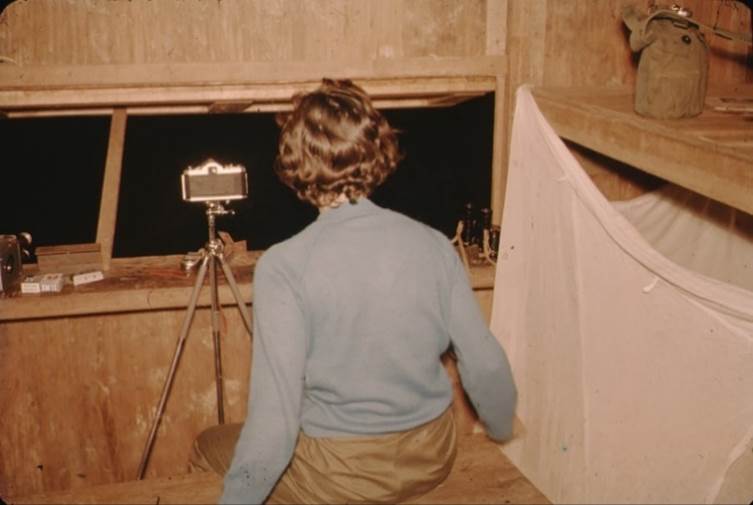

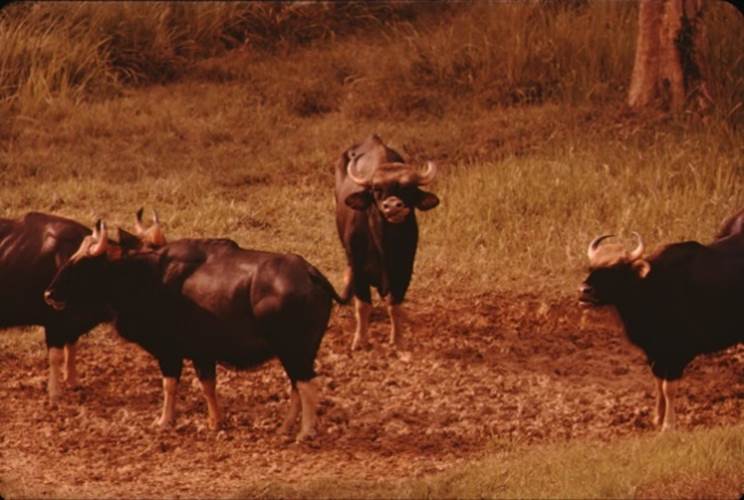
The deep jungle was alive with strange noises, and the many exotic bird songs which were a joy to listen to. One bird sounded like a laughing jackass. After a series of single “ha’s”, it would go off into peels of cackling mirth and obviously had a robust sense of humour! At last, when it was nearly dark, we heard loud bumps and grunts below the hide and saw a large black and white animal which quickly disappeared again in the undergrowth. Soon, there were many more similar noises, and in the pale moonlight we saw several tapir, which the Oxford Dictionary describes as “American mammals with flexible proboscis, allied to rhinoceros and pig”. Eventually the moon disappeared and into the jet blackness of the night the bumps and splashings went on. Occasionally we shone a torch onto a pair of shining and enquiring eyes. We'd hoped to see tiger, but I for one would have felt very dubious during the long walk back the following morning, if we had been sure they were in the vicinity! The guides are always unarmed except for a parang (curved Malay knife), as no hunting or shooting is permitted in the reserve. We heard monkeys in the trees as we headed back to the river, but saw nothing fiercer than a large shrew and two revolting leeches. By breakfast time, we were back at the rest house at Kuala Tahan, and never was food more welcome or more delicious. Apart from the seladang, sambar deer, tapia and shrew, we also saw a three foot long monitor lizard and a bear civet while we were in the National Park. We boated down the smaller Tahan River, which has outstandingly beautiful scenery. Willowy neram trees hang gracefully over the water. Dead and twisted tree trunks emerge from the silent pools in a sculptured, petrified forest, and the stillness is suddenly broken by glittering rapids, the waves and foam dancing in shafts of moonlight.

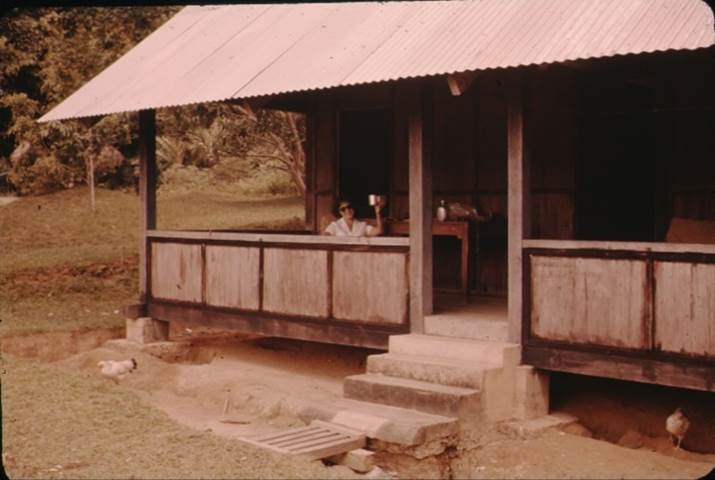
Comparatively few people visit the National Park and the Rest Houses often empty, and yet the Park has the grandeur and scenic beauty of a completely unspoiled country. So many people in other countries think of Malaya as a green hell where it rains continually. This is so far from the truth. Though it does rain quite a lot, the sun shines far more of the time. March to September are the best months for a visit to the National Park, as the rest of the year the rivers are swollen by the north east monsoon. We had glorious weather all the time for our four day trip. It is a perfect place for a healthy, out of door, adventurous kind of holiday. It is also a paradise for bird watching, fly fishing for giant pike, mountain climbing, swimming, and exploring limestone caves. Some of the most remote caves used by the indigenous people and elephants have rough drawings on the walls. The Reserve covers an area of 1,677 square miles and one can camp overnight in the outer areas of the park. The National Park is a place to be remembered.
XXVIII – Hong
Kong (1961)

Hong Kong, a kaleidoscope of the east and fitting climax to our two years in the vivid and exciting East. We flew from Singapore to Hong Kong by RAF Britannia. To our great delight, there had been spare seats on the aeroplane, which meant that we were able to indulge free of charge. This turned the occasion into a hilarious treat. We flew over South Vietnam, which looked deceptively peaceful, without trace of the struggle being fought in the hills.

Five hours after leaving Malaya, we started to circle over Hong Kong, and like a relief map, we saw the island below, with the mainland of Kowloon nearby. Kai Tak, the new airport where we were to land, jetted straight out into the sea for about a mile. So this was Hong Kong, and in reality it was even better than we expected. A glittering place, beautiful, exotic and slightly overwhelming. The shops were filled with almost too many good things. Everything from Siberian furs to pearls, jade, ivory and everything besides. All far cheaper than anywhere else in the world. A surfeit of beautiful things, often produced one feared by pathetically poor craftsman.
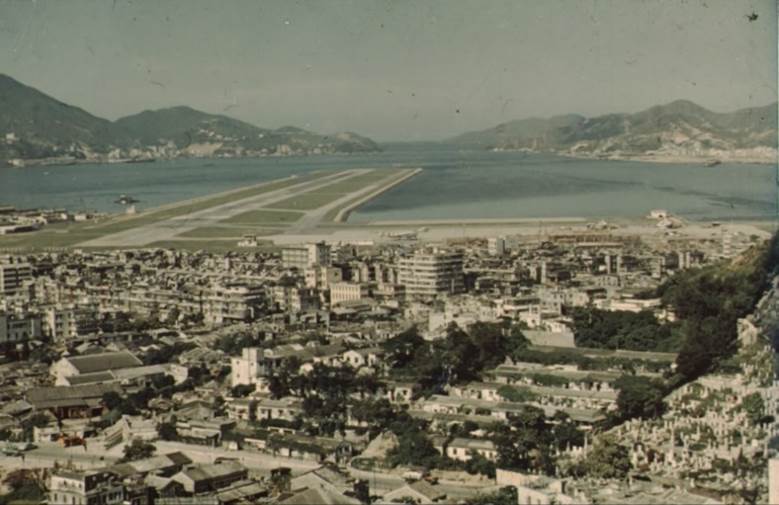
I had expected the views around the coast and from the peak to be outstanding, but was quite unprepared for the impact of the harbour by night. A myriad of lights on the island, dazzling shop signs on the Wanchai waterfront backed by millions of tiny lights sparkling on the hills and up to the peak. On the wide expanse of inky water, there were junks, sampans, ocean liners, naval vessels, and six or seven brightly lit ferries carrying passengers speedily to and fro. These ferries have a lower and upper deck and are just like mississippi steamers. Rio de Janeiro is supposed to possess the only other harbour in the world that can compare with the panorama and the magical fantasy of Hong Kong. Hong Kong is one of the world’s busiest ports and the very existence of the Colony depends on the harbour, since 75% of the total revenue is derived from imports and exports.
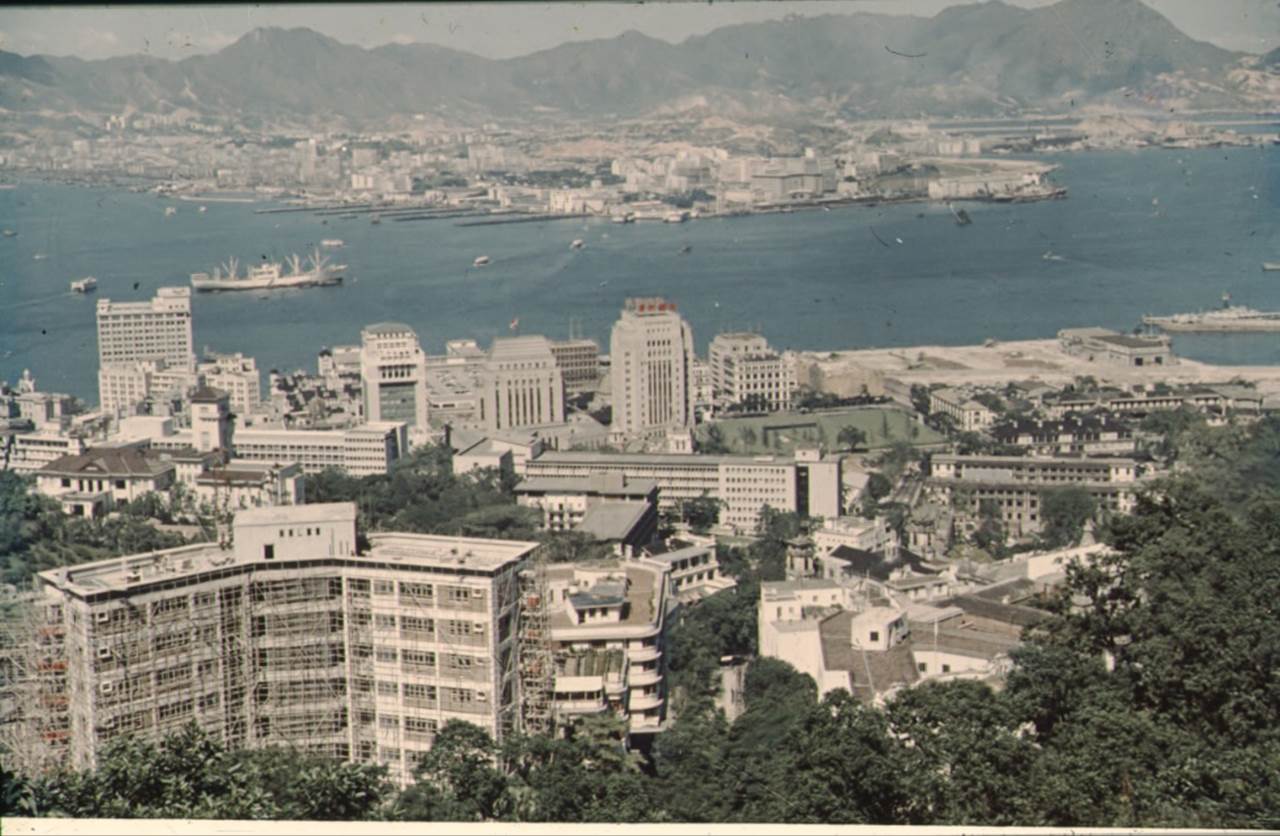
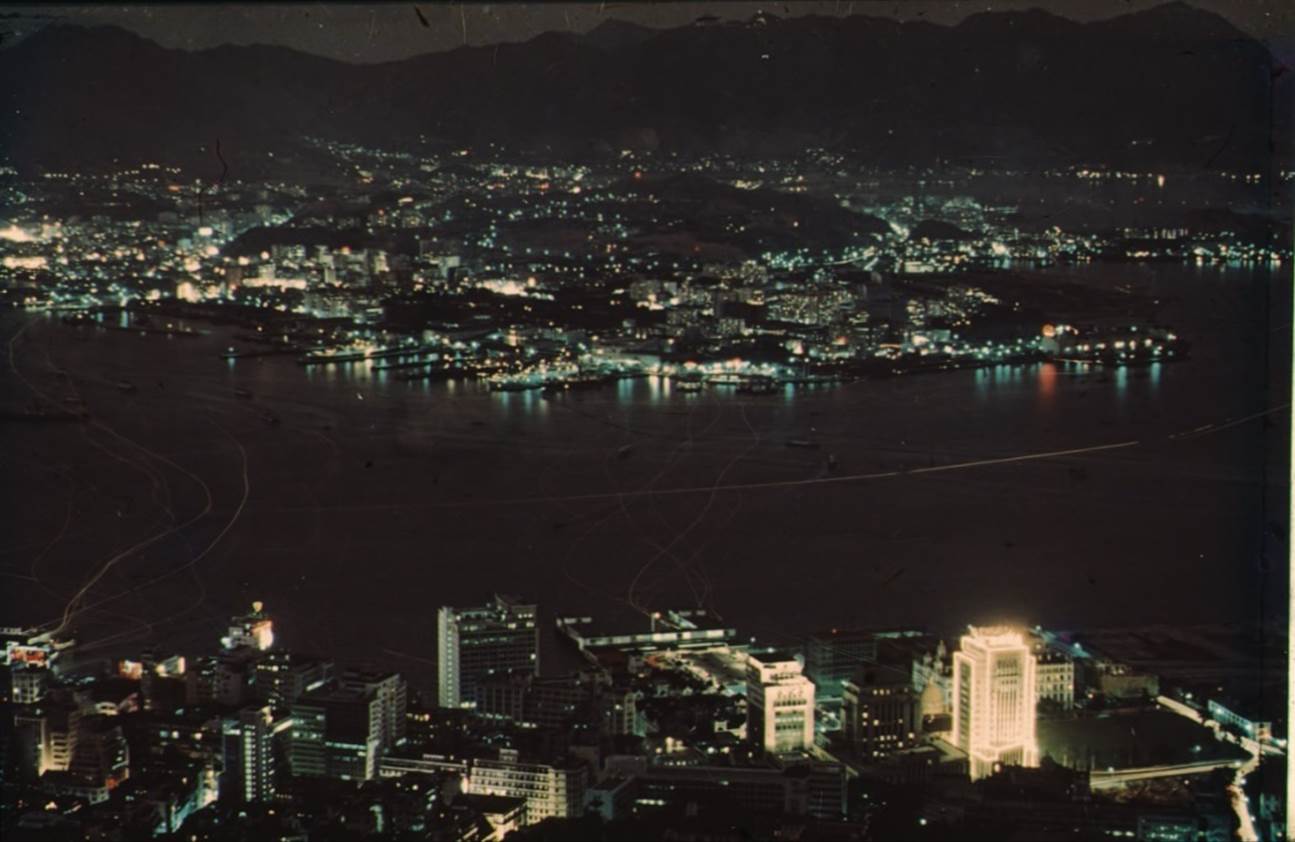
The island of Hong Kong was ceded to Great Britain in by China in 1841, Kowloon Peninsula in 1860, and the new territories in 1898 for a period of 99 years. Although they cover an area of about 416 square miles, at the moment, China finds Hong Kong an invaluable trading outlet. But what will happen in 1997 remains an enigma. There are is a severe shortage of food in the Colony, and a constant supply of fresh water is pumped in from Red China. It is rather frightening to think how easily the tap could be turned off. The total population, represented by about 50 different nationalities, is estimated at three and a quarter million, of which 99% are Chinese, speaking, Cantonese, Shanghai and Mandarin dialects. English is generally spoken and understood.
There has been resettlement of the many refugees from Red China. Many still live in pathetic shacks on the hillside, but large numbers have been accommodated in huge blocks of one roomed flats. Each flat may contain some three or four families who occupy it in shifts. Originally allotted to one family, the occupants soon shared it with other less fortunate relatives and friends. Most of the Chinese live in tenements in early 19th century conditions, with sometimes as many as twenty living in one room. Many people have no home at all, but just sleep at their place of work or on a bed set up on the pavement. They are generally extraordinarily cheerful, but having some idea of the conditions under which the greater part of the population live, one can understand why wealth seems to be one of the great ambitions in life.
Now back, rather guiltily, to the visitors’ view of Hong Kong, and up the Peak in the famous tram to look down on one of the most wonderful views in the world, on a warm summer’s day in December.



We drove to the New Territories where the old Chinese agrarian Society still prevails in all its simplicity. Agriculture and fishing remain the main occupations, and the chief crop is rice. Seeing the farmers patiently toiling on their land under the most primitive conditions, I was reminded again of Pearl Buck’s wonderful book The Good Earth, and having read it, I felt I had some little insight into their lives. We visited Castle Peak and the ancient town of Un Long, where the traditional practises of barter exchange continues, and then stopped at the old walled city of Kam Tin. Inside were narrow alleys, primitive living conditions (a pig sty in one room) and throngs of ragged children. Then the border at Lok Ma Chau and the road ending in a rough track as we came to the Chinese frontier. On a hill above there is a police station with a Union Jack flying from its roof and from where you can see the Shum Chun River (the Hong Kong borderline) across which many refugees have fled. In the distance we could see quite a large town in Red China.
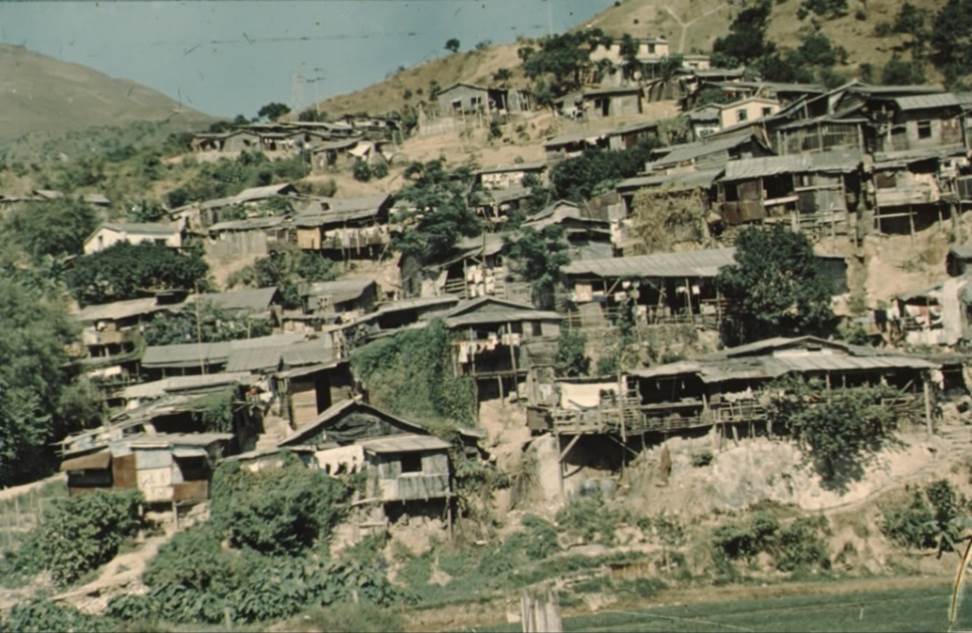
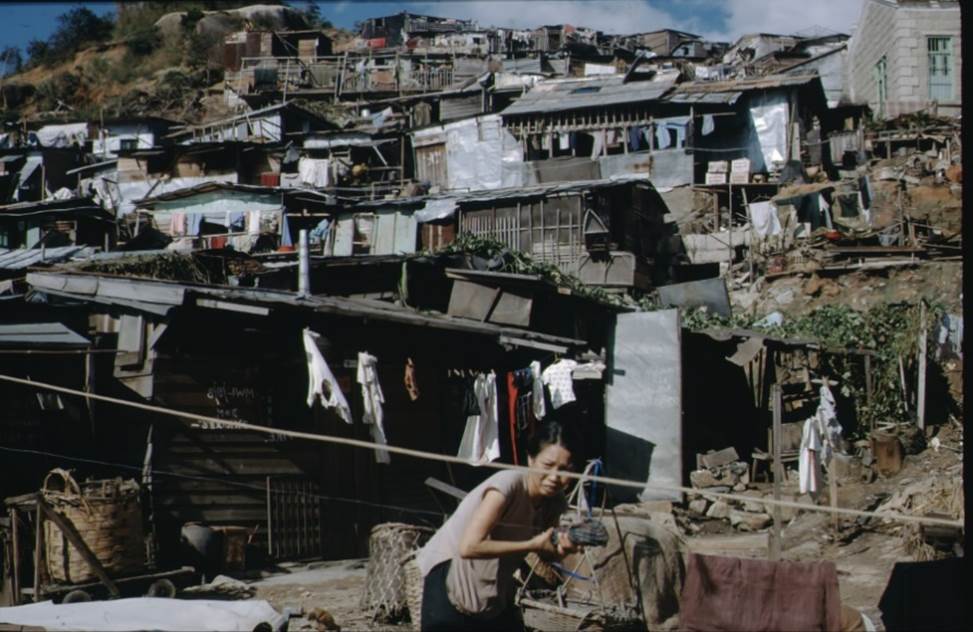
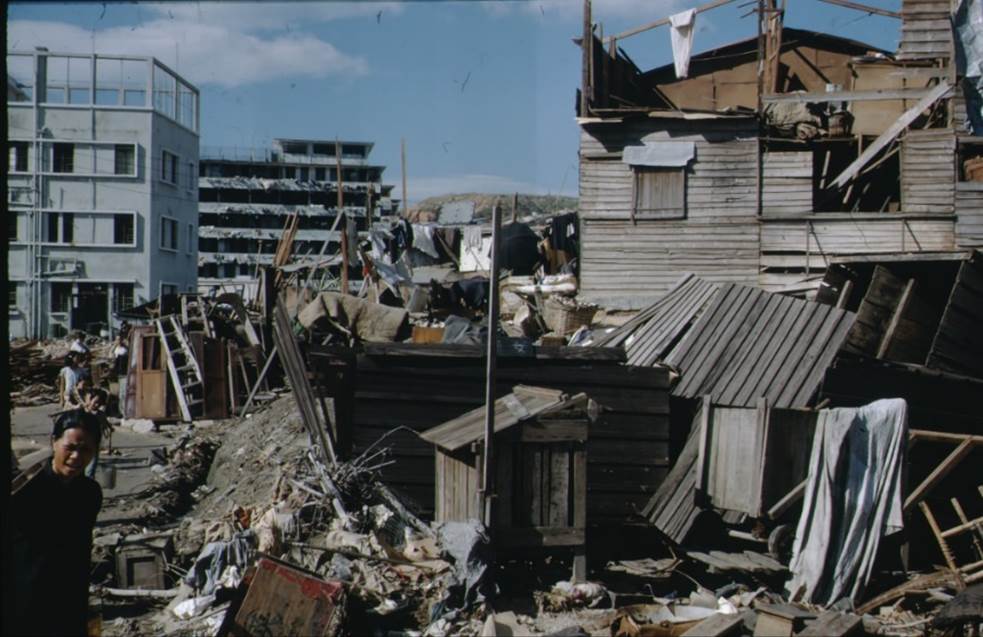





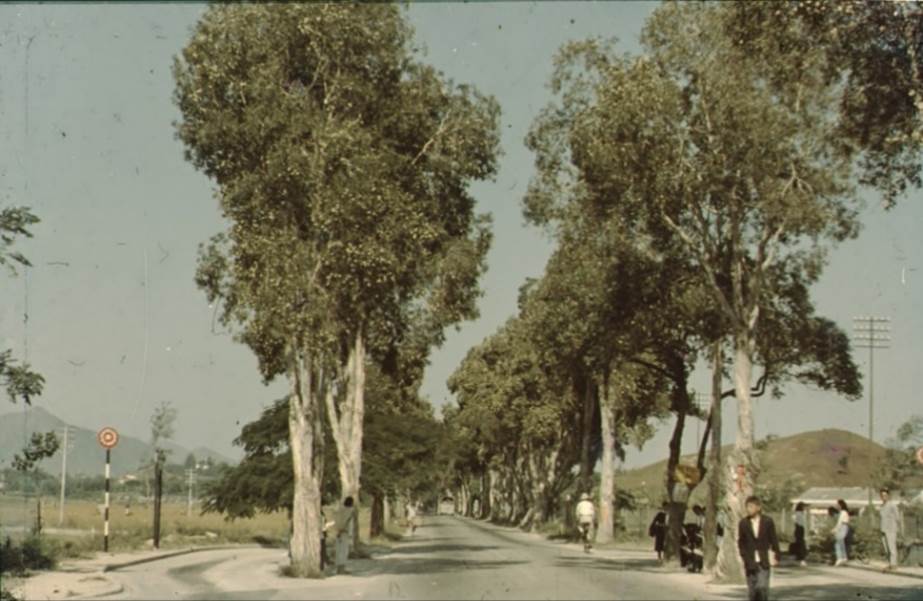
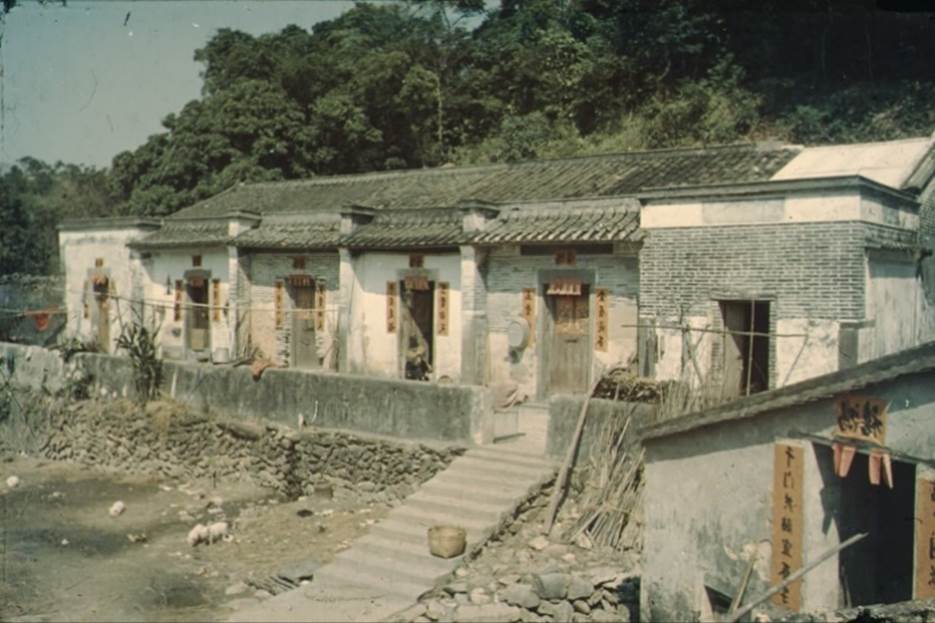
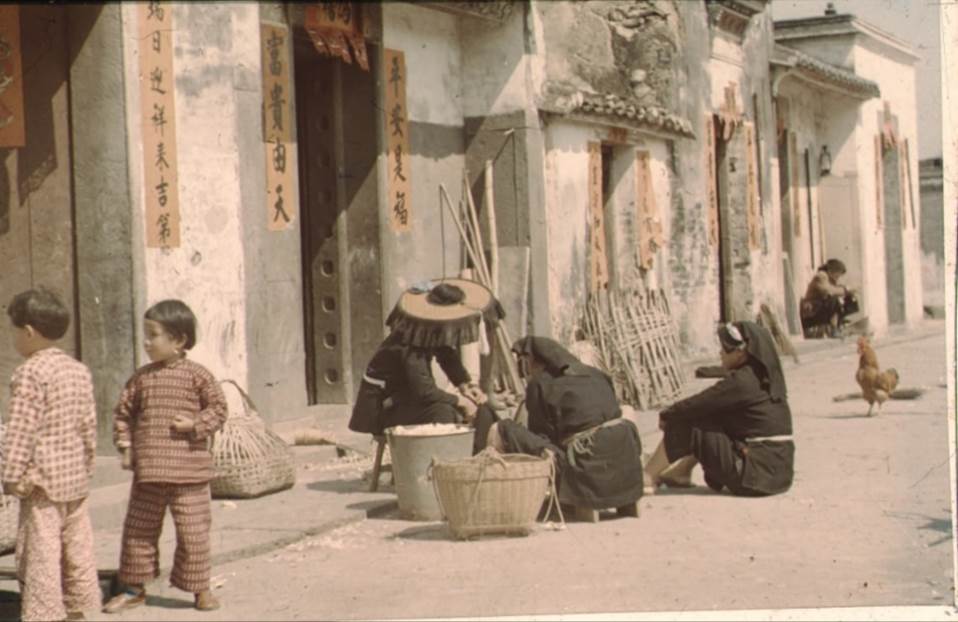
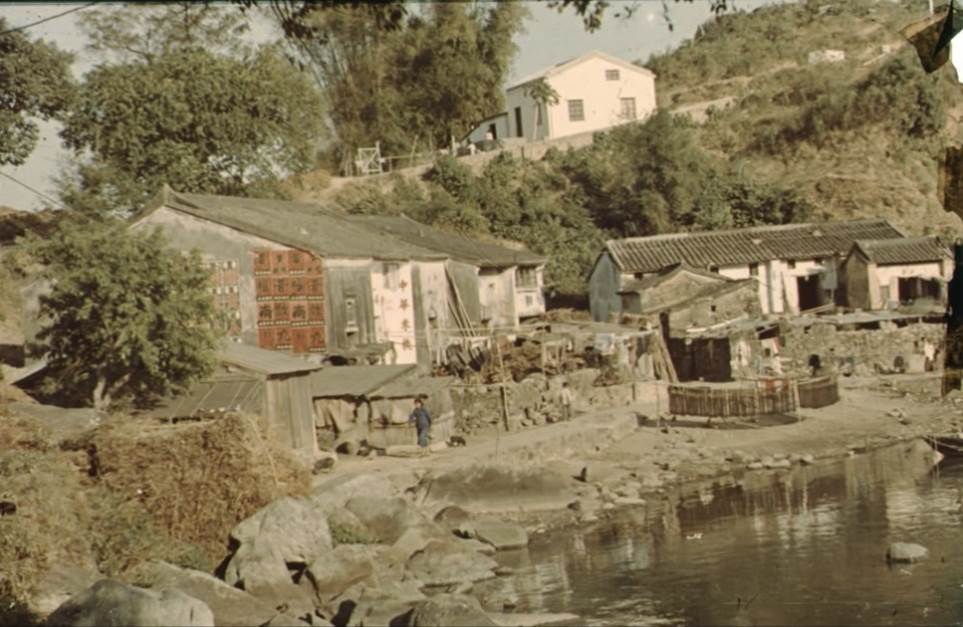


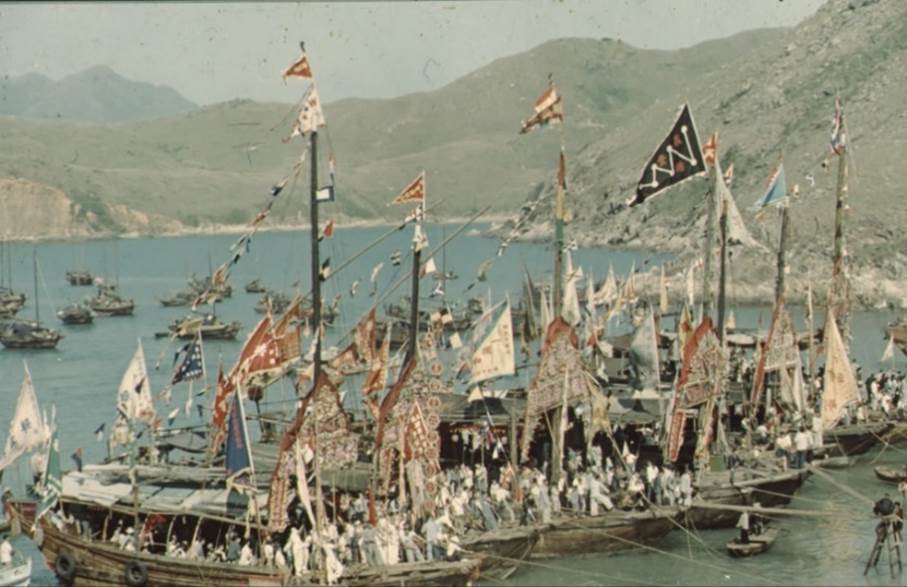

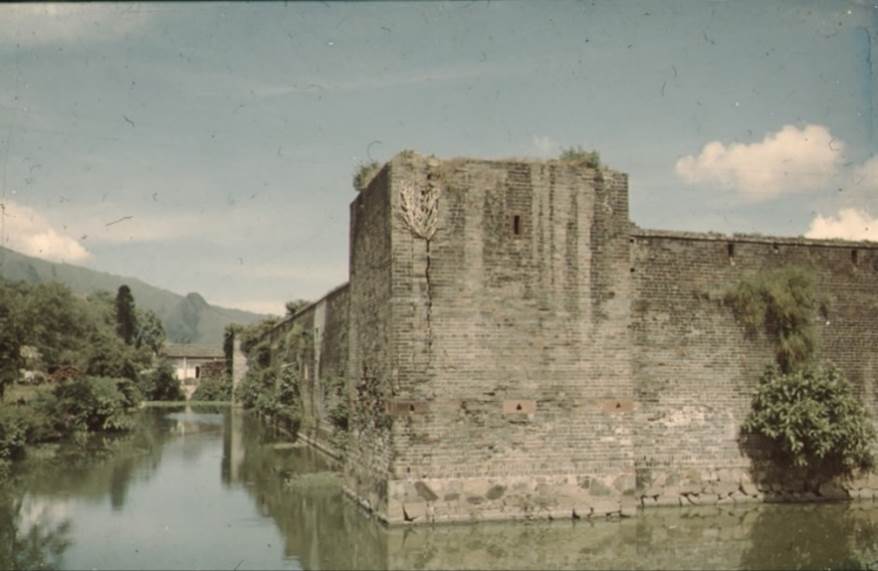
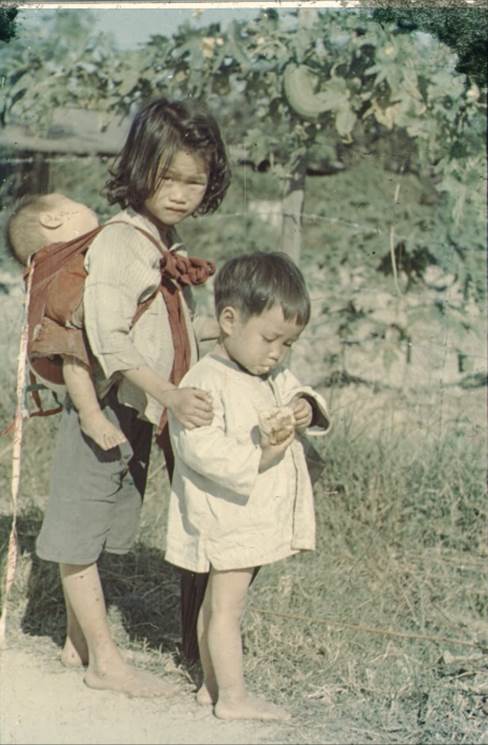
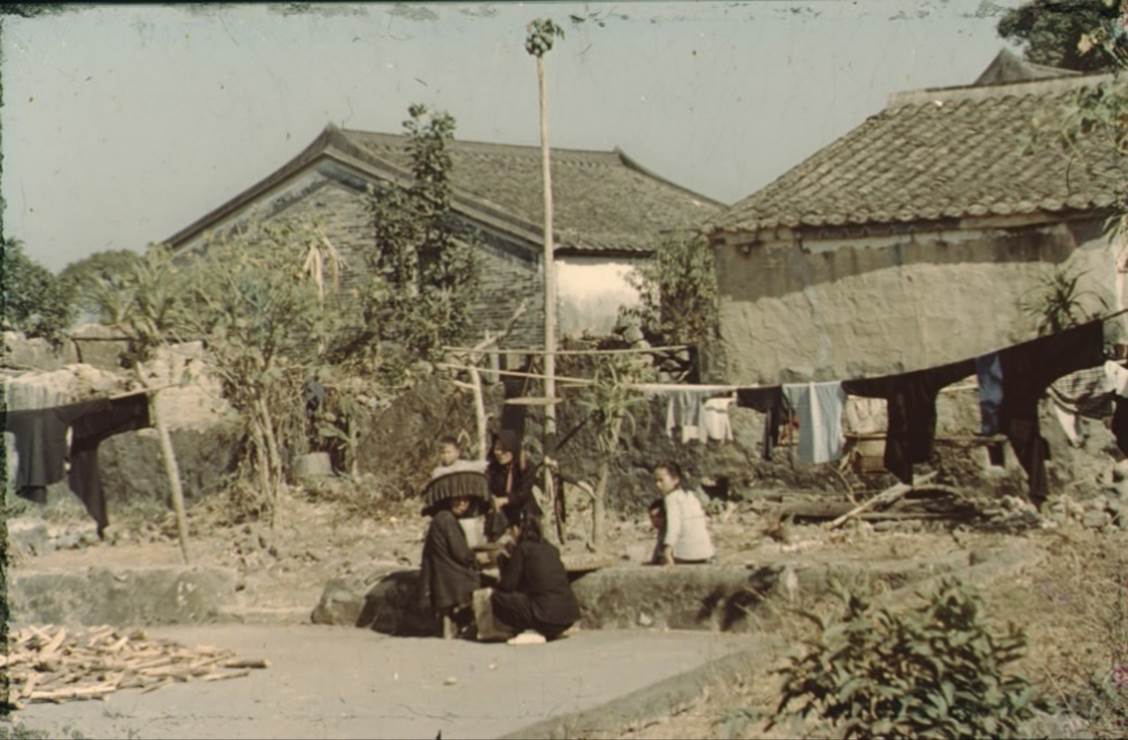
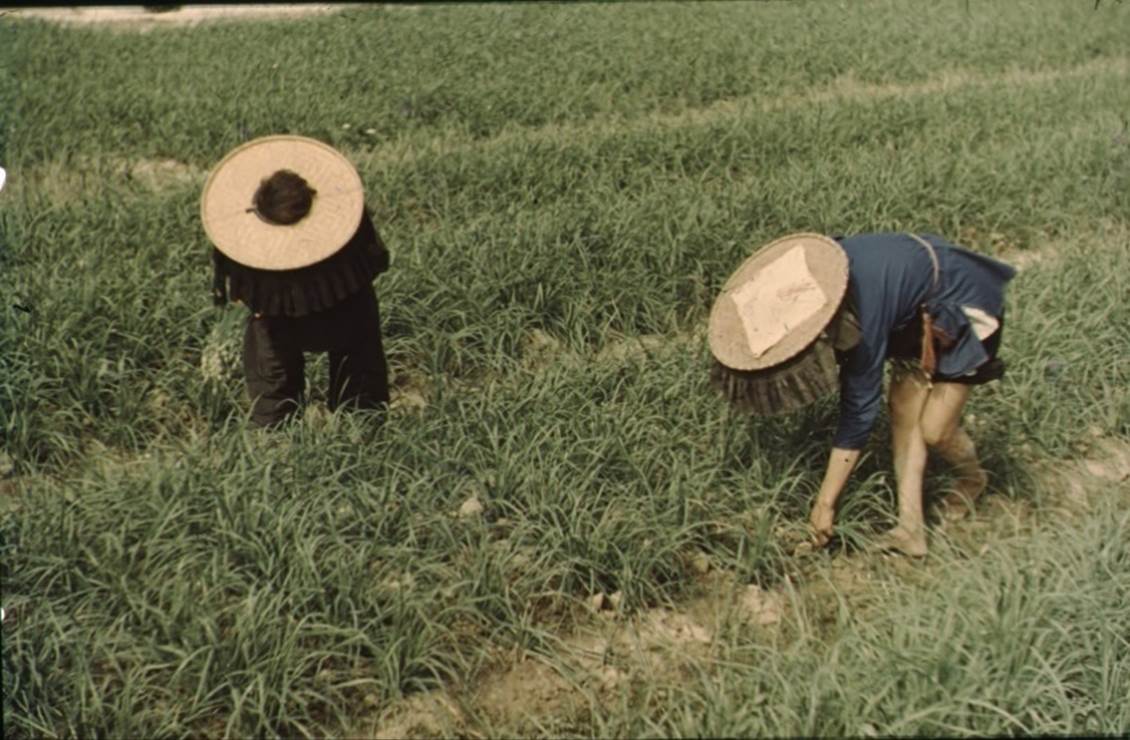
One evening, we ate in a sukki yaki room in a large Japanese hotel. We sat on the floor at a low table while a pretty Japanese girl in kimono and obi sat and served us. She cooked the main course very gracefully at the table, to the accompaniment of a background of soft Japanese music. The room itself was divided, with a partition down the middle between two tables, and the walls and floor were covered with bamboo matting. The simplified and restful atmosphere of Japan, and the background of the tea House and the geisha. I long to visit Japan, though it is undoubtedly a man's country. As we went out, I sipped my bare feet into my shoes, which were waiting by the door, but as soon as Martin attempted to put his on, two damsels appeared from nowhere with a huge shoe horn, and both helped him into his! A man in Japan is simply not allowed to do anything for himself. We visited several night spots, including one on the 17th floor of a new skyscraper hotel in Kowloon, overlooking the harbour. It was a luxurious setting, a huge sheet glass window and a character called ‘Cino’ at the piano singing witty songs about the British.
Kowloon is a very good shopping centre, but Hong Kong has some particularly fascinating side streets. Many of these have steep steps up them, with stalls on either side and brightly coloured banner shop signs. Wandering around, we found many shops selling exquisite jade and ivory, including the most intricately carved sets of chessmen and endless rows of tailor shops offering a twenty four hour service. Everywhere there were rows of waiting men with rickshaws, which I could never bear to ride in. The far more humane trishaws do not seem to even exist in Hong Kong, though in other parts of the East trishaws have almost entirely replaced the rickshaw. We walked along the Wanchai waterfront, the blue light area, to see the Suzie Wong Hotel. The Nam Kok of Richard Mason’s book is, in fact, the Luk Kwok Hotel, very conveniently situated by the American Fleet club, and the original Susie is apparently still there.
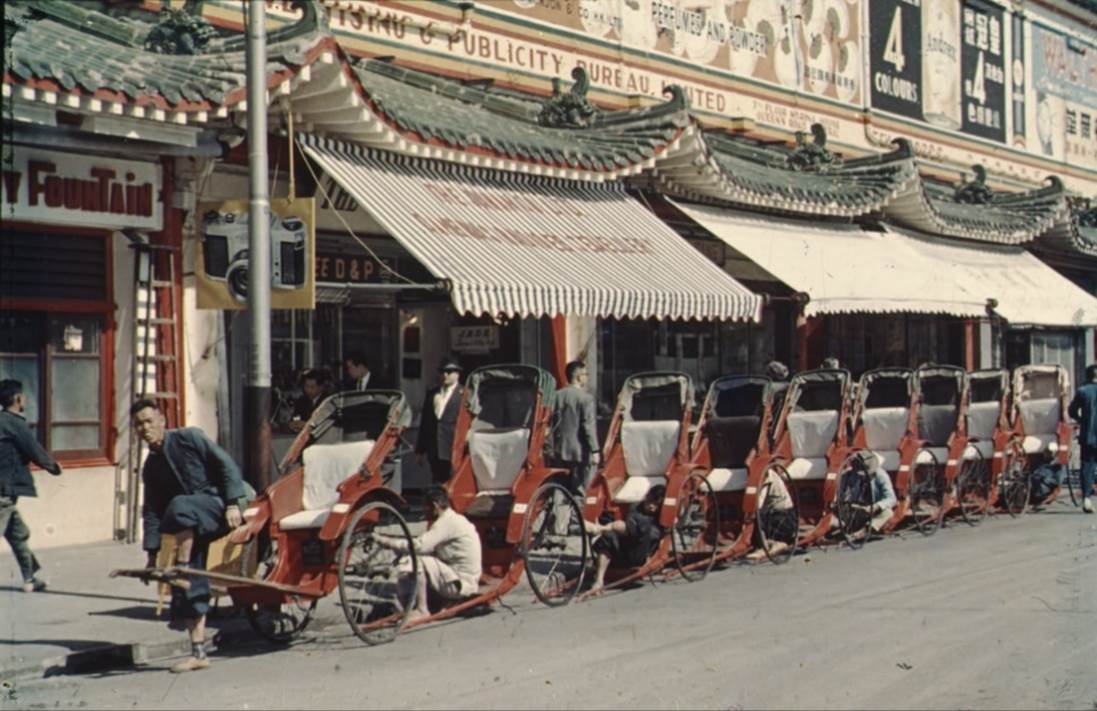
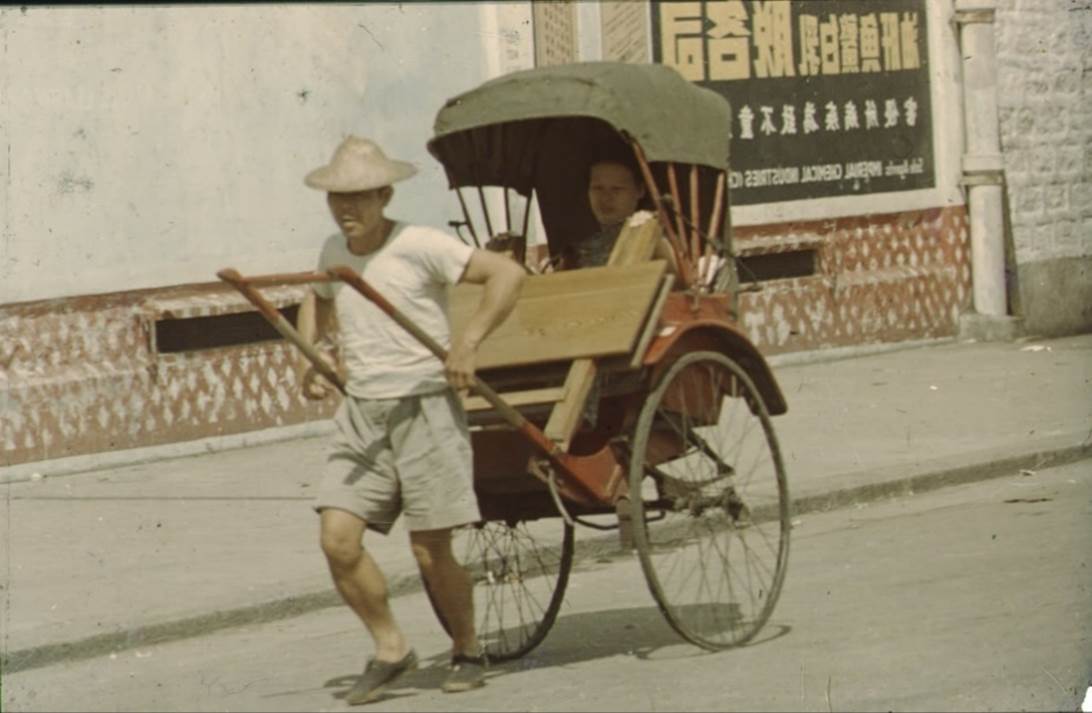
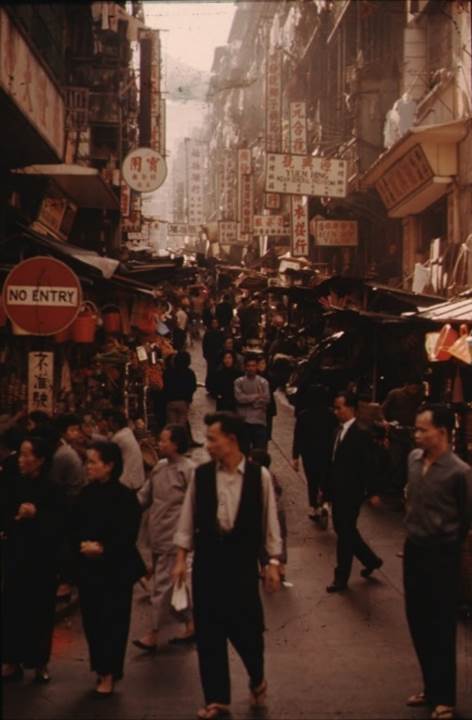
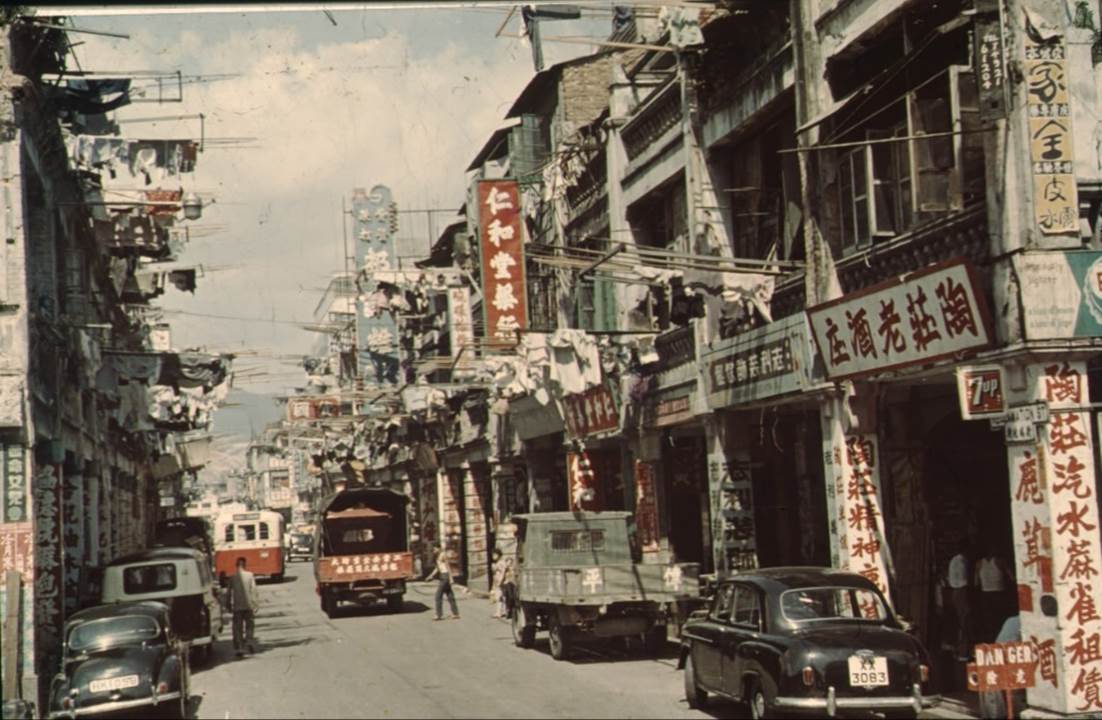
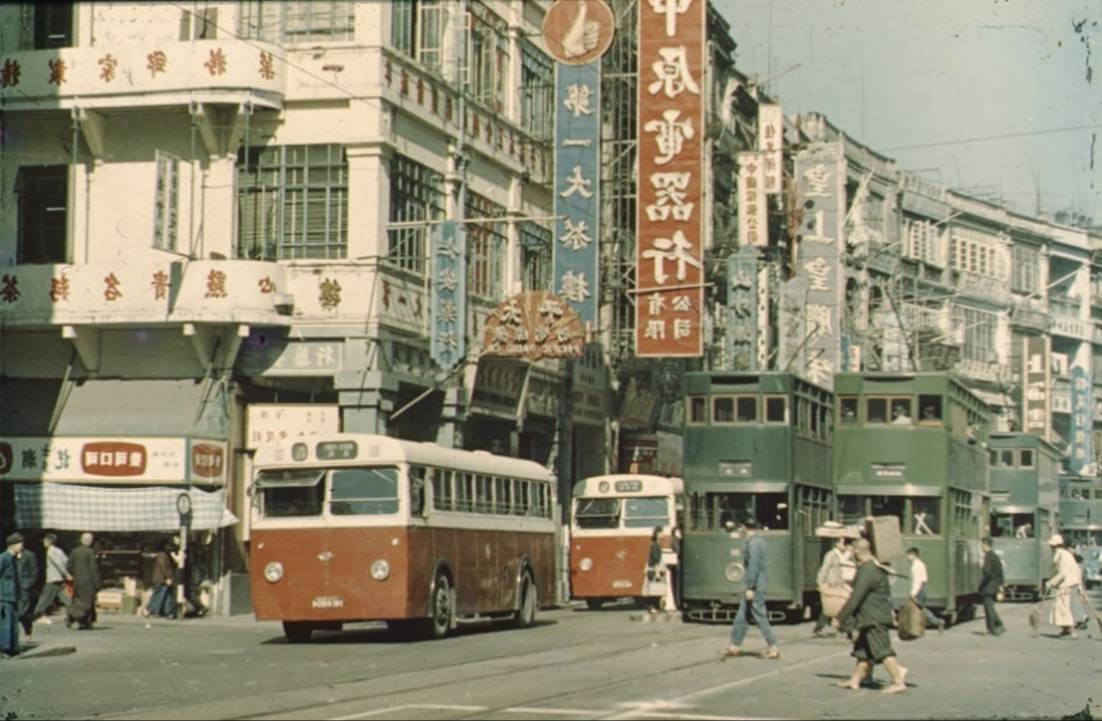
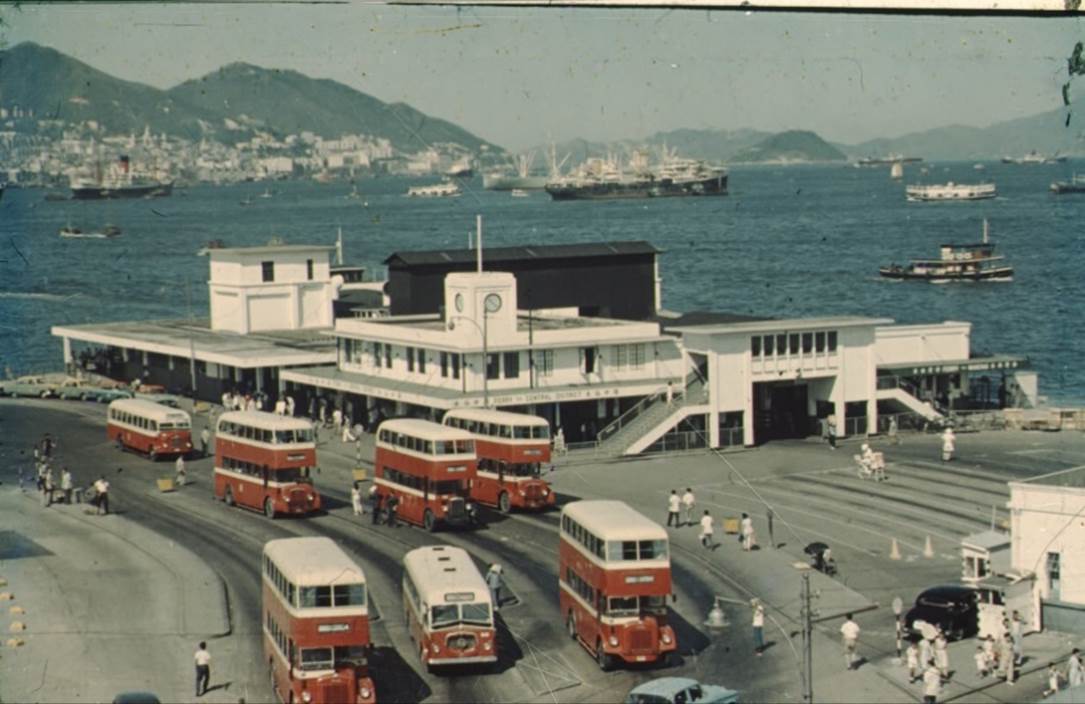
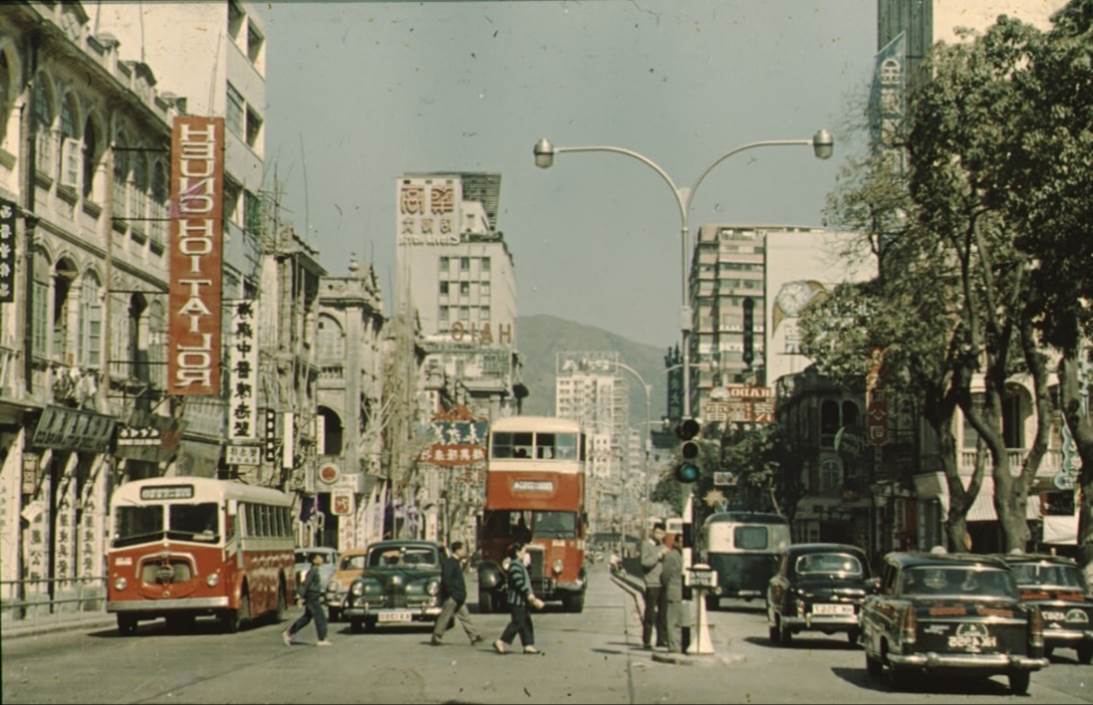
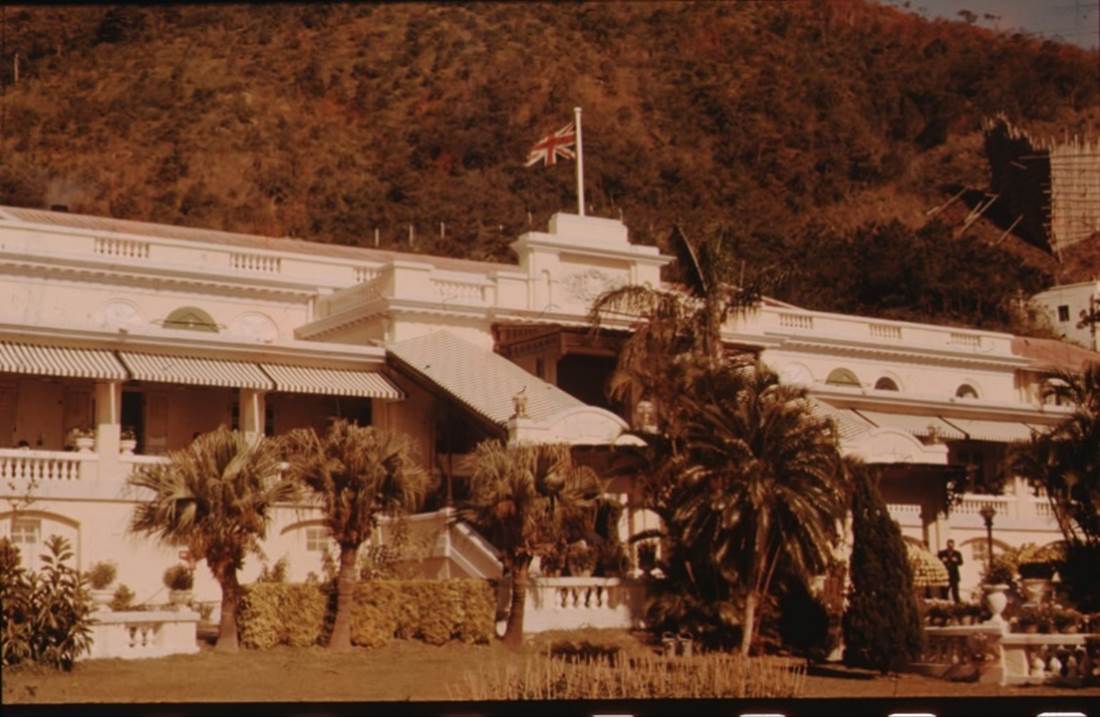
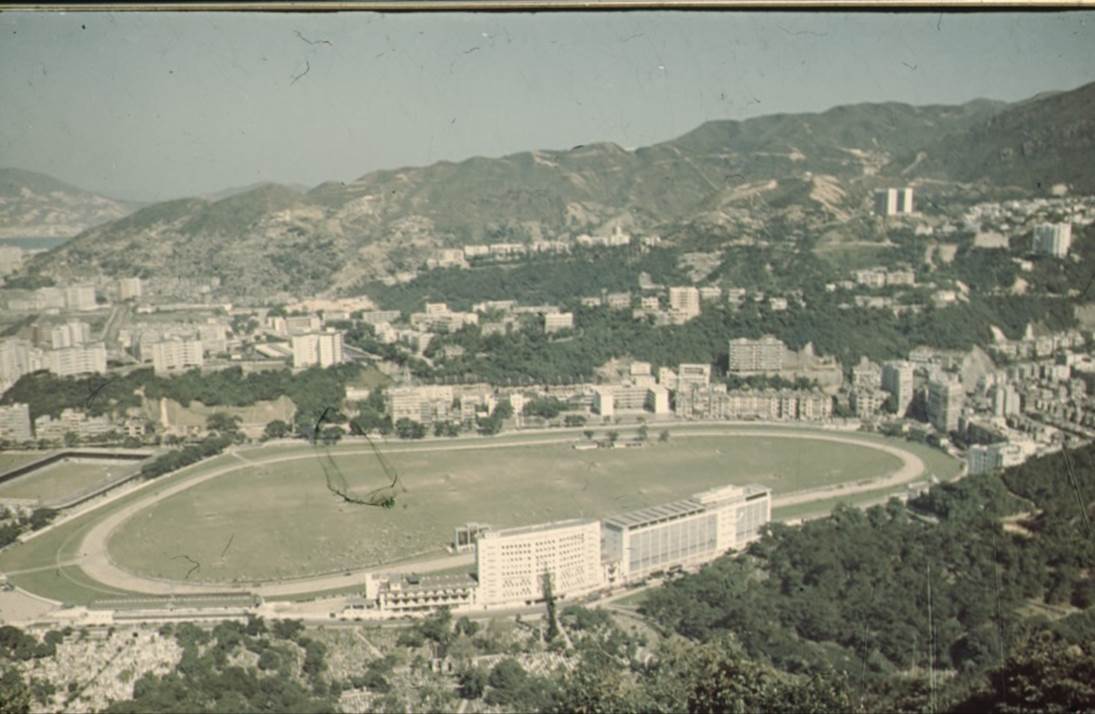
We were in Hong Kong for five days, and on the Sunday we drove to the Repulse Bay on the other side of the island. We lunched at the luxurious Repulse Bay Hotel, which seemed to be full of tourists, and worked our way through a most resplendent help yourself buffet. I made a terrible pig of myself (salad bowl at Lyons) taking one of everything without noticing, until my plate was loaded. Martin was most ashamed as he sat and watched me devouring the lot. Afterwards we walked, or rather staggered, down to the sandy beach and watched a few energetic people water skiing and bathing. The climate in Hong Kong in December is perfect, sunny but never hot, just like a warm summer's day in England.
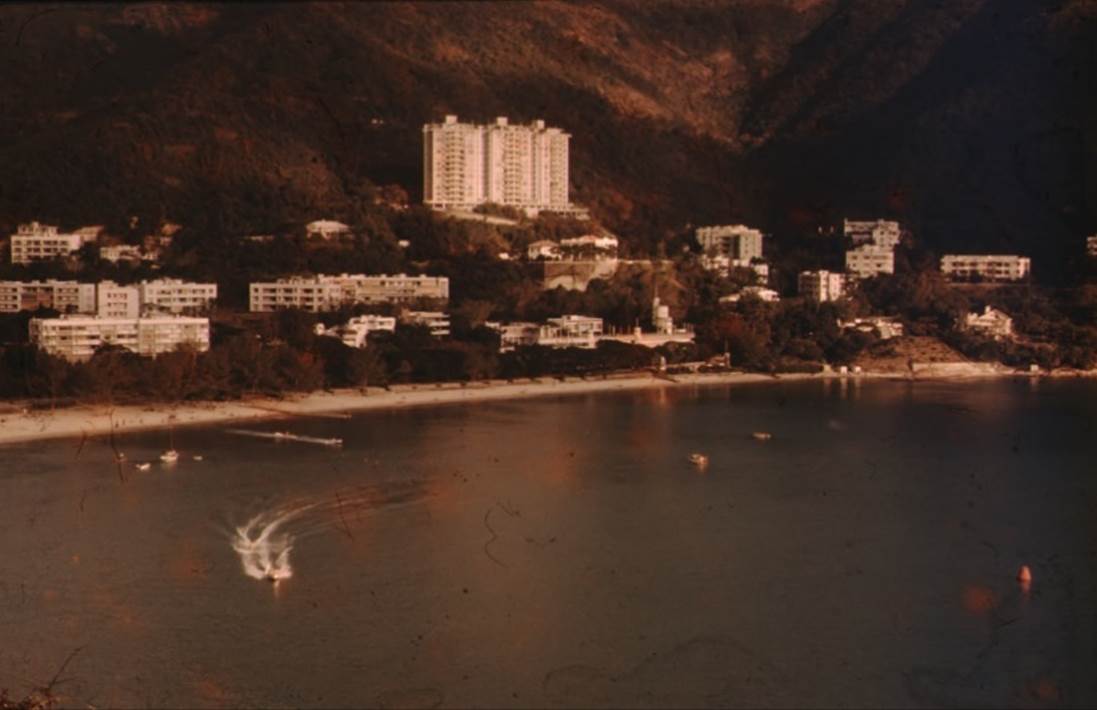
We visited Aberdeen, a huge fishing village where something like 100,000 Chinese live in junks and sampans, and make a living from the sea. We were rowed over to one of the huge illuminated floating restaurants by a couple of smiling sampang girls in coolie hats. The sampan was comfortably equipped with chairs, and matting under our feet. The restaurants were again reminiscent of a huge mississippi steamer, though the one we went to was in fact a replica of the marble boat in the summer palace in Peking. On arrival, we were taken to see huge tanks of live fish, which included garoupa, parrot fish, prawns, lobsters and crabs, and we were asked to choose our victims. Very cruel, with reproachful, fishy eyes gazing at you, and after some thought we decided on the set menu. The fish was cooked in Cantonese style, a cuisine famous for its delicate flavours. It was delicious, and at last we found ourselves becoming quite adept with chopsticks.
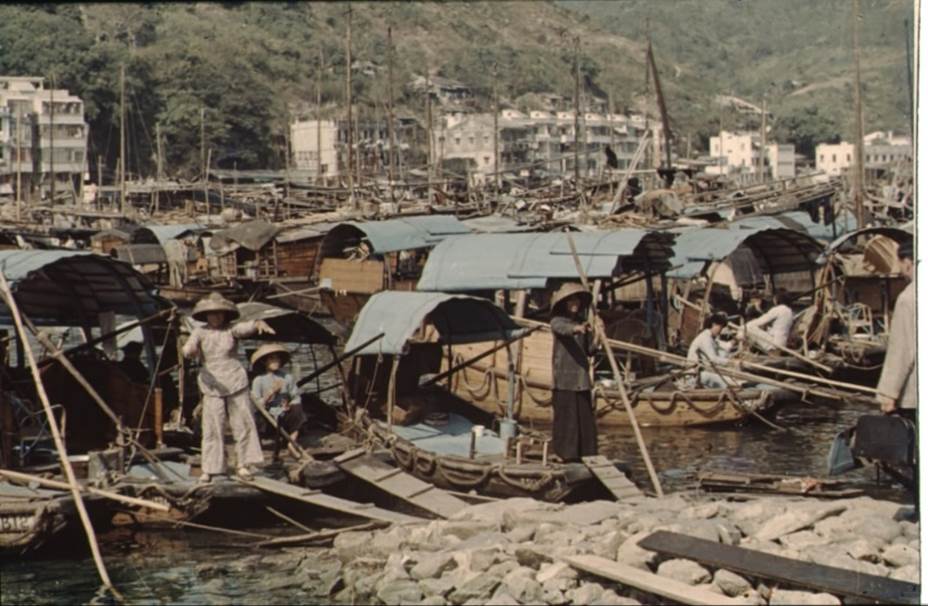
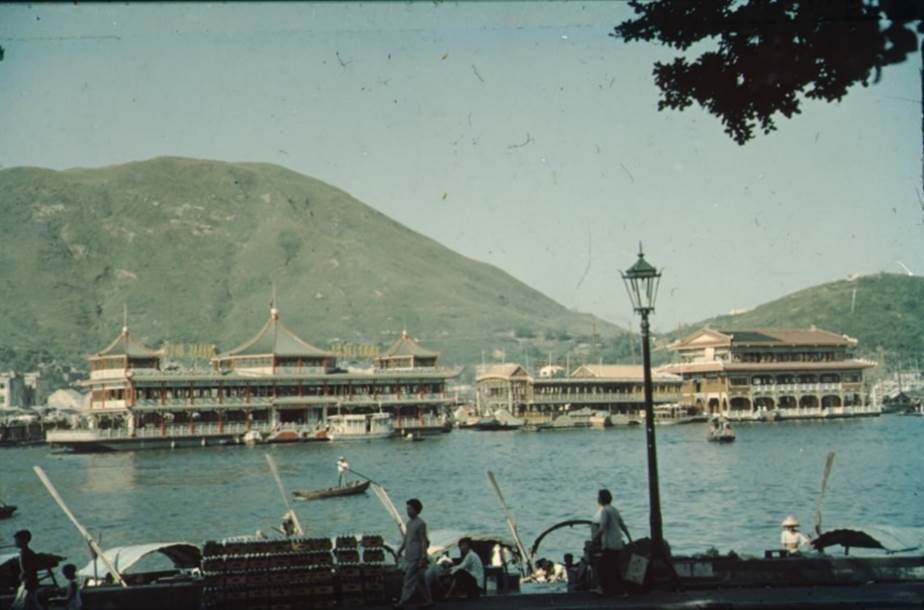
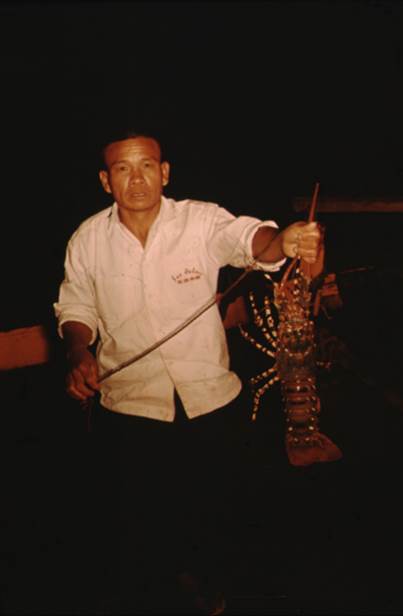
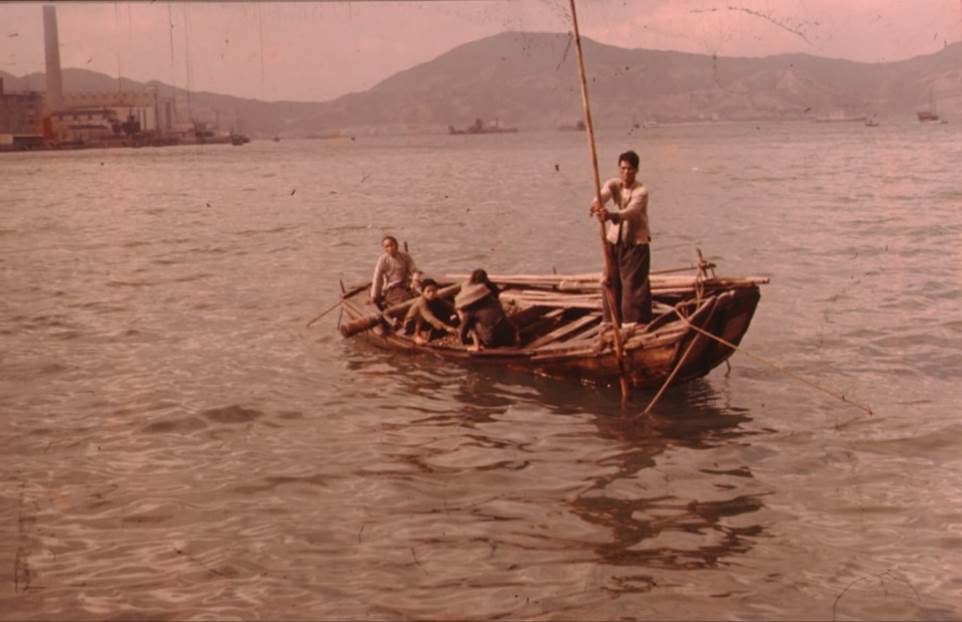
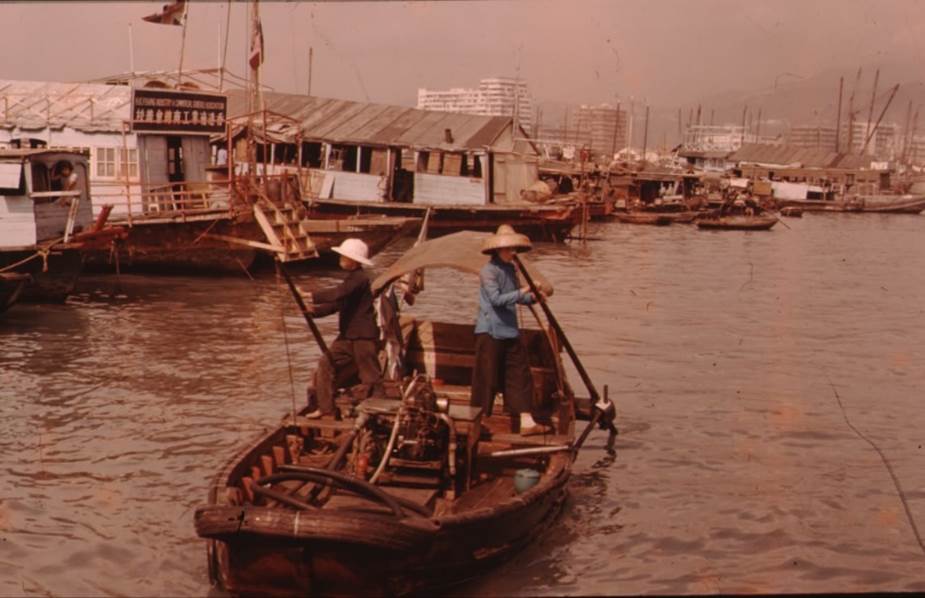
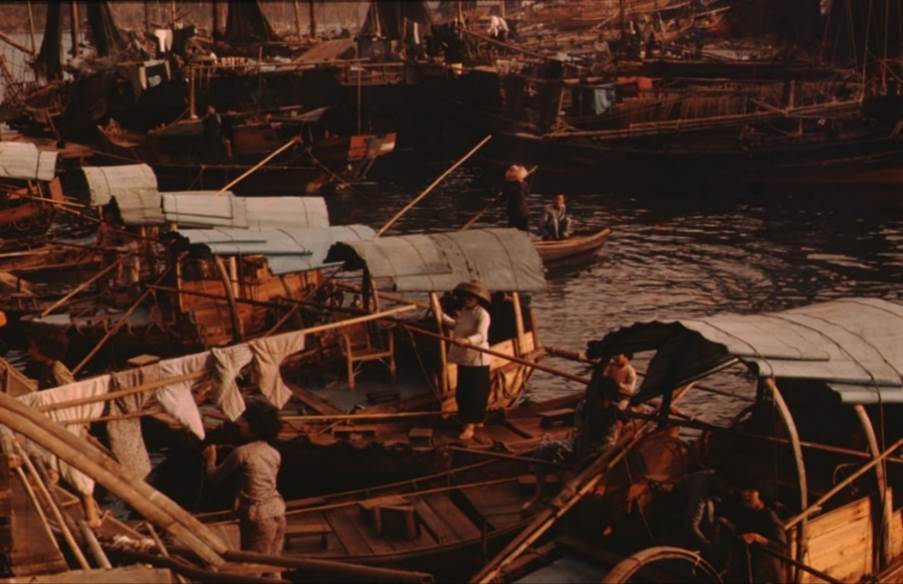
Princess Alexandria had visited the same restaurant two or three weeks earlier, and her photograph already graced the entrance. We saw a film of her visit to Hong Kong while we were there and it was intriguing to recognise so many of the places she had seen. There are several fishing villages, but Aberdeen is the largest, and the Colony’s floating population numbers some 200,000 in all. On one occasion we toured the harbour in a junk and floated slowly through two of the villages, and could well believe that the boat people are among the happiest and most contented in Hong Kong. Many of them spend their whole lives on the water and are descended from generations of sampan dwellers.
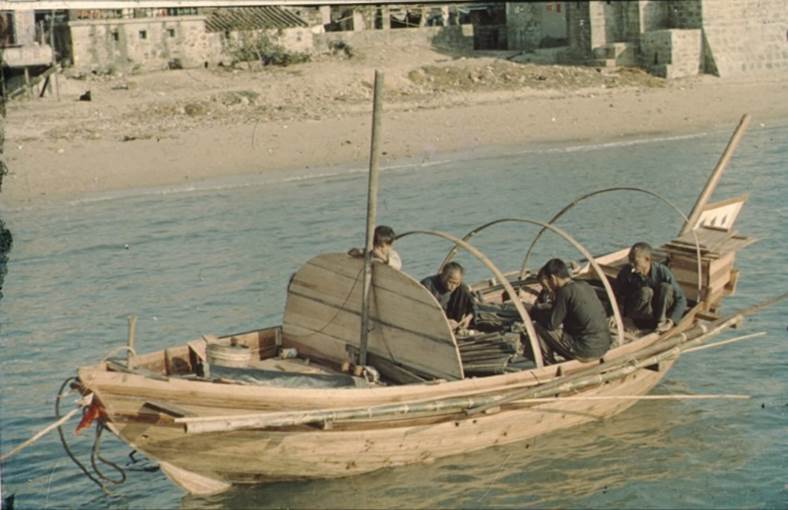
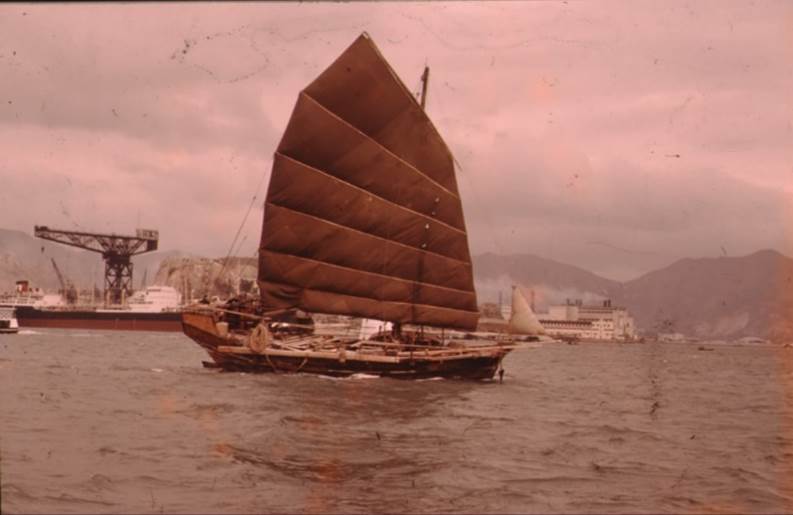
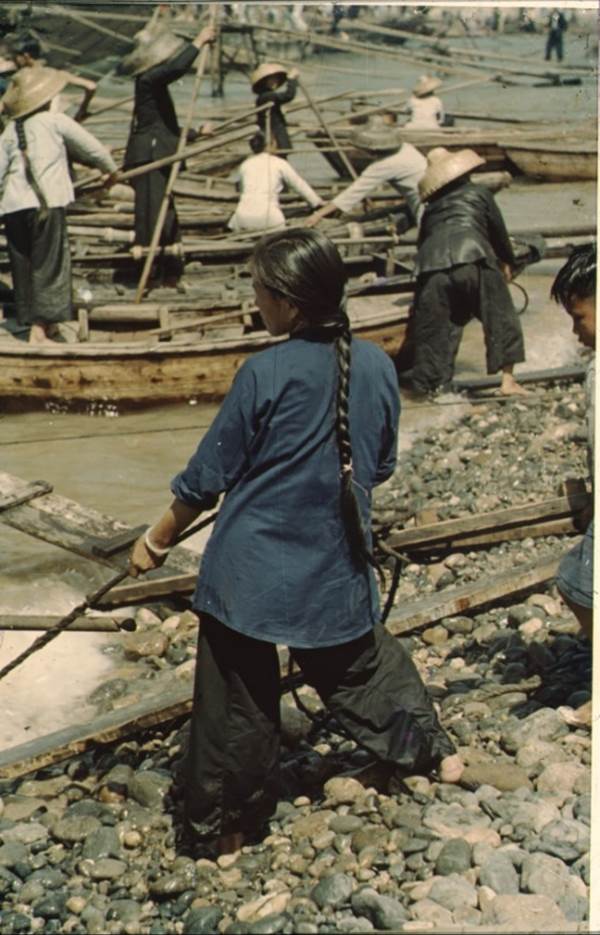
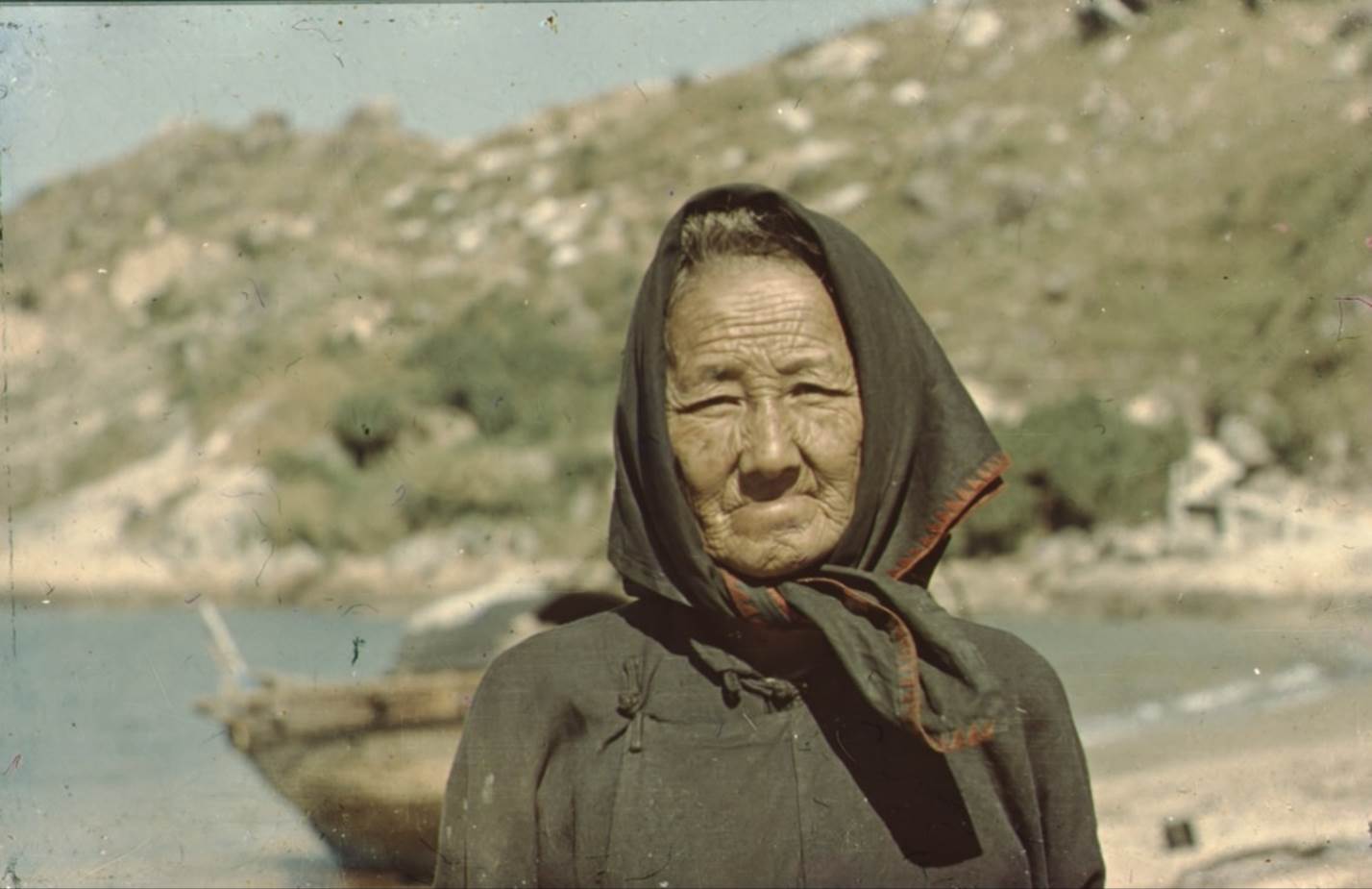
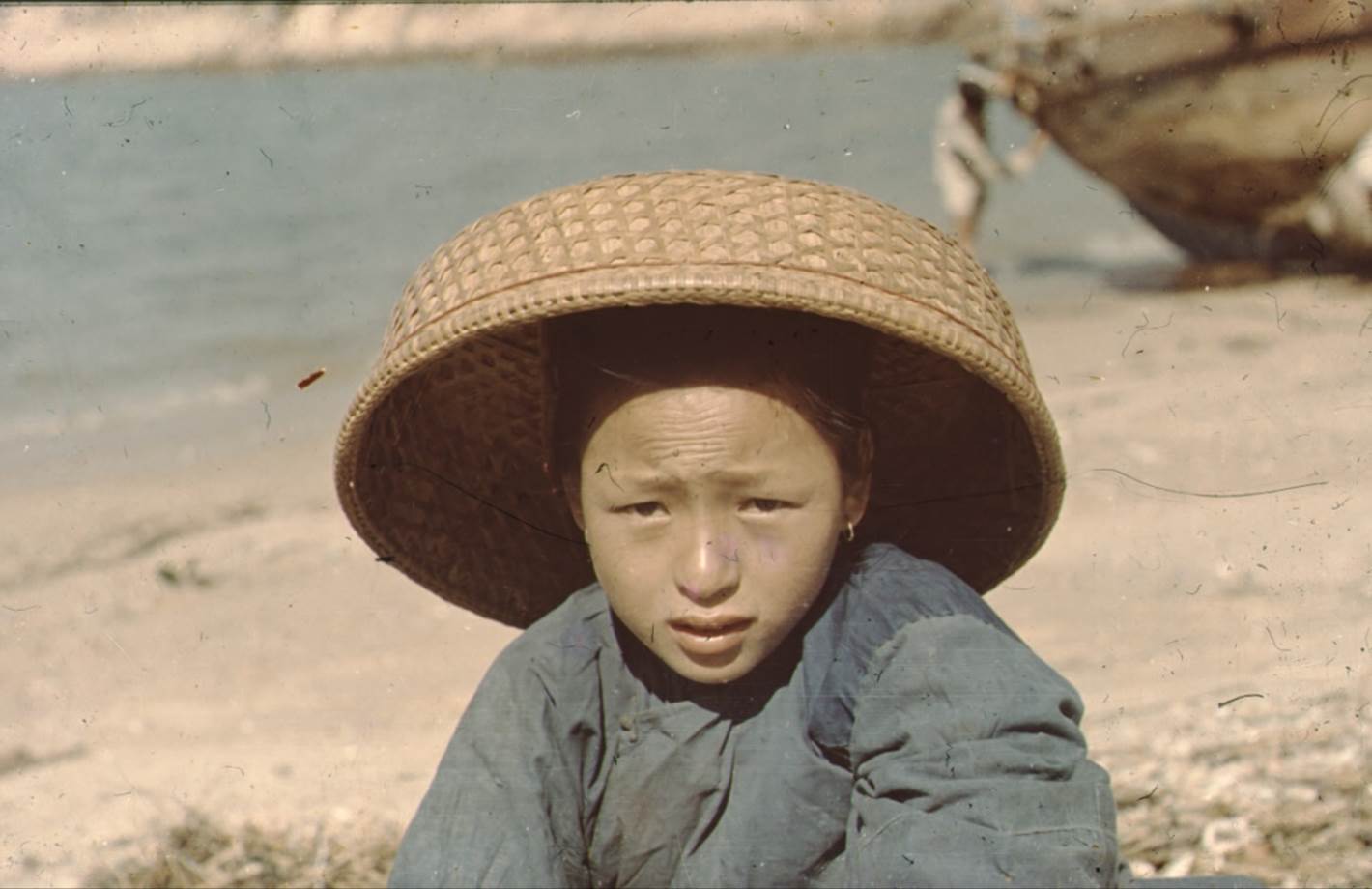
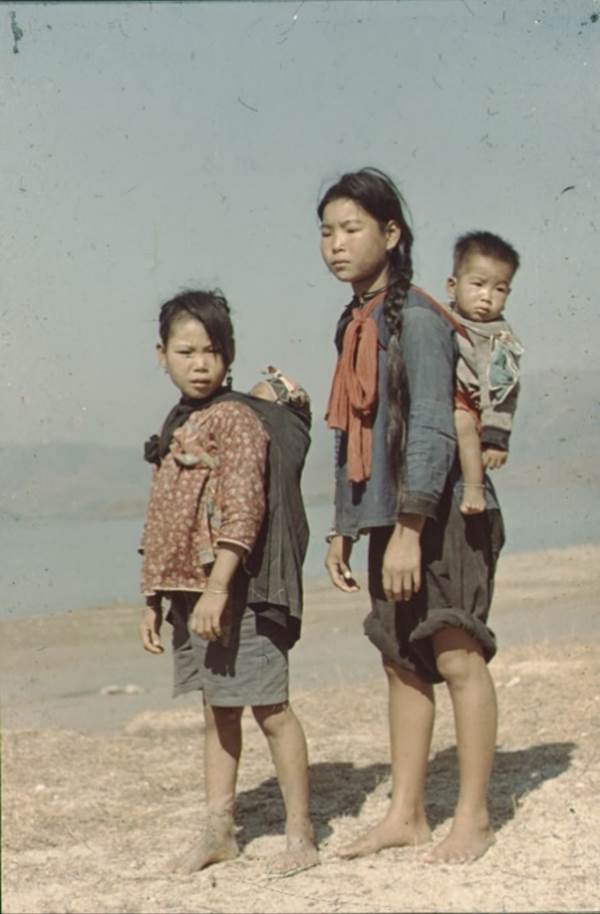
All too soon, it was time to leave Hong Kong, and a month later, we said another sad farewell to Malaya and started our long trip home. But that itself is another story...
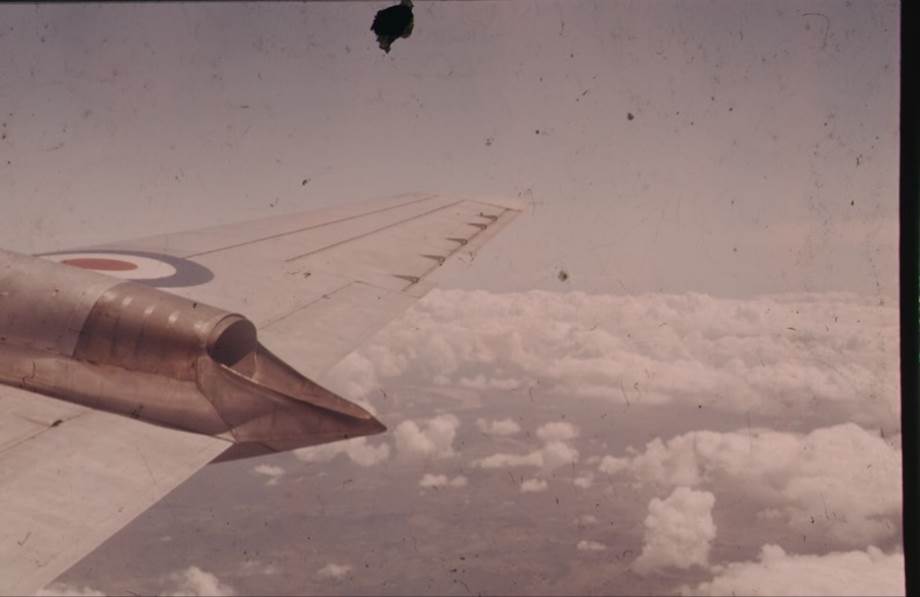
XXVIV – The Journey Home overland (January to March 1962)
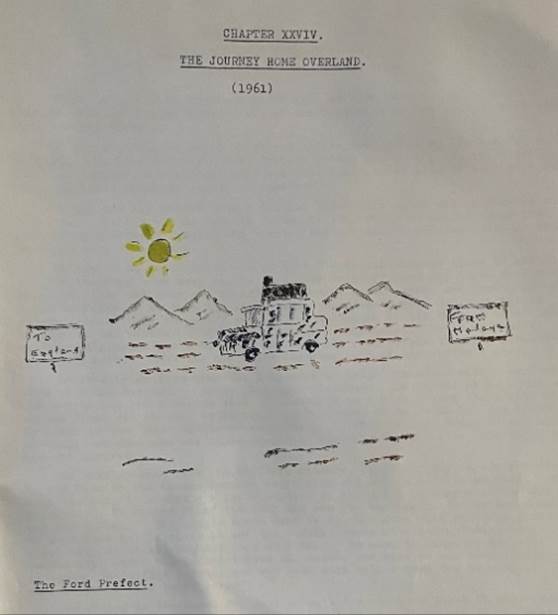
Anne’s chapter on the Journey home overland from Malaya via Burma, India, Nepal, Pakistan, Iran, Turkey, Greece, Austria, Germany and Belgium can be found on a separate page called “The Journey”.
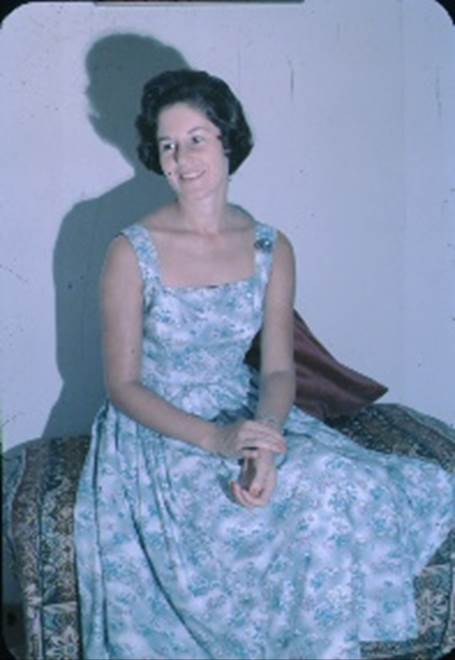
Anne Farndale